Paul van Yperen's Blog, page 105
November 18, 2022
Three silent Swedish films starring Lars Hanson: Ett faerligt frieri (1919), Sangen om den elrodan blomman (1919) and Erotikon (1920)
Lars Hanson (1886-1965) was the most successful star of the silent Swedish cinema. He was the virile and handsome leading man in several masterpieces by Victor Sjöström and Mauritz Stiller. When both directors moved to the U.S.A., Hanson did too and he starred in such Hollywood classics as The Wind opposite Lillian Gish. But for this post we focus on three of his Swedish films, Ett farligt frieri/A Dangerous Proposal/A Dangerous Wooing (Rune Carlsten, 1919), Sången om den eldröda blomman/Flame of Life (Mauritz Stiller, 1919) and Erotikon/Bounds That Chafe (Mauritz Stiller, 1920).
Ett faerligt frieri (1919)
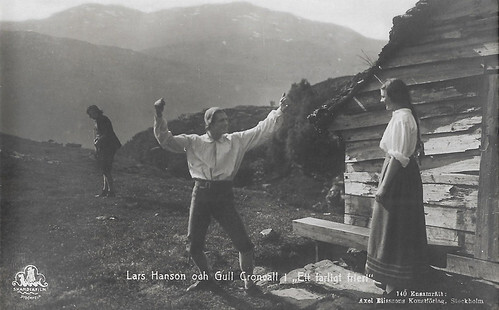
Swedish postcard by Axel Eliassons Konstförlag, Stockholm, No. 140. Photo: Skandia Film, Stockholm. Lars Hanson and Gull Cronvall in Ett farligt frieri/A Dangerous Proposal (Rune Carlsten, 1919).
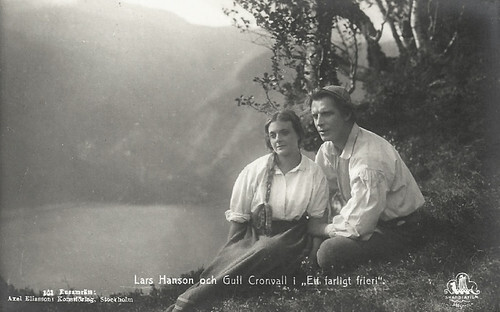
Swedish postcard by Axel Eliassons Konstförlag, Stockholm, no. 141. Photo: Skandia Film, Stockholm. Lars Hanson and Gull Cronvall in Ett farligt frieri/A Dangerous Proposal (Rune Carlsten, 1919).
The story of Ett farligt frieri/A Dangerous Proposal/A Dangerous Wooing (Rune Carlsten, 1919) deals with Tore ( Lars Hanson ), a smallholder's son, secretly in love with Aslaug (Gull Cronvall), the most beautiful girl in the village. Many boys are after her, but Knut (Theodor Blich) and his two sons drive them away if they come too close to the farm.
When Tore asks for Aslaug's hand, her father just laughs at him. Knut has ambitious plans to marry her to the son of the wealthiest farmer around. Even after Knut and Aslaug's brothers have beaten Tore black and blue, he persists in visiting Aslaug, even climbing a giant wall of rock...
The restored version of Ett farligt frieri was shown in 2018 at the Giornate del Cinema Muto in Pordenone, Italy. See Antti Alanen's blogpost on the film.
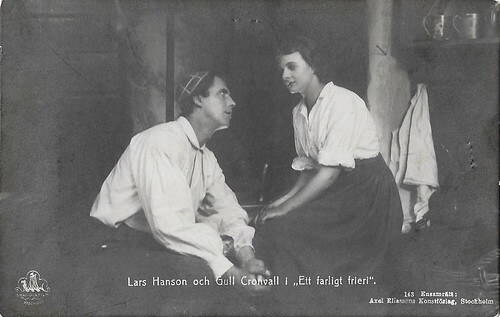
Swedish postcard by Axel Eliassons Konstförlag, Stockholm, no. 143. Photo: Skandia Film, Stockholm. Lars Hanson and Gull Cronvall in Ett farligt frieri/A Dangerous Proposal/A Dangerous Wooing (Rune Carlsten, 1919).
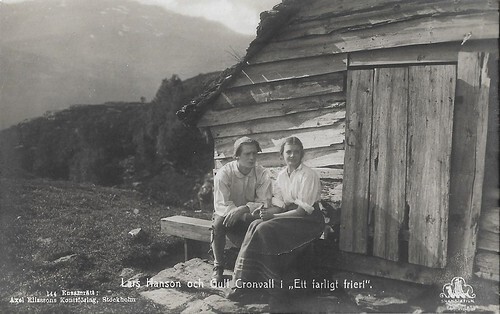
Swedish postcard by Axel Eliassons Konstförlag, Stockholm, no. 144. Photo: Skandia Film, Stockholm. Lars Hanson and Gull Cronvall in Ett farligt frieri/A Dangerous Proposal/A Dangerous Wooing (Rune Carlsten, 1919).
Sången om den eldröda blomman (1919)
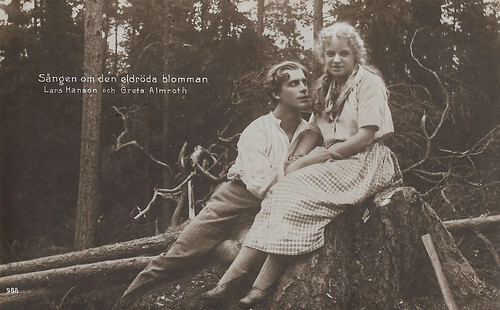
Swedish postcard by Forlag Nordisk Konst, Stockholm, no. 988. Photo: Svenska Biografteatern, Stockholm. Lars Hanson and Greta Amroth in Sången om den eldröda blomman/Flame of Life (Mauritz Stiller, 1919).
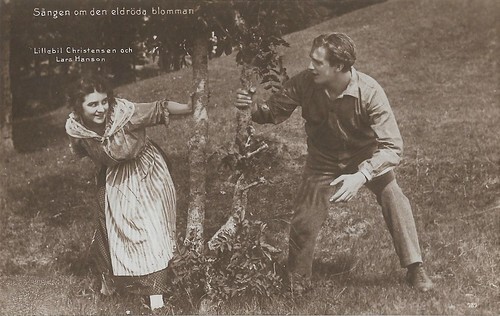
Swedish postcard by Forlag Nordisk Konst, Stockholm, no. 989. Photo: Svenska Biografteatern, Stockholm. Lars Hanson and Lillebil Christensen in Sången om den eldröda blomman/Flame of Life (Mauritz Stiller, 1919).
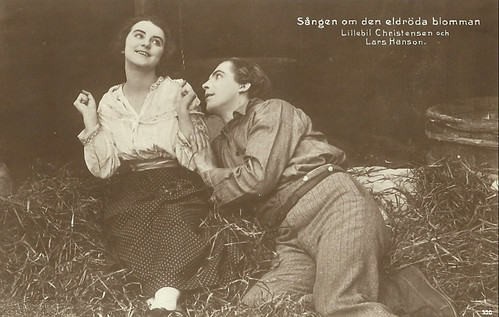
Swedish postcard by Nordisk Konst, no. 990. Photo: Svenska Biografteatern, Stockholm. Lars Hanson and Lillebil Christensen in Sången om den eldröda blomman / The Song of the Red Flower (Mauritz Stiller, 1919).
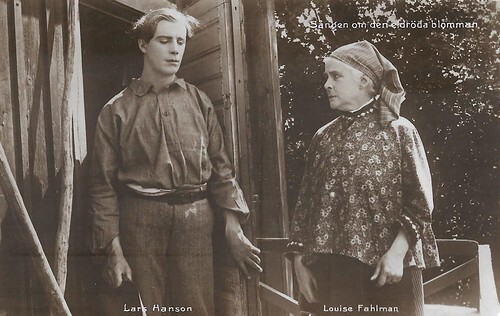
Swedish postcard by Forlag Nordisk Konst, Stockholm, no. 991. Photo: Svenska Biografteatern, Stockholm. Lars Hanson and Louise Fahlmann in Sången om den eldröda blomman/Flame of Life (Mauritz Stiller, 1919).
According to Swedish Wikipedia , Sången om den eldröda blomman/Flame of Life (Mauritz Stiller, 1919) premiered on 14 April 1919. It was shot at the Svenska Biografteatern film studio at Lidingö, with exterior scenes at the Faxälven river near Långsele, near Sollefteå. Cinematography was by Ragnar Westfelt and Henrik Jaenzon. Armas Järnefelt, a Fin but naturalised Swede and a famous opera composer and conductor, wrote a special film score (his first) for this film, based on Finnish and Swedish folk songs.
Sången om den eldröda blomman/Flame of Life was based on the Finnish novel 'Laulu tulipunaisesta kukasta' (The Song of the Red Flower, 1905) by Johannes Linnankoski. The film became a big popular success and ran for five weeks at the premiere cinema Röda Kvarn in Stockholm, which never had happened before. The net profit of the film was at least $ 80,000, the biggest profit to date for any Swedish film.
The story deals with Olof Koskela ( Lars Hanson ), the restless son of a wealthy farmer, who at a dance night abandons his girl Anniki (Greta Almroth) for a maid, Elli (Lillebil Christensen), to the consternation of his parents. His mother (Louise Fahlman) almost catches him in the act. A fight breaks out between Olof and his father, after which he has to leave home. Olof joins a group of raftsmen and follows them down the river.
There he meets Kyllikki (Edith Erastoff), but to his surprise, she dismisses him as another landlubber. Then he decides to show that he is not just anyone. The next Sunday, he stakes out the rapids on a log in front of large crowds of spectators along the river and the long rapids. No one has yet dared to run the rapids on a log. But Olof succeeds and at the last minute, he jumps ashore, while the log swirls around down the fall at the foot of the rapids.
That evening, Kyllikki is waiting for him in the forest. When they part the next morning, she says: "When your years of wandering are over, come back. I will wait for you." Olof arrives in the big city and meets Elli again, who has now ended up in a brothel. He is shocked. Eventually, he comes to his senses and returns to his hometown. Both his parents are now dead, and when he seeks out Kyllikki, her father wants nothing to do with him. But then Kyllikki, as stubborn as her father, declares that in that case, she will leave home. Olof and Kyllikki settle down at the Koskela farm. The wanderer has finally found peace.
In June 2019 the restored and sonorised version with an orchestra performing Jarnefelt's music of Sången om den eldröda blomman was shown at the Cinema Ritrovato festival in Bologna, Italy. See Antti Alanen's excellent blogpost. Alanen quotes Swedish Film Archive curator Jon Wengstrom: "As the carefree Olof who finally finds peace within himself, Lars Hanson gives one of the best performances of his career; not least in the scenes where a disillusioned Olof visits bars and brothels in the city. The dialogue with his image in the mirror of a bar is one of the highlights of staging and acting in the film." We were present at this screening and fully agree with Wengstrom.
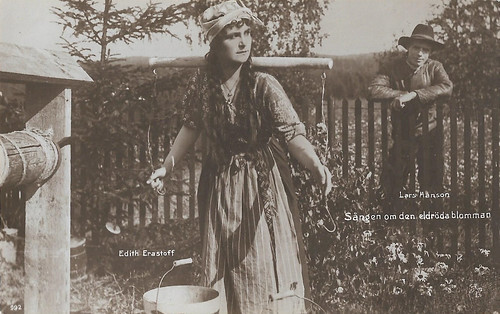
Swedish postcard by Forlag Nordisk Konst, Stockholm, no. 992. Photo: Svenska Biografteatern, Stockholm. Lars Hanson and Edith Erastoff in Sången om den eldröda blomman/Flame of Life (Mauritz Stiller, 1919).
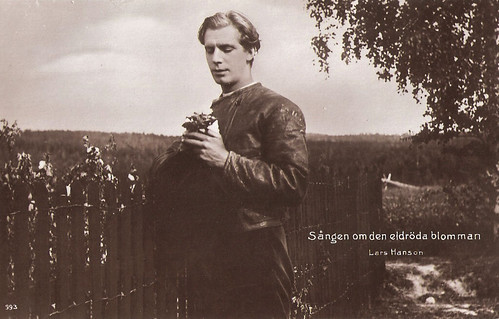
Swedish postcard by Forlag Nordisk Konst, Stockholm, no. 993. Photo: Svenska Biografteatern, Stockholm. Lars Hanson in Sången om den eldröda blomman/Flame of Life (Mauritz Stiller, 1919).
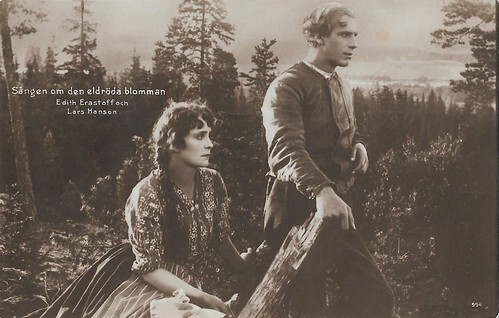
Swedish postcard by Forlag Nordisk Konst, Stockholm, no. 994. Photo: Svenska Biografteatern, Stockholm. Lars Hanson and Edith Erastoff in Sången om den eldröda blomman/Flame of Life (Mauritz Stiller, 1919). Before Olaf and Kylikki part, she says to the restless man: "When your years of wandering are over, come back. I will wait for you."
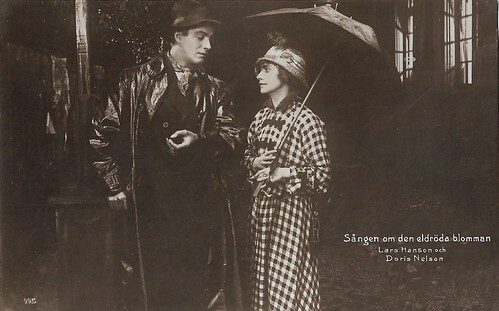
Swedish postcard by Forlag Nordisk Konst, Stockholm, no. 995. Photo: Svenska Biografteatern, Stockholm. Lars Hanson and Doris Nelson in Sången om den eldröda blomman/Flame of Life (Mauritz Stiller, 1919). Olof Koskela meets a streetwalker in the city, still unaware that his former beloved Elli now works in a brothel too.
Erotikon (1920)
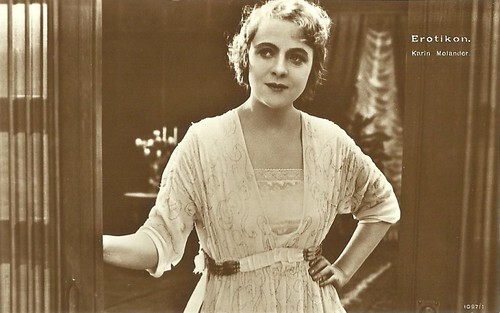
Swedish postcard by Nordisk Konst, Stockholm, no. 1097/1. Photo: Svensk Filmindustri. Karin Molander in Erotikon/Bounds That Chafe (Mauritz Stiller, 1920).
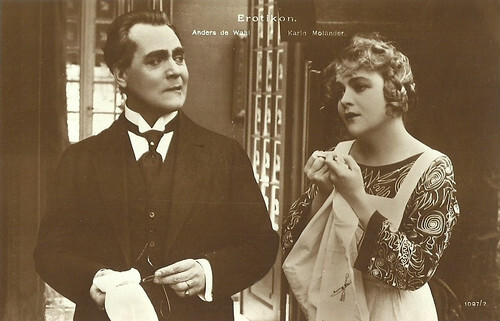
Swedish postcard by Nordisk Konst, Stockholm, no. 1097/2. Photo: Svensk Filmindustri. Anders de Wahl and Karin Molander in Erotikon (Mauritz Stiller, 1920).
In the romantic comedy Erotikon/Bounds That Chafe (Mauritz Stiller, 1920), the story revolves around an entomology professor obsessed with the sexual life of bugs, and his easygoing wife who is courted by two suitors. Marthe ( Karin Molander ) is secretly in love with her uncle, prof. Carpentier ( Anders de Wahl ), while his wife Irene ( Tora Teje ) loves baron Felix (Vilhelm Bryde). Her husband's friend, the sculptor Preben Wells ( Lars Hanson ), loves Irene. Carpentier doesn't oppose his wife's flirts as he likes somebody else too.
Erotikon, based on the 1917 play 'A kék róka' by Ferenc Herczeg, pushed the boundaries of what was acceptable on the screen in 1920. Director Mauritz Stiller obviously delighted in teasing his audience with each scandalous plot twist and every salacious leer, and the result is a deliciously subversive comedy that was very much ahead of its time. The film premiered in Sweden on 8 November 1920. It became a commercial success and was sold to 45 markets abroad.
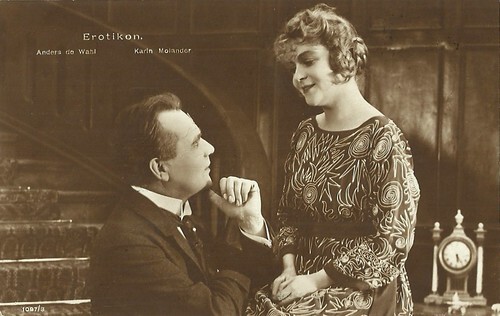
Swedish postcard by Nordisk Konst, Stockholm, no. 1097/3. Anders de Wahl and Karin Molander in Erotikon/Bounds That Chafe (Mauritz Stiller 1920).
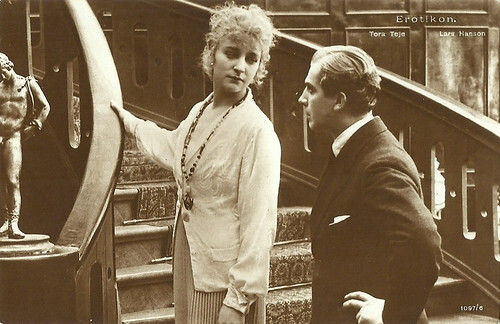
Swedish postcard by Nordisk Konst, Stockholm, no. 1097/6. Photo: Svensk Filmindustri. Tora Teje and Lars Hanson in Erotikon (Mauritz Stiller, 1920).
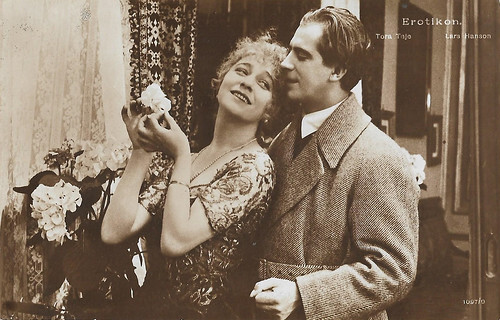
Vintage Swedish postcard by Nordisk Konst, Stockholm, no. 1097/9. Photo: Svensk Filmindustri. Tora Teje and Lars Hanson in Erotikon (Mauritz Stiller, 1920).
Sources: Wikipedia (Dutch, Swedish and English) and IMDb.
Ett faerligt frieri (1919)

Swedish postcard by Axel Eliassons Konstförlag, Stockholm, No. 140. Photo: Skandia Film, Stockholm. Lars Hanson and Gull Cronvall in Ett farligt frieri/A Dangerous Proposal (Rune Carlsten, 1919).

Swedish postcard by Axel Eliassons Konstförlag, Stockholm, no. 141. Photo: Skandia Film, Stockholm. Lars Hanson and Gull Cronvall in Ett farligt frieri/A Dangerous Proposal (Rune Carlsten, 1919).
The story of Ett farligt frieri/A Dangerous Proposal/A Dangerous Wooing (Rune Carlsten, 1919) deals with Tore ( Lars Hanson ), a smallholder's son, secretly in love with Aslaug (Gull Cronvall), the most beautiful girl in the village. Many boys are after her, but Knut (Theodor Blich) and his two sons drive them away if they come too close to the farm.
When Tore asks for Aslaug's hand, her father just laughs at him. Knut has ambitious plans to marry her to the son of the wealthiest farmer around. Even after Knut and Aslaug's brothers have beaten Tore black and blue, he persists in visiting Aslaug, even climbing a giant wall of rock...
The restored version of Ett farligt frieri was shown in 2018 at the Giornate del Cinema Muto in Pordenone, Italy. See Antti Alanen's blogpost on the film.

Swedish postcard by Axel Eliassons Konstförlag, Stockholm, no. 143. Photo: Skandia Film, Stockholm. Lars Hanson and Gull Cronvall in Ett farligt frieri/A Dangerous Proposal/A Dangerous Wooing (Rune Carlsten, 1919).

Swedish postcard by Axel Eliassons Konstförlag, Stockholm, no. 144. Photo: Skandia Film, Stockholm. Lars Hanson and Gull Cronvall in Ett farligt frieri/A Dangerous Proposal/A Dangerous Wooing (Rune Carlsten, 1919).
Sången om den eldröda blomman (1919)

Swedish postcard by Forlag Nordisk Konst, Stockholm, no. 988. Photo: Svenska Biografteatern, Stockholm. Lars Hanson and Greta Amroth in Sången om den eldröda blomman/Flame of Life (Mauritz Stiller, 1919).

Swedish postcard by Forlag Nordisk Konst, Stockholm, no. 989. Photo: Svenska Biografteatern, Stockholm. Lars Hanson and Lillebil Christensen in Sången om den eldröda blomman/Flame of Life (Mauritz Stiller, 1919).

Swedish postcard by Nordisk Konst, no. 990. Photo: Svenska Biografteatern, Stockholm. Lars Hanson and Lillebil Christensen in Sången om den eldröda blomman / The Song of the Red Flower (Mauritz Stiller, 1919).

Swedish postcard by Forlag Nordisk Konst, Stockholm, no. 991. Photo: Svenska Biografteatern, Stockholm. Lars Hanson and Louise Fahlmann in Sången om den eldröda blomman/Flame of Life (Mauritz Stiller, 1919).
According to Swedish Wikipedia , Sången om den eldröda blomman/Flame of Life (Mauritz Stiller, 1919) premiered on 14 April 1919. It was shot at the Svenska Biografteatern film studio at Lidingö, with exterior scenes at the Faxälven river near Långsele, near Sollefteå. Cinematography was by Ragnar Westfelt and Henrik Jaenzon. Armas Järnefelt, a Fin but naturalised Swede and a famous opera composer and conductor, wrote a special film score (his first) for this film, based on Finnish and Swedish folk songs.
Sången om den eldröda blomman/Flame of Life was based on the Finnish novel 'Laulu tulipunaisesta kukasta' (The Song of the Red Flower, 1905) by Johannes Linnankoski. The film became a big popular success and ran for five weeks at the premiere cinema Röda Kvarn in Stockholm, which never had happened before. The net profit of the film was at least $ 80,000, the biggest profit to date for any Swedish film.
The story deals with Olof Koskela ( Lars Hanson ), the restless son of a wealthy farmer, who at a dance night abandons his girl Anniki (Greta Almroth) for a maid, Elli (Lillebil Christensen), to the consternation of his parents. His mother (Louise Fahlman) almost catches him in the act. A fight breaks out between Olof and his father, after which he has to leave home. Olof joins a group of raftsmen and follows them down the river.
There he meets Kyllikki (Edith Erastoff), but to his surprise, she dismisses him as another landlubber. Then he decides to show that he is not just anyone. The next Sunday, he stakes out the rapids on a log in front of large crowds of spectators along the river and the long rapids. No one has yet dared to run the rapids on a log. But Olof succeeds and at the last minute, he jumps ashore, while the log swirls around down the fall at the foot of the rapids.
That evening, Kyllikki is waiting for him in the forest. When they part the next morning, she says: "When your years of wandering are over, come back. I will wait for you." Olof arrives in the big city and meets Elli again, who has now ended up in a brothel. He is shocked. Eventually, he comes to his senses and returns to his hometown. Both his parents are now dead, and when he seeks out Kyllikki, her father wants nothing to do with him. But then Kyllikki, as stubborn as her father, declares that in that case, she will leave home. Olof and Kyllikki settle down at the Koskela farm. The wanderer has finally found peace.
In June 2019 the restored and sonorised version with an orchestra performing Jarnefelt's music of Sången om den eldröda blomman was shown at the Cinema Ritrovato festival in Bologna, Italy. See Antti Alanen's excellent blogpost. Alanen quotes Swedish Film Archive curator Jon Wengstrom: "As the carefree Olof who finally finds peace within himself, Lars Hanson gives one of the best performances of his career; not least in the scenes where a disillusioned Olof visits bars and brothels in the city. The dialogue with his image in the mirror of a bar is one of the highlights of staging and acting in the film." We were present at this screening and fully agree with Wengstrom.

Swedish postcard by Forlag Nordisk Konst, Stockholm, no. 992. Photo: Svenska Biografteatern, Stockholm. Lars Hanson and Edith Erastoff in Sången om den eldröda blomman/Flame of Life (Mauritz Stiller, 1919).

Swedish postcard by Forlag Nordisk Konst, Stockholm, no. 993. Photo: Svenska Biografteatern, Stockholm. Lars Hanson in Sången om den eldröda blomman/Flame of Life (Mauritz Stiller, 1919).

Swedish postcard by Forlag Nordisk Konst, Stockholm, no. 994. Photo: Svenska Biografteatern, Stockholm. Lars Hanson and Edith Erastoff in Sången om den eldröda blomman/Flame of Life (Mauritz Stiller, 1919). Before Olaf and Kylikki part, she says to the restless man: "When your years of wandering are over, come back. I will wait for you."

Swedish postcard by Forlag Nordisk Konst, Stockholm, no. 995. Photo: Svenska Biografteatern, Stockholm. Lars Hanson and Doris Nelson in Sången om den eldröda blomman/Flame of Life (Mauritz Stiller, 1919). Olof Koskela meets a streetwalker in the city, still unaware that his former beloved Elli now works in a brothel too.
Erotikon (1920)

Swedish postcard by Nordisk Konst, Stockholm, no. 1097/1. Photo: Svensk Filmindustri. Karin Molander in Erotikon/Bounds That Chafe (Mauritz Stiller, 1920).

Swedish postcard by Nordisk Konst, Stockholm, no. 1097/2. Photo: Svensk Filmindustri. Anders de Wahl and Karin Molander in Erotikon (Mauritz Stiller, 1920).
In the romantic comedy Erotikon/Bounds That Chafe (Mauritz Stiller, 1920), the story revolves around an entomology professor obsessed with the sexual life of bugs, and his easygoing wife who is courted by two suitors. Marthe ( Karin Molander ) is secretly in love with her uncle, prof. Carpentier ( Anders de Wahl ), while his wife Irene ( Tora Teje ) loves baron Felix (Vilhelm Bryde). Her husband's friend, the sculptor Preben Wells ( Lars Hanson ), loves Irene. Carpentier doesn't oppose his wife's flirts as he likes somebody else too.
Erotikon, based on the 1917 play 'A kék róka' by Ferenc Herczeg, pushed the boundaries of what was acceptable on the screen in 1920. Director Mauritz Stiller obviously delighted in teasing his audience with each scandalous plot twist and every salacious leer, and the result is a deliciously subversive comedy that was very much ahead of its time. The film premiered in Sweden on 8 November 1920. It became a commercial success and was sold to 45 markets abroad.

Swedish postcard by Nordisk Konst, Stockholm, no. 1097/3. Anders de Wahl and Karin Molander in Erotikon/Bounds That Chafe (Mauritz Stiller 1920).

Swedish postcard by Nordisk Konst, Stockholm, no. 1097/6. Photo: Svensk Filmindustri. Tora Teje and Lars Hanson in Erotikon (Mauritz Stiller, 1920).

Vintage Swedish postcard by Nordisk Konst, Stockholm, no. 1097/9. Photo: Svensk Filmindustri. Tora Teje and Lars Hanson in Erotikon (Mauritz Stiller, 1920).
Sources: Wikipedia (Dutch, Swedish and English) and IMDb.
Published on November 18, 2022 22:00
November 17, 2022
Robin Williams
American comedian and actor Robin Williams (1951-2014) began his career in the mid-1970s as a stand-up comedian in comedy clubs in San Francisco and Los Angeles. Williams was known for his many impersonations and the different voices he used during his performances. He became famous as the alien Mork in the TV series Mork & Mindy (1978-1982). After three Oscar nominations, he won the award for his supporting role in Good Will Hunting (1997). He also received acclaim for films like Good Morning, Vietnam (1987), The Fisher King (1991), Aladdin (1992), Mrs Doubtfire (1993) and One Hour Photo (2002).
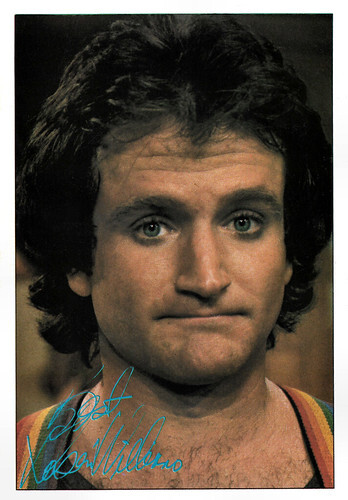
German collectors Autogram card by Bravo. Robin Williams in Mork & Mindy (1978-1982).
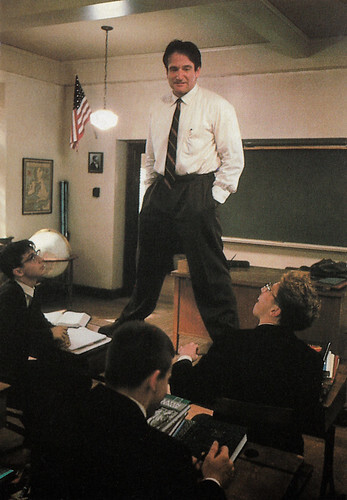
French postcard by Sonis, no. C. 97. Photo: Touchstone Pictures. Robin Williams in Dead Poets Society (Peter Weir, 1989).
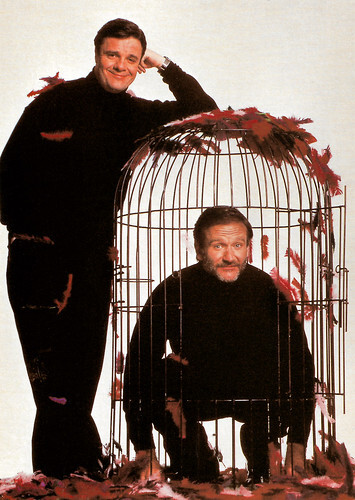
British postcard by Boomerang. Photo: UIP. Nathan Lane and Robin Williams in The Birdcage (Mike Nichols, 1996).
A wildly comic talent and an effective dramatic actor
Robin McLaurin Williams was born in 1951, in Chicago, Illinois. His mother, Laurie McLaurin (née Janin), was a former model, and his father, Robert Fitzgerald Williams, was a Ford Motor Company executive.
Williams was described as hyperactive in his youth. He developed his talent for making people laugh through stand-up comedy, among other things. Robin briefly studied political science at Claremont Men's College and theatre at the College of Marin before enrolling at The Juilliard School to focus on theatre.
After leaving Juilliard, he performed in nightclubs where he was discovered for the role of Mork, from Ork, in an episode of the TV series Happy Days (1974). The episode, Happy Days: My Favorite Orkan (1978), led to his famous spin-off weekly TV series, Mork & Mindy (1978-1982). He made his feature starring debut playing the title role in Popeye (1980), directed by Robert Altman.
Williams' continuous comedies and wild comic talents involved a great deal of improvisation, following in the footsteps of his idol Jonathan Winters. Good Morning, Vietnam (Barry Levinson, 1987) was an important film in Williams' career, as most of the humorous radio broadcasts in it were improvised by him on the spot. This led to Williams' first nomination for an Oscar, that for Best Actor in a Leading Role.
Williams proved to be an effective dramatic actor, also receiving Academy Award nominations for Best Actor in a Leading Role in Dead Poets Society (Peter Weir, 1989), and The Fisher King (Terry Gilliam, 1991) opposite Jeff Bridges, before winning the Academy Award for Best Actor in a Supporting Role in Good Will Hunting (Gus Van Sant, 1997), starring Matt Damon.
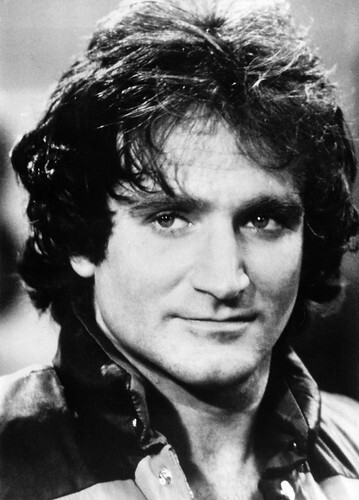
Dutch press photo by Kippa. Robin Williams in Mork & Mindy (1978-1982).
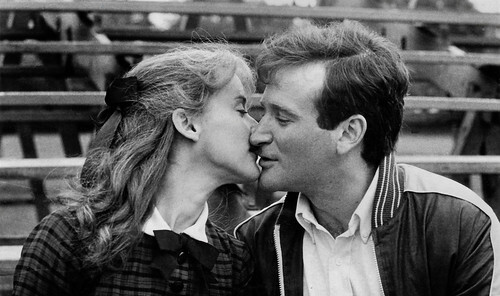
Dutch press photo by Kippa. Robin Williams and Mary Beth Hurt in The World According to Garp (George Roy Hill, 1982).
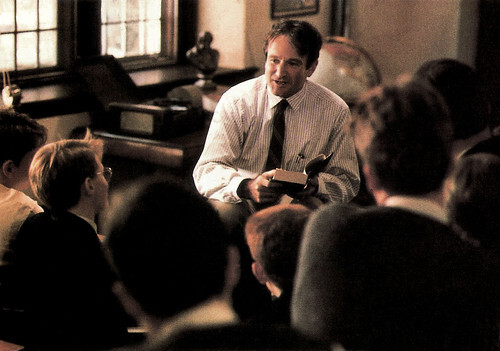
French postcard by Sonis, no. C. 96. Photo: Touchstone Pictures. Robin Williams in Dead Poets Society (Peter Weir, 1989).
A beloved hero to children the world over
During the 1990s, Robin Williams became a beloved hero to children the world over for his roles in a string of hit family-oriented films, including Hook (Steven Spielberg, 1991) opposite Dustin Hoffman , Mrs. Doubtfire (Chris Columbus, 1993) with Sally Field, Jumanji (Joe Johnston, 1995), and Flubber (Les Mayfield, 1997).
Disney asked him to play the voice of the genie in the animated film Aladdin (Ron Clements, John Musker, 1992). The writers had conceived and developed the character with Williams in mind, even before asking him for the role. At the time, it was not very common for well-known Hollywood actors to perform a voice in films. Williams agreed on the condition that Disney would not use his name or voice afterwards for marketing campaigns or sell merchandise.
At first, Disney kept that agreement but later broke its promise because of the popularity of the film and the genie character. When the makers came up with a second film, The Return of Jafar (1994), Williams refused to perform the voice of the genie again. It wasn't until a third Aladdin film, Aladdin and the King of Thieves (Tad Stones, 1996), that the dispute was settled and Williams once again stepped into the role of Genie.
Williams continued entertaining children and families into the 21st century with his work in Robots (Chris Wedge, Carlos Saldanha, 2005), Happy Feet (George Miller, 2006), and Night at the Museum (Shawn Levy, 2006). Other more adult-oriented films for which Williams received acclaim include The World According to Garp (George Roy Hill, 1982), Moscow on the Hudson (Paul Mazursky, 1984), Awakenings (Penny Marshall, 1990) with Robert De Niro , The Birdcage (Mike Nichols, 1996), Insomnia (Christopher Nolan, 2002), and One Hour Photo (Mark Romanek, 2002).
In 2009, Williams underwent heart surgery. After 30 years, he played another role in a television series, The Crazy Ones (2014) with Sarah Michelle Gellar. In 2014, Robin Williams was found dead at his home in Tiburon, California USA, the victim of an apparent suicide. The actor had been struggling with alcohol addiction for decades and had been depressed for some time, according to his spokeswoman. Three days after his death, his widow stated that he had recently known he was suffering from Parkinson's disease.
Williams was cremated a day after his death and his ashes were scattered in San Francisco Bay. After his death, the line "Oh captain, my captain" from the film Dead Poets Society became a tribute to Williams for many fans. Robin Williams was married three times, to Valerie Velardi (1978-1988, 1 child), Marsha Garces Williams (1989-2010, 2 children) and to Susan Schneider (2011-2014, his death). His children are Zak, Zelda and Cody Williams.
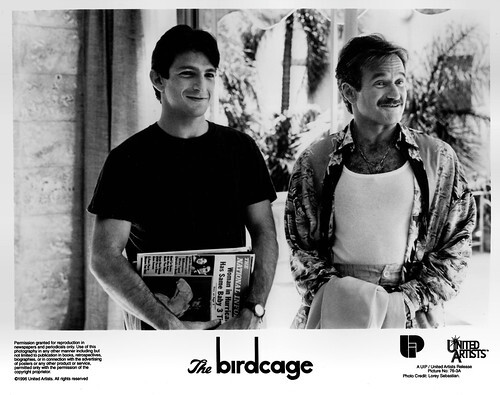
Vintage press photo by UIP / United Artists, no. 76/3A. Photo: Lorey Sebastian. Dan Futterman and Robin Williams in The Birdcage (Mike Nichols, 1996).
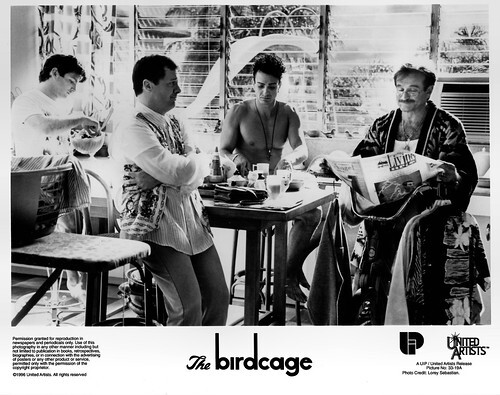
Vintage press photo by UIP / United Artists, no. 33/19A. Photo: Lorey Sebastian. Dan Futterman, Nathan Lane, Hank Azaria and Robin Williams in The Birdcage (Mike Nichols, 1996).
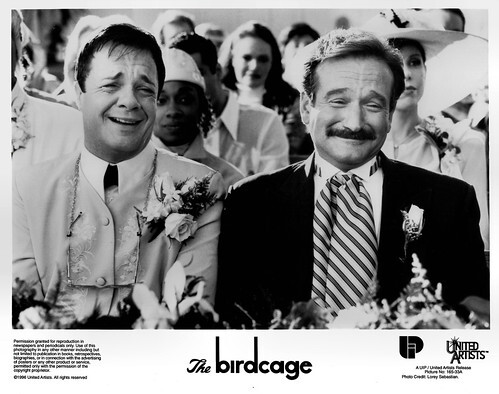
Vintage press photo by UIP / United Artists, no. 165/33A. Photo: Lorey Sebastian. Nathan Lane and Robin Williams in The Birdcage (Mike Nichols, 1996).
Sources: Wikipedia (Dutch) and .

German collectors Autogram card by Bravo. Robin Williams in Mork & Mindy (1978-1982).

French postcard by Sonis, no. C. 97. Photo: Touchstone Pictures. Robin Williams in Dead Poets Society (Peter Weir, 1989).

British postcard by Boomerang. Photo: UIP. Nathan Lane and Robin Williams in The Birdcage (Mike Nichols, 1996).
A wildly comic talent and an effective dramatic actor
Robin McLaurin Williams was born in 1951, in Chicago, Illinois. His mother, Laurie McLaurin (née Janin), was a former model, and his father, Robert Fitzgerald Williams, was a Ford Motor Company executive.
Williams was described as hyperactive in his youth. He developed his talent for making people laugh through stand-up comedy, among other things. Robin briefly studied political science at Claremont Men's College and theatre at the College of Marin before enrolling at The Juilliard School to focus on theatre.
After leaving Juilliard, he performed in nightclubs where he was discovered for the role of Mork, from Ork, in an episode of the TV series Happy Days (1974). The episode, Happy Days: My Favorite Orkan (1978), led to his famous spin-off weekly TV series, Mork & Mindy (1978-1982). He made his feature starring debut playing the title role in Popeye (1980), directed by Robert Altman.
Williams' continuous comedies and wild comic talents involved a great deal of improvisation, following in the footsteps of his idol Jonathan Winters. Good Morning, Vietnam (Barry Levinson, 1987) was an important film in Williams' career, as most of the humorous radio broadcasts in it were improvised by him on the spot. This led to Williams' first nomination for an Oscar, that for Best Actor in a Leading Role.
Williams proved to be an effective dramatic actor, also receiving Academy Award nominations for Best Actor in a Leading Role in Dead Poets Society (Peter Weir, 1989), and The Fisher King (Terry Gilliam, 1991) opposite Jeff Bridges, before winning the Academy Award for Best Actor in a Supporting Role in Good Will Hunting (Gus Van Sant, 1997), starring Matt Damon.

Dutch press photo by Kippa. Robin Williams in Mork & Mindy (1978-1982).

Dutch press photo by Kippa. Robin Williams and Mary Beth Hurt in The World According to Garp (George Roy Hill, 1982).

French postcard by Sonis, no. C. 96. Photo: Touchstone Pictures. Robin Williams in Dead Poets Society (Peter Weir, 1989).
A beloved hero to children the world over
During the 1990s, Robin Williams became a beloved hero to children the world over for his roles in a string of hit family-oriented films, including Hook (Steven Spielberg, 1991) opposite Dustin Hoffman , Mrs. Doubtfire (Chris Columbus, 1993) with Sally Field, Jumanji (Joe Johnston, 1995), and Flubber (Les Mayfield, 1997).
Disney asked him to play the voice of the genie in the animated film Aladdin (Ron Clements, John Musker, 1992). The writers had conceived and developed the character with Williams in mind, even before asking him for the role. At the time, it was not very common for well-known Hollywood actors to perform a voice in films. Williams agreed on the condition that Disney would not use his name or voice afterwards for marketing campaigns or sell merchandise.
At first, Disney kept that agreement but later broke its promise because of the popularity of the film and the genie character. When the makers came up with a second film, The Return of Jafar (1994), Williams refused to perform the voice of the genie again. It wasn't until a third Aladdin film, Aladdin and the King of Thieves (Tad Stones, 1996), that the dispute was settled and Williams once again stepped into the role of Genie.
Williams continued entertaining children and families into the 21st century with his work in Robots (Chris Wedge, Carlos Saldanha, 2005), Happy Feet (George Miller, 2006), and Night at the Museum (Shawn Levy, 2006). Other more adult-oriented films for which Williams received acclaim include The World According to Garp (George Roy Hill, 1982), Moscow on the Hudson (Paul Mazursky, 1984), Awakenings (Penny Marshall, 1990) with Robert De Niro , The Birdcage (Mike Nichols, 1996), Insomnia (Christopher Nolan, 2002), and One Hour Photo (Mark Romanek, 2002).
In 2009, Williams underwent heart surgery. After 30 years, he played another role in a television series, The Crazy Ones (2014) with Sarah Michelle Gellar. In 2014, Robin Williams was found dead at his home in Tiburon, California USA, the victim of an apparent suicide. The actor had been struggling with alcohol addiction for decades and had been depressed for some time, according to his spokeswoman. Three days after his death, his widow stated that he had recently known he was suffering from Parkinson's disease.
Williams was cremated a day after his death and his ashes were scattered in San Francisco Bay. After his death, the line "Oh captain, my captain" from the film Dead Poets Society became a tribute to Williams for many fans. Robin Williams was married three times, to Valerie Velardi (1978-1988, 1 child), Marsha Garces Williams (1989-2010, 2 children) and to Susan Schneider (2011-2014, his death). His children are Zak, Zelda and Cody Williams.

Vintage press photo by UIP / United Artists, no. 76/3A. Photo: Lorey Sebastian. Dan Futterman and Robin Williams in The Birdcage (Mike Nichols, 1996).

Vintage press photo by UIP / United Artists, no. 33/19A. Photo: Lorey Sebastian. Dan Futterman, Nathan Lane, Hank Azaria and Robin Williams in The Birdcage (Mike Nichols, 1996).

Vintage press photo by UIP / United Artists, no. 165/33A. Photo: Lorey Sebastian. Nathan Lane and Robin Williams in The Birdcage (Mike Nichols, 1996).
Sources: Wikipedia (Dutch) and .
Published on November 17, 2022 22:00
November 16, 2022
Riso amaro/Bitter Rice (1949)
The Italian melodrama Riso amaro/Bitter Rice (1949) was a product of the Neo-Realism movement of the 1940s. The film was written and directed by Giuseppe De Santis and produced by Dino De Laurentiis for Lux Film. Bitter Rice was a commercial success in both Europe and America, thanks to the ‘shockingly’ sexy performance of Silvana Mangano, dressed in hotpants. The film also starred Raf Vallone, American actress Doris Dowling and a young Vittorio Gassman. The four become involved in a complex plot involving robbery, love, and murder.

Dutch postcard by Filmverhuurkantoor Centrafilm, Dordrecht. Photo: Lux Film Rome. Silvana Mangano in Riso amaro/Bitter Rice (Giuseppe de Santis, 1949).
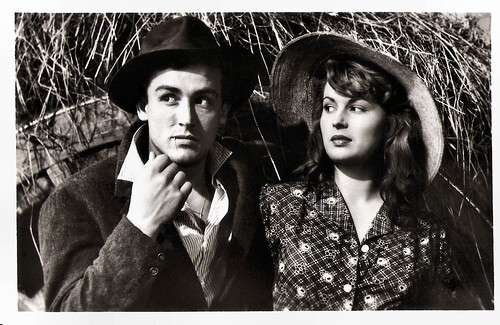
Dutch postcard by Centrafilm, Dordrecht. Photo: Vittorio Gassman and Silvana Mangano in Riso amaro/Bitter Rice (Giuseppe de Santis, 1949). Collection: Geoffrey Donaldson Institute.

Dutch postcard by Centrafilm, Dordrecht. Photo: Silvana Mangano in Riso amaro/Bitter Rice (Giuseppe de Santis, 1949). Collection: Geoffrey Donaldson Institute.
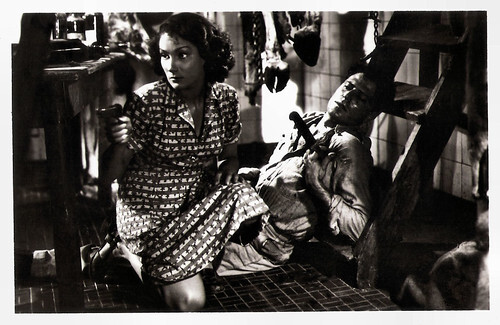
Dutch postcard by Centrafilm, Dordrecht. Photo: Doris Dowling and Raf Vallone in Riso amaro/Bitter Rice (Giuseppe de Santis, 1949). Collection: Geoffrey Donaldson Institute.
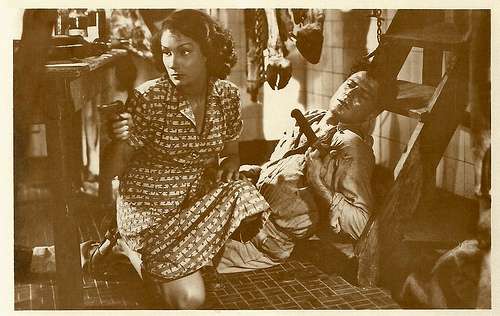
Dutch postcard by Centrafilm, Dordrecht. Photo: Lux. Doris Dowling and Raf Vallone in Riso amaro/Bitter Rice (Giuseppe de Santis, 1949).
Is Riso amaro a Neo-Realist film?
At the time, Neo-Realism was about only 7 years old. Films like Roma Citta Aperta by Roberto Rossellini had taken the world by storm and overwhelmed international audiences and festival juries. But the Neo-Realist films quickly changed in character and Riso amaro/Bitter Rice lead to a dispute among film critics about the sexualisation of the lead character and the melodramatic presence of death and suicide in the film.
At IMDb , Debblyst explains: “Neo-Realist principles (i.e. no stars, mix of professional and non-professional actors, location-only shooting, rejection of ‘beauty’/classicism/romanticism, stressing on ‘ordinary’ people and ‘real-life’ themes) were being stretched: stars were joining in (including international ones, like Ingrid Bergman , or starlets like American Doris Dowling here), productions got bigger and more expensive, crews more professional, equipment more sophisticated, ‘ordinary’ people were being replaced by Olympic beauties (or do ordinary people EVER look like Silvana Mangano or Vittorio Gassman ?), ‘ordinary’ characters were getting very complex, and real life was being traded by elaborate, far from realistic drama.”
Riso amaro begins at the start of the rice-planting season in northern Italy. Trying to escape the law, two small-time criminals, Francesca ( Doris Dowling ) and Walter ( Vittorio Gassman ), hide amongst the crowds of female workers heading to the rice fields of the Po Valley.
While attempting to board the train for the fields, the pair runs into Silvana ( Silvana Mangano ), a voluptuous peasant rice worker. Francesca boards the train with her, in an effort to avoid the police. Silvana introduces her to the planter's way of life. Francesca does not have a work permit, and struggles with the other ‘illegals’ to find a place in the rice fields. After initial resistance from documented workers and bosses, the scabs are allowed a place in the fields.
In the fields, Silvana and Francesca meet a soon-to-be-discharged soldier, Marco ( Raf Vallone ), who unsuccessfully tries to attract Silvana's interest. Toward the end of the working season, Walter arrives at the fields, intending to steal a large quantity of rice. Excited by his criminal lifestyle, Silvana becomes attracted to Walter. She causes a diversion to help him carry out the heist, but Francesca and Marco manage to stop Walter and his accomplices.
Francesca and Silvana face each other, armed with pistols; Francesca confronts Silvana and explains that she has been manipulated by Walter. In response, Silvana turns her gun toward Walter and murders him. Soon afterwards, her guilt leads her to commit suicide. As the other rice workers depart, they pay tribute to her by sprinkling rice upon her body.
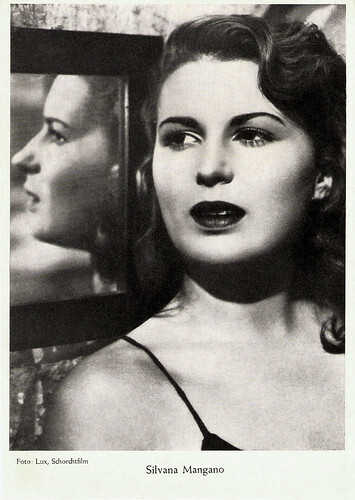
German collectors card. Photo: Lux / Schorchtfilm. Silvana Mangano in Riso amaro/Bitter Rice (Giuseppe de Santis, 1949).
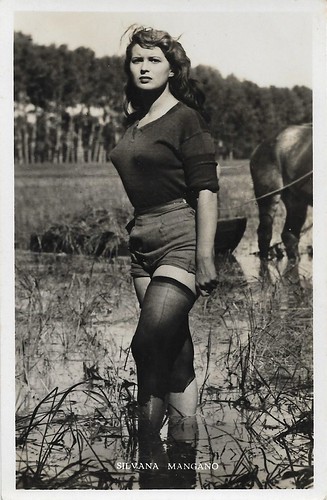
Belgian postcard by Nieuwe Merksemsche Chocolaterie, Merksem. Photo: Lux Film Rome. Silvana Mangano in Riso amaro/Bitter Rice (Giuseppe de Santis, 1949).
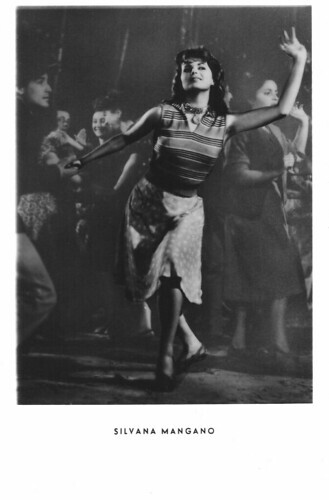
German postcard by Netter's Star Verlag, Berlin. Photo: Lux Film Rome. Silvana Mangano in Riso amaro/Bitter Rice (Giuseppe de Santis, 1949).
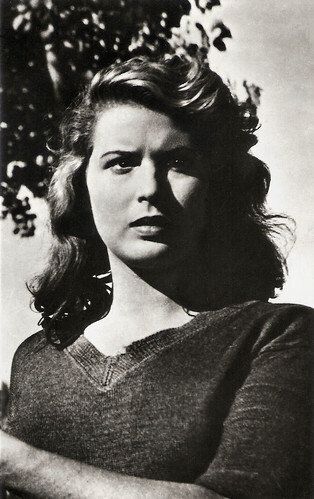
Spanish postcard by Archivo Bermejo, 1953. Photo: Lux Films / Rey Soria. Silvana Mangano in Riso amaro/Bitter Rice (Giuseppe de Santis, 1949).
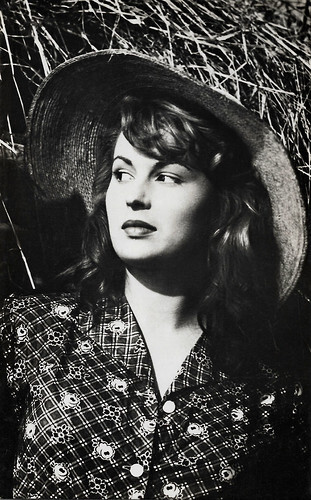
Spanish postcard, 1953. Photo: Lux Films / Rey Soria. Silvana Mangano in Riso amaro/Bitter Rice (Giuseppe de Santis, 1949).
Is Riso amaro merely a shocker?
The Italian title of the film, Riso amaro, is based on a pun. The Italian word ‘riso’ can mean either ‘rice’ or ‘laughter’, 'riso amaro' can be taken to mean either ‘bitter laughter’ or ‘bitter rice’.
Lucia Bosé was the director's first choice for the role of Silvana. It wasn't until he met former Miss Rome Silvana Mangano by chance that he decided to cast her in the film. In the film, Silvana chews gum and dances the boogie-woogie in an American way in the film. With her character’s downfall director Giuseppe De Santis seems to have intended to show his condemnation of the products of American capitalism.
Ironically it was Silvana who made the film one of the biggest box office hits of Neo-Realism cinema. To the standards of 1949, Mangano's performance in the film was shocking. Her hotpants and voluptuous figure earned Riso amaro a lot of publicity, in particular in strongly Roman Catholic Italy. But Riso amaro has more qualities than just being a shocker.
W. Visser at IMDb : “Although its mold of 1949 appears somewhat melodramatic today, the black and white Riso Amaro (= Italian for Bitter Rice) surely ranks among the classics in film history. This very Italian product by Giuseppe de Santis shows a pretty ordinary crime story, excellently interwoven with an impressive decor of harsh season labor in the rice-fields of Northern Italy. The thousands of women, up to their ankles in the water, breaking their backs in the burning sun to earn a few bucks, make a truly great setting.”
The film was selected as one of 100 Italian films to be saved, a collection of films that "changed the collective memory of the country between 1942 and 1978". The collection was established by the Venice Film Festival in collaboration with Cinecittà and curated by Fabio Ferzetti, with input from Gianni Amelio and other Italian film critics. Many of the films selected represent the ‘Golden Age’ of Italian cinema, which was manifested in the Neorealism movement.
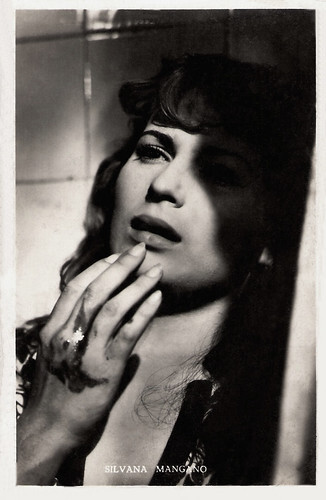
Belgian postcard by Nieuwe Merksemsche Chocolaterie, Merksem. Photo: Lux Film, Rome. Silvana Mangano in Riso Amaro/Bitter Rice (Giuseppe de Santis, 1949).
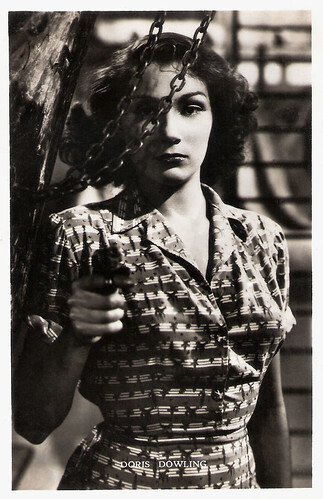
Belgian postcard by Nieuwe Merksemsche Chocolaterie S.P.R.L., Merksem (Anvers). Photo: Lux Film, Rome. Doris Dowling in Riso amaro/Bitter Rice (Giuseppe de Santis, 1949).
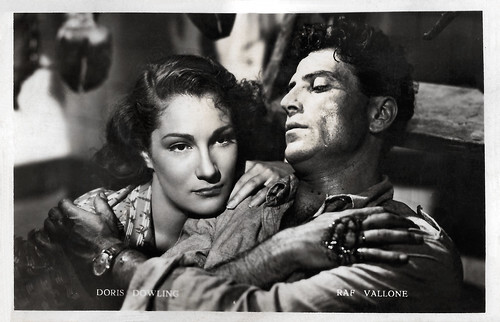
Belgian postcard by Nieuwe Merksemsche Chocolaterie S.P.R.L., Merksem (Anvers). Photo: Doris Dowling and Raf Vallone in Riso amaro/Bitter Rice (Giuseppe de Santis, 1949).
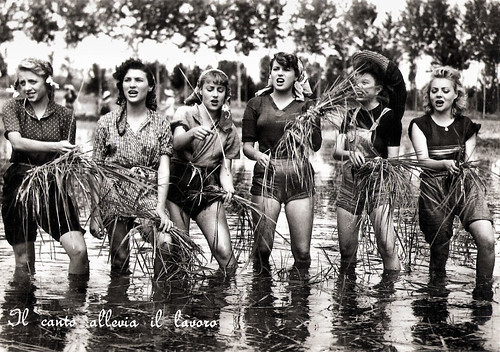
Italian postcard by Ed. B. B. - V. Photo: publicity still for Riso Amaro/Bitter Rice (Giuseppe De Santis, 1949). Caption: Il canto allevia il lavoro (Singing alleviates work).
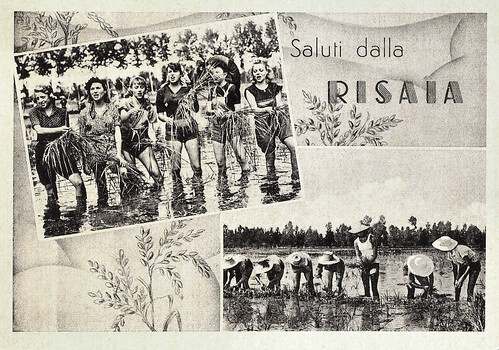
Italian postcard by Ed. B. B. - V., no. 72087. Photos: publicity stills for Riso Amaro/Bitter Rice (Giuseppe De Santis, 1949). Caption: Saluti dalla Risaia (greetings from the paddy fields).
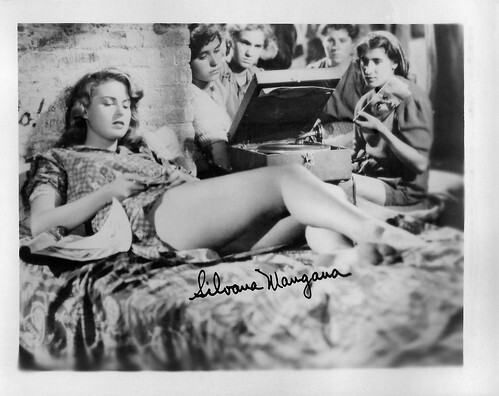
British card by International Exchange, Glasgow. Silvana Mangano in Riso Amaro/Bitter Rice (Giuseppe De Santis, 1949).
Sources: W. Visser (IMDb), Debbylyst (IMDb), Wikipedia and IMDb.

Dutch postcard by Filmverhuurkantoor Centrafilm, Dordrecht. Photo: Lux Film Rome. Silvana Mangano in Riso amaro/Bitter Rice (Giuseppe de Santis, 1949).

Dutch postcard by Centrafilm, Dordrecht. Photo: Vittorio Gassman and Silvana Mangano in Riso amaro/Bitter Rice (Giuseppe de Santis, 1949). Collection: Geoffrey Donaldson Institute.

Dutch postcard by Centrafilm, Dordrecht. Photo: Silvana Mangano in Riso amaro/Bitter Rice (Giuseppe de Santis, 1949). Collection: Geoffrey Donaldson Institute.

Dutch postcard by Centrafilm, Dordrecht. Photo: Doris Dowling and Raf Vallone in Riso amaro/Bitter Rice (Giuseppe de Santis, 1949). Collection: Geoffrey Donaldson Institute.

Dutch postcard by Centrafilm, Dordrecht. Photo: Lux. Doris Dowling and Raf Vallone in Riso amaro/Bitter Rice (Giuseppe de Santis, 1949).
Is Riso amaro a Neo-Realist film?
At the time, Neo-Realism was about only 7 years old. Films like Roma Citta Aperta by Roberto Rossellini had taken the world by storm and overwhelmed international audiences and festival juries. But the Neo-Realist films quickly changed in character and Riso amaro/Bitter Rice lead to a dispute among film critics about the sexualisation of the lead character and the melodramatic presence of death and suicide in the film.
At IMDb , Debblyst explains: “Neo-Realist principles (i.e. no stars, mix of professional and non-professional actors, location-only shooting, rejection of ‘beauty’/classicism/romanticism, stressing on ‘ordinary’ people and ‘real-life’ themes) were being stretched: stars were joining in (including international ones, like Ingrid Bergman , or starlets like American Doris Dowling here), productions got bigger and more expensive, crews more professional, equipment more sophisticated, ‘ordinary’ people were being replaced by Olympic beauties (or do ordinary people EVER look like Silvana Mangano or Vittorio Gassman ?), ‘ordinary’ characters were getting very complex, and real life was being traded by elaborate, far from realistic drama.”
Riso amaro begins at the start of the rice-planting season in northern Italy. Trying to escape the law, two small-time criminals, Francesca ( Doris Dowling ) and Walter ( Vittorio Gassman ), hide amongst the crowds of female workers heading to the rice fields of the Po Valley.
While attempting to board the train for the fields, the pair runs into Silvana ( Silvana Mangano ), a voluptuous peasant rice worker. Francesca boards the train with her, in an effort to avoid the police. Silvana introduces her to the planter's way of life. Francesca does not have a work permit, and struggles with the other ‘illegals’ to find a place in the rice fields. After initial resistance from documented workers and bosses, the scabs are allowed a place in the fields.
In the fields, Silvana and Francesca meet a soon-to-be-discharged soldier, Marco ( Raf Vallone ), who unsuccessfully tries to attract Silvana's interest. Toward the end of the working season, Walter arrives at the fields, intending to steal a large quantity of rice. Excited by his criminal lifestyle, Silvana becomes attracted to Walter. She causes a diversion to help him carry out the heist, but Francesca and Marco manage to stop Walter and his accomplices.
Francesca and Silvana face each other, armed with pistols; Francesca confronts Silvana and explains that she has been manipulated by Walter. In response, Silvana turns her gun toward Walter and murders him. Soon afterwards, her guilt leads her to commit suicide. As the other rice workers depart, they pay tribute to her by sprinkling rice upon her body.

German collectors card. Photo: Lux / Schorchtfilm. Silvana Mangano in Riso amaro/Bitter Rice (Giuseppe de Santis, 1949).

Belgian postcard by Nieuwe Merksemsche Chocolaterie, Merksem. Photo: Lux Film Rome. Silvana Mangano in Riso amaro/Bitter Rice (Giuseppe de Santis, 1949).

German postcard by Netter's Star Verlag, Berlin. Photo: Lux Film Rome. Silvana Mangano in Riso amaro/Bitter Rice (Giuseppe de Santis, 1949).

Spanish postcard by Archivo Bermejo, 1953. Photo: Lux Films / Rey Soria. Silvana Mangano in Riso amaro/Bitter Rice (Giuseppe de Santis, 1949).

Spanish postcard, 1953. Photo: Lux Films / Rey Soria. Silvana Mangano in Riso amaro/Bitter Rice (Giuseppe de Santis, 1949).
Is Riso amaro merely a shocker?
The Italian title of the film, Riso amaro, is based on a pun. The Italian word ‘riso’ can mean either ‘rice’ or ‘laughter’, 'riso amaro' can be taken to mean either ‘bitter laughter’ or ‘bitter rice’.
Lucia Bosé was the director's first choice for the role of Silvana. It wasn't until he met former Miss Rome Silvana Mangano by chance that he decided to cast her in the film. In the film, Silvana chews gum and dances the boogie-woogie in an American way in the film. With her character’s downfall director Giuseppe De Santis seems to have intended to show his condemnation of the products of American capitalism.
Ironically it was Silvana who made the film one of the biggest box office hits of Neo-Realism cinema. To the standards of 1949, Mangano's performance in the film was shocking. Her hotpants and voluptuous figure earned Riso amaro a lot of publicity, in particular in strongly Roman Catholic Italy. But Riso amaro has more qualities than just being a shocker.
W. Visser at IMDb : “Although its mold of 1949 appears somewhat melodramatic today, the black and white Riso Amaro (= Italian for Bitter Rice) surely ranks among the classics in film history. This very Italian product by Giuseppe de Santis shows a pretty ordinary crime story, excellently interwoven with an impressive decor of harsh season labor in the rice-fields of Northern Italy. The thousands of women, up to their ankles in the water, breaking their backs in the burning sun to earn a few bucks, make a truly great setting.”
The film was selected as one of 100 Italian films to be saved, a collection of films that "changed the collective memory of the country between 1942 and 1978". The collection was established by the Venice Film Festival in collaboration with Cinecittà and curated by Fabio Ferzetti, with input from Gianni Amelio and other Italian film critics. Many of the films selected represent the ‘Golden Age’ of Italian cinema, which was manifested in the Neorealism movement.

Belgian postcard by Nieuwe Merksemsche Chocolaterie, Merksem. Photo: Lux Film, Rome. Silvana Mangano in Riso Amaro/Bitter Rice (Giuseppe de Santis, 1949).

Belgian postcard by Nieuwe Merksemsche Chocolaterie S.P.R.L., Merksem (Anvers). Photo: Lux Film, Rome. Doris Dowling in Riso amaro/Bitter Rice (Giuseppe de Santis, 1949).

Belgian postcard by Nieuwe Merksemsche Chocolaterie S.P.R.L., Merksem (Anvers). Photo: Doris Dowling and Raf Vallone in Riso amaro/Bitter Rice (Giuseppe de Santis, 1949).

Italian postcard by Ed. B. B. - V. Photo: publicity still for Riso Amaro/Bitter Rice (Giuseppe De Santis, 1949). Caption: Il canto allevia il lavoro (Singing alleviates work).

Italian postcard by Ed. B. B. - V., no. 72087. Photos: publicity stills for Riso Amaro/Bitter Rice (Giuseppe De Santis, 1949). Caption: Saluti dalla Risaia (greetings from the paddy fields).

British card by International Exchange, Glasgow. Silvana Mangano in Riso Amaro/Bitter Rice (Giuseppe De Santis, 1949).
Sources: W. Visser (IMDb), Debbylyst (IMDb), Wikipedia and IMDb.
Published on November 16, 2022 22:00
November 15, 2022
VerzamelJaarbeurs revisited: Paul’s choice
Last weekend, you could find us at the autumn edition of the VerzamelJaarbeurs 2022, the International Collectors Fair in Utrecht. VerzamelJaarbeurs is Europe's biggest vintage event. Hundreds of stalls offer unusual and unique collections. From toys, games, and curiosities to trendy vintage items. Of course, Marlene, Ivo and I always visit the fair hunting for postcards. And yes, we discovered lots of interesting cards and in three posts we will share our trophies with you. I'll start with my 15 favourite finds.
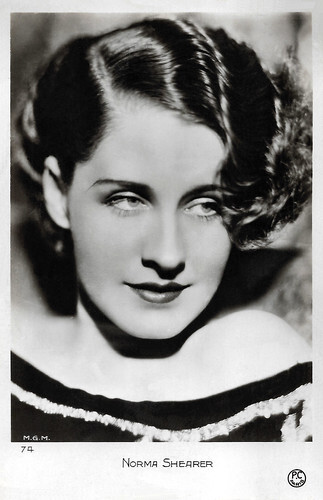
French postcard by P.C., Paris, no. 74. Photo: George Hurrell / Metro-Goldwyn-Mayer.
American actress Norma Shearer (1902-1983) was the 'First Lady of MGM'. She was married to the head of the production at MGM, Irving Thalberg. Norma wanted to play a sexy vamp in the film The Divorcee (Robert Z. Leonard, 1930), but, up until that time, she was known for her 'all-American girl next door' image. When she showed the script to her husband, he replied “Honey, I don’t think this part is for you. You are not sexy in THAT way.” After seeing Hurrell's photos of Ramon Novarro, she decided to have some photos taken by Hurrell so that she could convince her husband that she was indeed sexy in THAT way. Hurrell's photos convinced her husband, Shearer got the film role and their marriage improved. Shearer won the Academy Award for Best Actress as a result of her portrayal in that film, and Hurrell was offered a job as a portrait photographer at MGM.
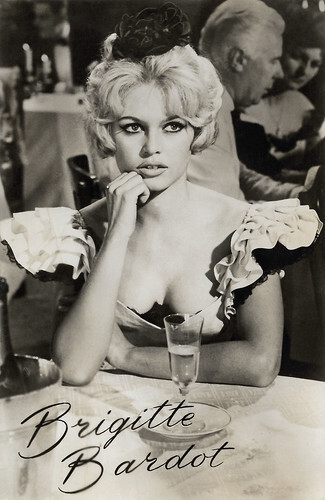
Dutch postcard by Uitg. Takken, Utrecht, no. 3948. Photo: Pathé /N.V. City film, Den Haag. Brigitte Bardot in La femme et le pantin/The Female (Julien Duvivier, 1958).
Beautiful French actress Brigitte Bardot (1934) was the sex kitten of the European film industry. Her box office hit La femme et le pantin/The Female (Julien Duvivier, 1958) is the fifth film adaptation of the novel by Pierre Louÿs, after versions by Reginald Barker (1920), Jacques de Baroncelli (1929), Josef von Sternberg (1935), and Wali Eddine Sameh (1946), and followed by Luis Buñuel's Cet obscur objet du désir (1977). BB starred in 48 films, performed in numerous musical shows, and recorded 80 songs. After her retirement in 1973, she established herself as an animal rights activist and made vegetarianism sexy.
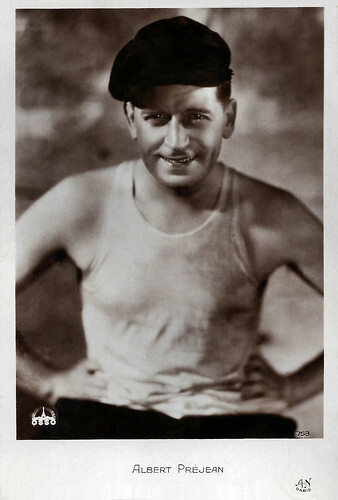
French postcard by A.N. Paris, no. 753. Photo: Osso. Albert Préjean in Un Soir De Rafle/Night Raid (Carmine Gallone, 1931).
French actor and singer Albert Préjean (1894-1979) was a former WWI flying ace. He is best known for playing heroes in the silent films of René Clair, and for playing George Simenon's detective Maigret. in Un Soir De Rafle/Night Raid, he played a sailor, who defeats a former boxing champ in a contest at a fair. The ex-champ trains the sailor to enter the European championship.
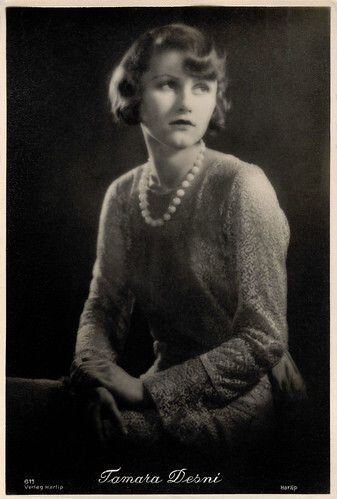
German postcard by Verlag Harlip, no. 611. Photo: Harlip.
Exotic, brunette actress Tamara Desni (1910–2008) was the daughter of Ukrainian-born film star Xenia Desni. Tamara started her stage and film career as a child in Berlin and appeared in several British films during the 1930s and 1940s.
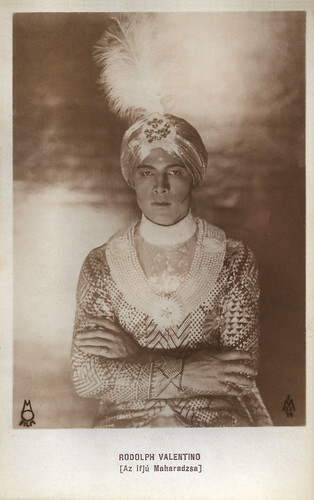
Hungarian postcard by FM, no. 5119. Photo: MOFilm. Rudolph Valentino in The Young Rajah (Phil Rosen, 1922).
Rudolph Valentino (1895-1926) was Hollywood's ultimate 'Latin Lover'. The Italian-born American actor starred in several well-known silent films including The Four Horsemen of the Apocalypse (1921), The Sheik (1922), Blood and Sand (1922), The Eagle (1925), and The Son of the Sheik (1926). His early death at age 31 caused mass hysteria among his female fans and propelled him into iconic status.
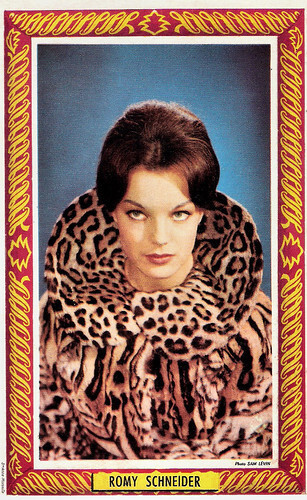
French card by Ste Anne, Marseille. Photo: Sam Lévin.
Austrian actress Romy Schneider (1938-1982) was one of the most beautiful and intelligent actors of her generation. Forty years after her death, she still has an immense popular appeal.
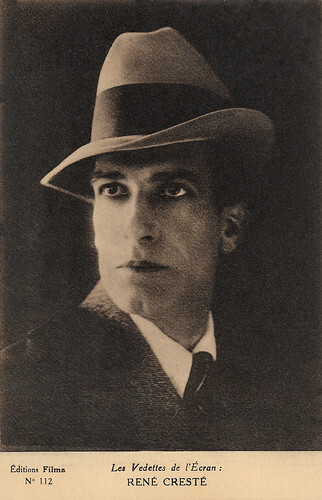
French postcard in the Les Vedettes de l'Écran series by Éditions Filma, no. 112.
René Cresté (1881-1922) was a French stage and film actor and director of the silent film era. He is best remembered as the amazingly cool title character in the crime-adventure serial Judex (1917-1918), directed by Louis Feuillade. Judex was the first superhero of the cinema.
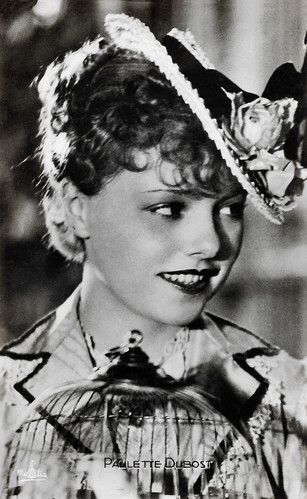
French card by Massilia.
French star Paulette Dubost (1910-2011) appeared in more than 150 films during her 81-year career. She was a witty, naughty and clever comedienne in many French comedies of the 1930s. She also proved to be good in dramatic roles, such as Ginette in Hotel du Nord (1938) and Lisette in La règle du jeu (1939).
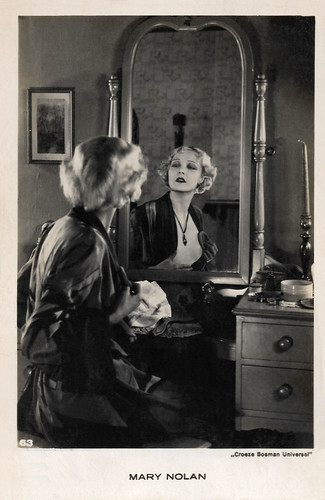
Dutch postcard by Croese Bosman Universal, no. 63. Sent by mail in 1933.
Blonde and utterly beautiful Mary Nolan (1905-1948) was known for her appearances on stage, on screen, and in tabloids. She began her show-business career as a teenage model and soon Florenz Ziegfeld Jr. signed her up for his Follies shows on Broadway. As a Jazz-Age baby and party girl by nature, Mary soon earned the nickname of Bubbles. Her abusive affair with married Ziegfeld comedian Frank Tinney stirred up a major sex scandal. The tabloids exposed the affair after Mary was seriously hospitalised during one of their many arguments. Mary was fired by Ziegfeld and fled to Germany where she starred in films under the name Imogene Robertson. In 1927 she returned to Hollywood as Mary Nolan and starred in several films till 1932. Later, she suffered several nervous breakdowns and her health declined. She turned to heroin, and it spelt the end. In 1948, she died of cardiac arrest and liver problems, at only 42 years old.
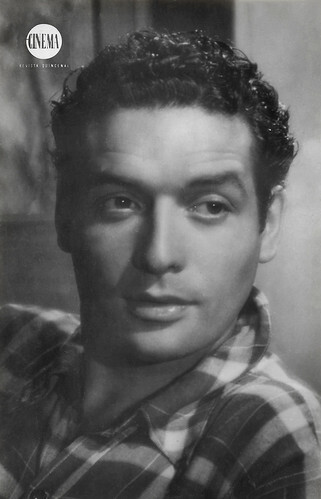
Spanish postcard by Cinema - Revista Quincenal.
Handsome and talented actor Jorge Mistral (1920-1972) became a star in Spanish films during the 1940s. In the 1950s, he lived and worked in México and appeared in Luis Buñuel's Abismos de pasión/Wuthering Heights (1954). Later, in the 1960s, he directed three films.
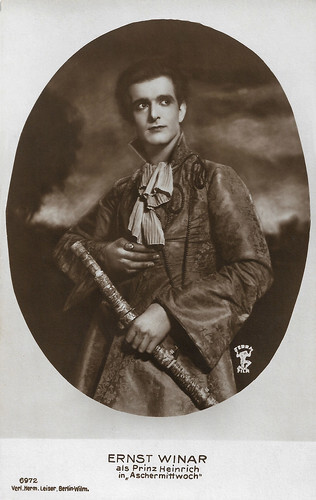
German postcard by Verl. Herm. Leiser, Berlin-Wilm., no. 6972. Photo: Terra-Film. Ernst Winar in Aschermittwoch/Ash Wednesday (Otto Rippert, 1921).
Dutch actor Ernst Winar (1894-1978) appeared in 34 films between 1916 and 1955, in The Netherlands and as well in Germany. He was also a film director and made 14 films between 1922 and 1955. Later he edited the first short films of Paul Verhoeven.
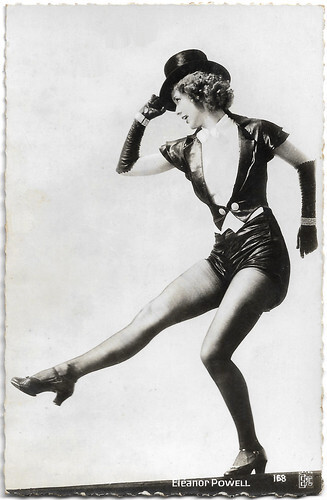
French postcard by Editions et Publications cinématographiques (EPC), no. 168.
Eleanor Powell (1912-1982) was an American dancer and actress, best remembered for her tap dance numbers in musical films in the 1930s and 1940s, such as Born to Dance (1936), Broadway Melody of 1938 (1937), Rosalie (1937), Honolulu (1939), and Broadway Melody of 1940 (1940).
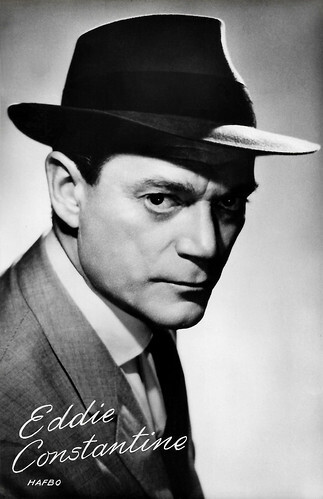
Dutch postcard by Uitg. Takken, Utrecht, no. AX 4700. Photo: Hafbo.
Craggy-faced Eddie Constantine (1917-1993) was an American actor and singer who spent his career as a tough guy in European films. He became famous for a series of French B movies in which he played private eye Lemmy Caution, based on the hero of the detective novels by Peter Cheyney.
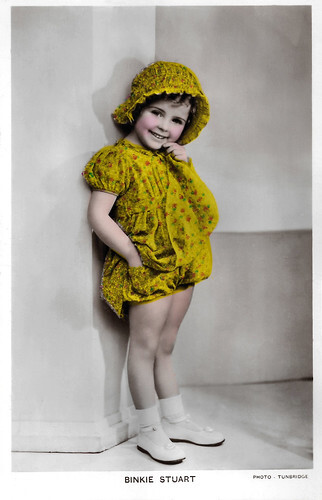
British postcard in the Colourgraph Series, London, no. C 285. Photo: Tunbridge.
Binkie Stuart (1932-2001) was a British child star. She won a Daily Mail contest as "London's Prettiest Baby" in 1935. Through this, she came to the attention of director Monty Banks, who saw her as England's answer to Shirley Temple. But Stuart never even approached the stardom of Temple in her brief film career, which was cut short by the outbreak of the Second World War.
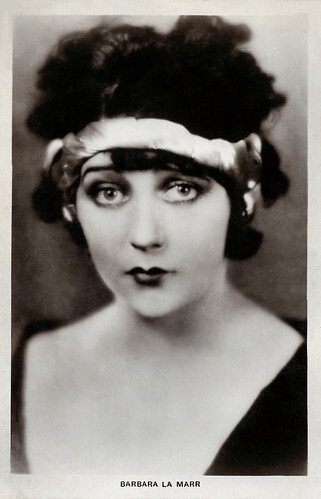
British postcard in the Picturegoer Series, London, no. 185.
Beautiful Barbara La Marr (1896–1926) was an American film actress, who appeared in twenty-seven films during her career between 1920 and 1926. The "Girl Who Is Too Beautiful" was noted for her beauty and her tempestuous marital history. After some early experience in Vaudeville, she became a screenplay writer, and then a performer, appearing with Douglas Fairbanks and others in over thirty films, as well as dancing on Broadway. Her hedonistic lifestyle in Hollywood, with heavy drug dependence, led to her early death.

French postcard by P.C., Paris, no. 74. Photo: George Hurrell / Metro-Goldwyn-Mayer.
American actress Norma Shearer (1902-1983) was the 'First Lady of MGM'. She was married to the head of the production at MGM, Irving Thalberg. Norma wanted to play a sexy vamp in the film The Divorcee (Robert Z. Leonard, 1930), but, up until that time, she was known for her 'all-American girl next door' image. When she showed the script to her husband, he replied “Honey, I don’t think this part is for you. You are not sexy in THAT way.” After seeing Hurrell's photos of Ramon Novarro, she decided to have some photos taken by Hurrell so that she could convince her husband that she was indeed sexy in THAT way. Hurrell's photos convinced her husband, Shearer got the film role and their marriage improved. Shearer won the Academy Award for Best Actress as a result of her portrayal in that film, and Hurrell was offered a job as a portrait photographer at MGM.

Dutch postcard by Uitg. Takken, Utrecht, no. 3948. Photo: Pathé /N.V. City film, Den Haag. Brigitte Bardot in La femme et le pantin/The Female (Julien Duvivier, 1958).
Beautiful French actress Brigitte Bardot (1934) was the sex kitten of the European film industry. Her box office hit La femme et le pantin/The Female (Julien Duvivier, 1958) is the fifth film adaptation of the novel by Pierre Louÿs, after versions by Reginald Barker (1920), Jacques de Baroncelli (1929), Josef von Sternberg (1935), and Wali Eddine Sameh (1946), and followed by Luis Buñuel's Cet obscur objet du désir (1977). BB starred in 48 films, performed in numerous musical shows, and recorded 80 songs. After her retirement in 1973, she established herself as an animal rights activist and made vegetarianism sexy.

French postcard by A.N. Paris, no. 753. Photo: Osso. Albert Préjean in Un Soir De Rafle/Night Raid (Carmine Gallone, 1931).
French actor and singer Albert Préjean (1894-1979) was a former WWI flying ace. He is best known for playing heroes in the silent films of René Clair, and for playing George Simenon's detective Maigret. in Un Soir De Rafle/Night Raid, he played a sailor, who defeats a former boxing champ in a contest at a fair. The ex-champ trains the sailor to enter the European championship.

German postcard by Verlag Harlip, no. 611. Photo: Harlip.
Exotic, brunette actress Tamara Desni (1910–2008) was the daughter of Ukrainian-born film star Xenia Desni. Tamara started her stage and film career as a child in Berlin and appeared in several British films during the 1930s and 1940s.

Hungarian postcard by FM, no. 5119. Photo: MOFilm. Rudolph Valentino in The Young Rajah (Phil Rosen, 1922).
Rudolph Valentino (1895-1926) was Hollywood's ultimate 'Latin Lover'. The Italian-born American actor starred in several well-known silent films including The Four Horsemen of the Apocalypse (1921), The Sheik (1922), Blood and Sand (1922), The Eagle (1925), and The Son of the Sheik (1926). His early death at age 31 caused mass hysteria among his female fans and propelled him into iconic status.

French card by Ste Anne, Marseille. Photo: Sam Lévin.
Austrian actress Romy Schneider (1938-1982) was one of the most beautiful and intelligent actors of her generation. Forty years after her death, she still has an immense popular appeal.

French postcard in the Les Vedettes de l'Écran series by Éditions Filma, no. 112.
René Cresté (1881-1922) was a French stage and film actor and director of the silent film era. He is best remembered as the amazingly cool title character in the crime-adventure serial Judex (1917-1918), directed by Louis Feuillade. Judex was the first superhero of the cinema.

French card by Massilia.
French star Paulette Dubost (1910-2011) appeared in more than 150 films during her 81-year career. She was a witty, naughty and clever comedienne in many French comedies of the 1930s. She also proved to be good in dramatic roles, such as Ginette in Hotel du Nord (1938) and Lisette in La règle du jeu (1939).

Dutch postcard by Croese Bosman Universal, no. 63. Sent by mail in 1933.
Blonde and utterly beautiful Mary Nolan (1905-1948) was known for her appearances on stage, on screen, and in tabloids. She began her show-business career as a teenage model and soon Florenz Ziegfeld Jr. signed her up for his Follies shows on Broadway. As a Jazz-Age baby and party girl by nature, Mary soon earned the nickname of Bubbles. Her abusive affair with married Ziegfeld comedian Frank Tinney stirred up a major sex scandal. The tabloids exposed the affair after Mary was seriously hospitalised during one of their many arguments. Mary was fired by Ziegfeld and fled to Germany where she starred in films under the name Imogene Robertson. In 1927 she returned to Hollywood as Mary Nolan and starred in several films till 1932. Later, she suffered several nervous breakdowns and her health declined. She turned to heroin, and it spelt the end. In 1948, she died of cardiac arrest and liver problems, at only 42 years old.

Spanish postcard by Cinema - Revista Quincenal.
Handsome and talented actor Jorge Mistral (1920-1972) became a star in Spanish films during the 1940s. In the 1950s, he lived and worked in México and appeared in Luis Buñuel's Abismos de pasión/Wuthering Heights (1954). Later, in the 1960s, he directed three films.

German postcard by Verl. Herm. Leiser, Berlin-Wilm., no. 6972. Photo: Terra-Film. Ernst Winar in Aschermittwoch/Ash Wednesday (Otto Rippert, 1921).
Dutch actor Ernst Winar (1894-1978) appeared in 34 films between 1916 and 1955, in The Netherlands and as well in Germany. He was also a film director and made 14 films between 1922 and 1955. Later he edited the first short films of Paul Verhoeven.

French postcard by Editions et Publications cinématographiques (EPC), no. 168.
Eleanor Powell (1912-1982) was an American dancer and actress, best remembered for her tap dance numbers in musical films in the 1930s and 1940s, such as Born to Dance (1936), Broadway Melody of 1938 (1937), Rosalie (1937), Honolulu (1939), and Broadway Melody of 1940 (1940).

Dutch postcard by Uitg. Takken, Utrecht, no. AX 4700. Photo: Hafbo.
Craggy-faced Eddie Constantine (1917-1993) was an American actor and singer who spent his career as a tough guy in European films. He became famous for a series of French B movies in which he played private eye Lemmy Caution, based on the hero of the detective novels by Peter Cheyney.

British postcard in the Colourgraph Series, London, no. C 285. Photo: Tunbridge.
Binkie Stuart (1932-2001) was a British child star. She won a Daily Mail contest as "London's Prettiest Baby" in 1935. Through this, she came to the attention of director Monty Banks, who saw her as England's answer to Shirley Temple. But Stuart never even approached the stardom of Temple in her brief film career, which was cut short by the outbreak of the Second World War.

British postcard in the Picturegoer Series, London, no. 185.
Beautiful Barbara La Marr (1896–1926) was an American film actress, who appeared in twenty-seven films during her career between 1920 and 1926. The "Girl Who Is Too Beautiful" was noted for her beauty and her tempestuous marital history. After some early experience in Vaudeville, she became a screenplay writer, and then a performer, appearing with Douglas Fairbanks and others in over thirty films, as well as dancing on Broadway. Her hedonistic lifestyle in Hollywood, with heavy drug dependence, led to her early death.
Published on November 15, 2022 22:00
November 14, 2022
John Bunny
American actor and comedian John Bunny (1863-1915) was considered the first true comedy star of the early American silent film era. He acted in over a hundred short comedies at Vitagraph, often with Flora Finch.
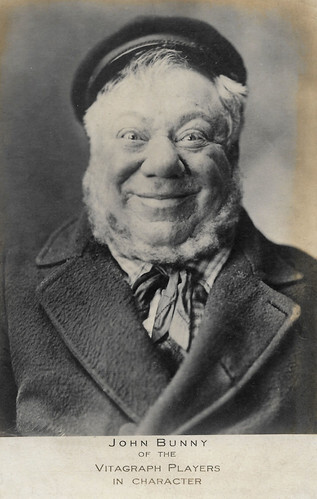
British postcard. Caption: John Bunny of the Vitagraph Players in character.
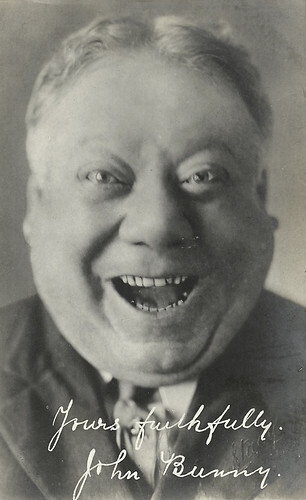
British postcard.
An extensive and extremely flexible face
John Bunny was born in New York City, N.Y., in 1863. He was the ninth in a line of English sea captains and would be the first not to follow in that profession. He grew up in Brooklyn, where he attended St. James High School and worked as a grocery store clerk before joining a small minstrel show that toured the West Coast.
He appeared in musical comedies such as 'Old Dutch' with Hattie Williams and Lew Fields. He also worked as a stage manager for various stock companies. He continued to combine this work for various companies with stage performances in vaudeville shows before being attracted to the then-nascent film industry.
By 1909 he was already under contract to Vitagraph. This was a bold step. Not only was it a major step down for a 'legitimate' stage actor to go into the 'flickers' at that time, but Bunny took a pay cut from $150 to $40 a week to work for Vitagraph. But soon, his character as a well-fed, carefree man quickly made him an international silent comedy star.
With Vitagraph he took part in a series of more than two hundred comedies, forming a popular pair with actress Flora Finch. Finch contrasted with Bunny's figure by being tall and thin. They usually appeared as Mr. & Mrs. Bunny. Their shorts were referred to as 'Bunnygraphs' or 'Bunnyfinches'. Bunny and Finch stayed away from physical comedy and their films dealt with relationships, usually the man getting away with something that his wife disagrees with.
Other regulars in the Bunny comedies at Vitagraph were Charles Eldridge, William O'Shea, Hughie Mack, Wally Van, Lilian Walker, Julia Swayne Gordon, Edith Storey, and the future Hollywood stars Norma Talmadge and Clara Kimball Young. Laurence 'Larry' Trimble directed most of the comedy shorts, while also Fred. Thomson, Wilfrid North and George D. Baker directed.
The London-based Saturday Review wrote about him in 1913: “When Mr. Bunny laughs, people from San Francisco to Stepney Green laugh with him. When he frowns, every kingdom of the earth is contracted in one brow of woe. His despair is incredible. His grief is unendurable. His wrath is apoplectic. His terror is the panic of a whole army.” That was a bit exaggerated, but Bunny's pantomime was greatly appreciated.
In 1914 John Palmer wrote in the same magazine: "Mr. Bunny has an extensive and extremely flexible face. [...] We know at once why Mr. Bunny never speaks. He could not possibly find words to convey the extremity of his feelings."
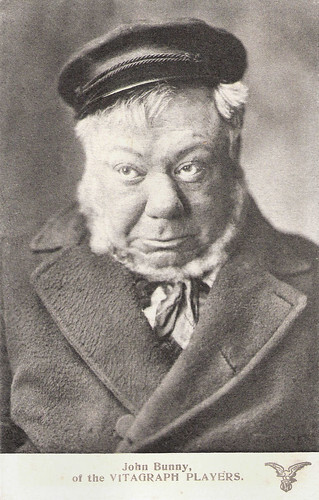
British postcard. Photo: Vitagraph. Caption: Read "The Pictures" weekly, 1 d.".
A natural for Mr. Pickwick
Jack Lodge, in his study 'The Huge Appeal of John Bunny' writes: “John Bunny was a natural for Mr. Pickwick, and in 1913 he played the part. Vitagraph had seen a chance to increase the already great popularity of Bunny in England by sending him to film there, accompanied by his usual director, Larry Trimble.
The voyage across provided a film – Bunny All at Sea (1912) – in which Bunny was the only professional, other parts being taken by passengers. Vitagraph emerged with a useful comedy – Bunny posing as the Captain…Bunny being arrested and set to degrading menial work – and also saved a lot of money.”
The film The Pickwick Papers, a three-reeler by Laurence Trimble based on Charles Dicken's classic tale, was released by Vitagraph in 1913 and had Arthur Ricketts as the antagonist Mr. Jingle.
A sequel was also produced: The Adventure of the Shooting Party, again with Bunny and Ricketts, directed by Trimble and based on Dickens. Despite what the Italian Wikipedia writes, Bunny's comedy was not slapstick, crass and circus-inspired but polite, middle-class, situational comedy, often situated in domestic settings.
Unfortunately, Bunny was disliked by most of her fellow actors at Vitagraph, including Flora Finch. Interviews conducted by Anthony Slide in the 1960s and 1970s with former employees of the company revealed that they found him arrogant, short-tempered and generally difficult to work with, a picture in complete contrast to the image of him that is remembered on screen.
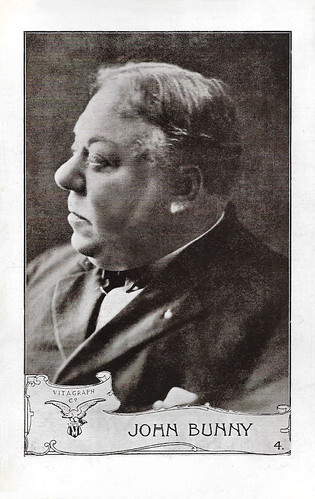
British postcard, no. 4. Photo: Vitagraph.
Almost completely forgotten
In 1890, John Bunny married Clara Scallan, with whom he had two sons, George and John Jr, who also later became actors. His brother George Bunny was also an actor.
John Bunny, whose film career only took five years, died of kidney disease in 1915. Bunny was only 51. He was buried at the Cemetery of the Evergreens in Brooklyn.
Thanks to the fact that silent films knew no language barriers and to his great popularity, the news of his death occupied the front pages of both American and European newspapers. The New York Times stated, "The name John Bunny will always be linked to the movies." He was so popular in Russia that they created a series with an impersonator using the name 'Poxon' after Bunny died.
After Bunny's death, the technological advances and innovations brought about by the possibility of performing acrobatic acts soon brought new stars into the world of silent comedy and Bunny was almost completely forgotten. However, for his great contribution to the development of the film industry, a star has been dedicated to him on the Hollywood Walk of Fame at 1715 Vine Street.
For a long time, most historians thought that only a handful of Bunny's films had survived. But several of the Bunny and Finch comedies have been discovered in the Desmet Collection of the Eye Filmmuseum in the Netherlands. You can see them on Eye's YouTube section, such as Stenographer's Troubles, A Stenographer Wanted, Mr. Bolter's Infatuation, Bunny's Suicide, Bunny in Disguise, Pumps, Freckles, Troublesome Stepdaughters, Those Troublesome Tresses, Doctor Bridget, The Pickpocket, and Tangled Tangoists.
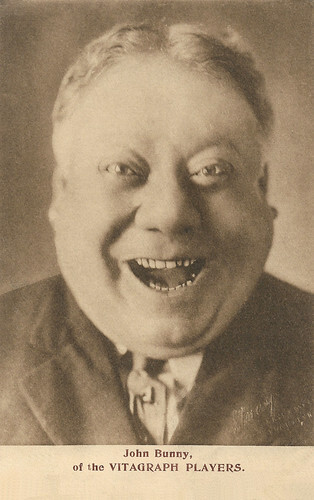
British postcard. Photo: Stacey / Vitagraph.
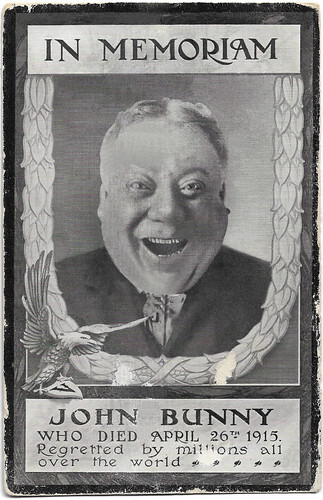
British postcard.
Sources: (IMDb), Wikipedia (Italian and English), and .

British postcard. Caption: John Bunny of the Vitagraph Players in character.

British postcard.
An extensive and extremely flexible face
John Bunny was born in New York City, N.Y., in 1863. He was the ninth in a line of English sea captains and would be the first not to follow in that profession. He grew up in Brooklyn, where he attended St. James High School and worked as a grocery store clerk before joining a small minstrel show that toured the West Coast.
He appeared in musical comedies such as 'Old Dutch' with Hattie Williams and Lew Fields. He also worked as a stage manager for various stock companies. He continued to combine this work for various companies with stage performances in vaudeville shows before being attracted to the then-nascent film industry.
By 1909 he was already under contract to Vitagraph. This was a bold step. Not only was it a major step down for a 'legitimate' stage actor to go into the 'flickers' at that time, but Bunny took a pay cut from $150 to $40 a week to work for Vitagraph. But soon, his character as a well-fed, carefree man quickly made him an international silent comedy star.
With Vitagraph he took part in a series of more than two hundred comedies, forming a popular pair with actress Flora Finch. Finch contrasted with Bunny's figure by being tall and thin. They usually appeared as Mr. & Mrs. Bunny. Their shorts were referred to as 'Bunnygraphs' or 'Bunnyfinches'. Bunny and Finch stayed away from physical comedy and their films dealt with relationships, usually the man getting away with something that his wife disagrees with.
Other regulars in the Bunny comedies at Vitagraph were Charles Eldridge, William O'Shea, Hughie Mack, Wally Van, Lilian Walker, Julia Swayne Gordon, Edith Storey, and the future Hollywood stars Norma Talmadge and Clara Kimball Young. Laurence 'Larry' Trimble directed most of the comedy shorts, while also Fred. Thomson, Wilfrid North and George D. Baker directed.
The London-based Saturday Review wrote about him in 1913: “When Mr. Bunny laughs, people from San Francisco to Stepney Green laugh with him. When he frowns, every kingdom of the earth is contracted in one brow of woe. His despair is incredible. His grief is unendurable. His wrath is apoplectic. His terror is the panic of a whole army.” That was a bit exaggerated, but Bunny's pantomime was greatly appreciated.
In 1914 John Palmer wrote in the same magazine: "Mr. Bunny has an extensive and extremely flexible face. [...] We know at once why Mr. Bunny never speaks. He could not possibly find words to convey the extremity of his feelings."

British postcard. Photo: Vitagraph. Caption: Read "The Pictures" weekly, 1 d.".
A natural for Mr. Pickwick
Jack Lodge, in his study 'The Huge Appeal of John Bunny' writes: “John Bunny was a natural for Mr. Pickwick, and in 1913 he played the part. Vitagraph had seen a chance to increase the already great popularity of Bunny in England by sending him to film there, accompanied by his usual director, Larry Trimble.
The voyage across provided a film – Bunny All at Sea (1912) – in which Bunny was the only professional, other parts being taken by passengers. Vitagraph emerged with a useful comedy – Bunny posing as the Captain…Bunny being arrested and set to degrading menial work – and also saved a lot of money.”
The film The Pickwick Papers, a three-reeler by Laurence Trimble based on Charles Dicken's classic tale, was released by Vitagraph in 1913 and had Arthur Ricketts as the antagonist Mr. Jingle.
A sequel was also produced: The Adventure of the Shooting Party, again with Bunny and Ricketts, directed by Trimble and based on Dickens. Despite what the Italian Wikipedia writes, Bunny's comedy was not slapstick, crass and circus-inspired but polite, middle-class, situational comedy, often situated in domestic settings.
Unfortunately, Bunny was disliked by most of her fellow actors at Vitagraph, including Flora Finch. Interviews conducted by Anthony Slide in the 1960s and 1970s with former employees of the company revealed that they found him arrogant, short-tempered and generally difficult to work with, a picture in complete contrast to the image of him that is remembered on screen.

British postcard, no. 4. Photo: Vitagraph.
Almost completely forgotten
In 1890, John Bunny married Clara Scallan, with whom he had two sons, George and John Jr, who also later became actors. His brother George Bunny was also an actor.
John Bunny, whose film career only took five years, died of kidney disease in 1915. Bunny was only 51. He was buried at the Cemetery of the Evergreens in Brooklyn.
Thanks to the fact that silent films knew no language barriers and to his great popularity, the news of his death occupied the front pages of both American and European newspapers. The New York Times stated, "The name John Bunny will always be linked to the movies." He was so popular in Russia that they created a series with an impersonator using the name 'Poxon' after Bunny died.
After Bunny's death, the technological advances and innovations brought about by the possibility of performing acrobatic acts soon brought new stars into the world of silent comedy and Bunny was almost completely forgotten. However, for his great contribution to the development of the film industry, a star has been dedicated to him on the Hollywood Walk of Fame at 1715 Vine Street.
For a long time, most historians thought that only a handful of Bunny's films had survived. But several of the Bunny and Finch comedies have been discovered in the Desmet Collection of the Eye Filmmuseum in the Netherlands. You can see them on Eye's YouTube section, such as Stenographer's Troubles, A Stenographer Wanted, Mr. Bolter's Infatuation, Bunny's Suicide, Bunny in Disguise, Pumps, Freckles, Troublesome Stepdaughters, Those Troublesome Tresses, Doctor Bridget, The Pickpocket, and Tangled Tangoists.

British postcard. Photo: Stacey / Vitagraph.

British postcard.
Sources: (IMDb), Wikipedia (Italian and English), and .
Published on November 14, 2022 22:00
November 13, 2022
Gentlemen Prefer Blondes (1953)
Gentlemen Prefer Blondes (1953) is a dazzling musical comedy directed by Howard Hawks and starring Marilyn Monroe, Jane Russell and Charles Coburn. The film is based on the 1949 Broadway musical of the same name, which was inspired by the novel 'Gentlemen Prefer Blondes: The Illuminating Diary of a Professional Lady' by Anita Loos. Immediately, the film was a huge success in cinemas. The song 'Diamonds Are a Girl's Best Friend' sung by Monroe in the film became a classic and inspired later artists such as Madonna, Kylie Minogue, and Nicole Kidman.
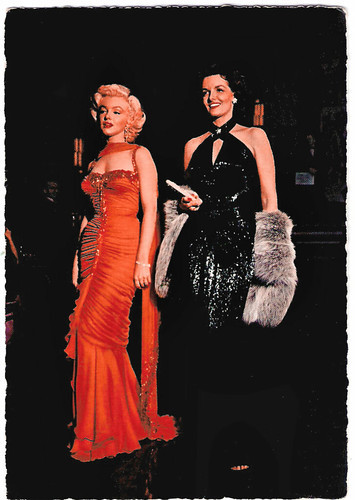
West-German postcard by Krüger, no. 902/14. Photo: West-German postcard by Krüger, no. 902/14. Photo: Marilyn Monroe and Jane Russell in Gentlemen Prefer Blondes (Howard Hawks, 1953).
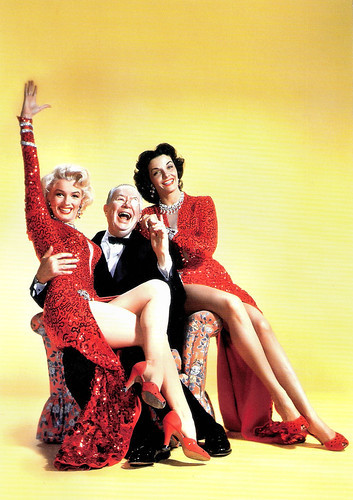
Italian programme card for Il Cinema Ritrovata 2011. Photo: Marilyn Monroe , Charles Coburn and Jane Russell in Gentlemen Prefer Blondes (Howard Hawks, 1953) with.
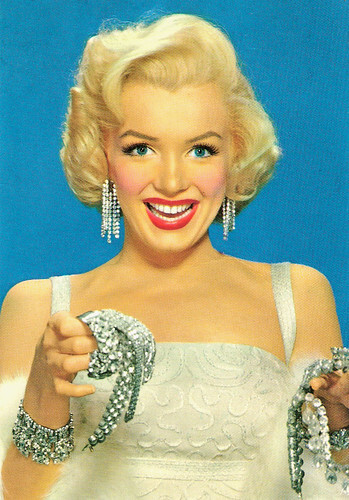
British postcard by Santoro Graphics, London, no. C213. Photo: Marilyn Monroe in Gentlemen Prefer Blondes (Howard Hawks, 1953).
Showgirls and rich men
Lorelei Lee ( Marilyn Monroe ) and Dorothy Shaw ( Jane Russell ) are colleagues and good friends. They work as showgirls and have the attention of several - often rich - men. Lorelei is even engaged to wealthy Gus Esmond (Tommy Noonan), who will do anything for her.
When Gus wants to take Lorelei to France to get married, he is stopped by his father who does not trust Lorelei. The disappointed Lorelei goes to France by boat anyway and asks Dorothy along. What she does not know, however, is that Esmond's father has sent a private detective along to catch Lorelei in adultery. However, the detective, Ernie Malone (Elliott Reid), falls in love with Dorothy, while Lorelei gets warm feelings from British Sir Francis Beekman (Charles Coburn), nicknamed 'Piggy', the owner of a diamond mine.
When Lorelei is flirting with the married Piggy, Malone secretly takes pictures of them. However, he is spotted by Dorothy and she and Lorelei steal the film from the camera. In gratitude, Piggy gives his wife's diamond tiara to Lorelei. But Malone later reveals that he also took tape recordings. Dorothy now pretends to be in love with Malone.
Once in France, Piggy's wife Lady Beekman (Norma Varden) accuses Lorelei of stealing the tiara. When Gus Esmond learns of this, he revokes Lorelei's credit card. Destitute, the girls now have to work in a nightclub. However, Piggy steals Lorelei's tiara and when the latter is arrested by the police and wants to return the jewel, she is in good trouble.
Gus comes to France and Dorothy tells him to help Lorelei buy a new tiara. In the meantime, she takes Lorelei's place, wearing a fake blonde wig and trying to buy time in court. Malone and Gus's father (Taylor Holmes) have to testify against Lorelei. However, Dorothy tells Malone that she will hate him forever if he does and he withdraws. Lorelei/Dorothy is acquitted and the real Lorelei manages to convince Gus's father that she is not stupid and vain and he gives his blessing for marriage.
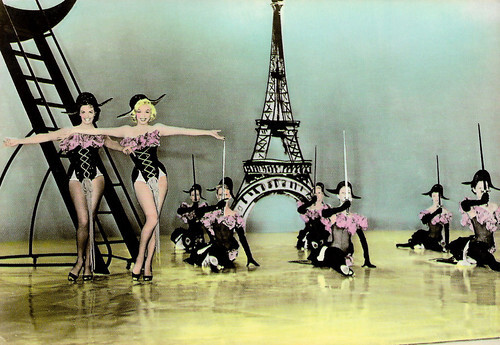
American postcard by Classico San Francisco, Inc., no. 105-009. Photo: Twentieth Century-Fox. Marilyn Monroe and Jane Russell in Gentlemen Prefer Blondes (Howard Hawks, 1955). This scene is cut from the actual film. You can still see Lorelei and Dorothy wearing these costumes in the Paris nightclub scene when Gus comes to ask Lorelei for an apology. Of course, Lorelei and Dorothy answer with their 'Diamonds are a girl's best friend' number.
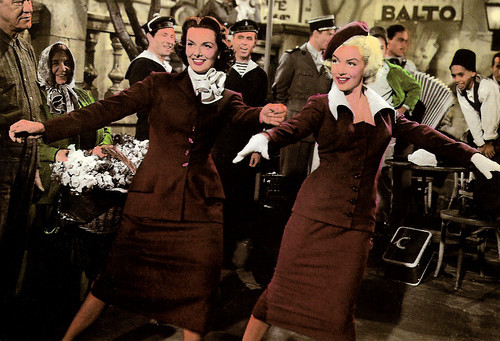
American postcard by Classico, San Francisco, no. 105-010. Photo: Twentieth Century-Fox. Marilyn Monroe and Jane Russell in Gentlemen Prefer Blondes (Howard Hawks, 1953).
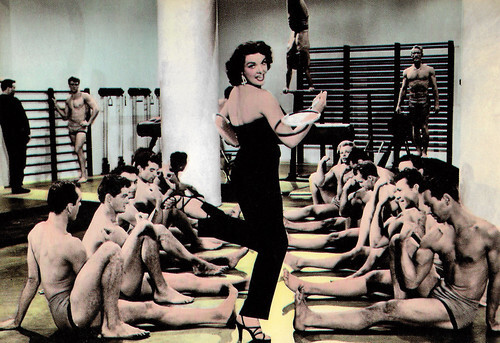
American postcard by Classico San Francisco, Inc., no. 105-011. Photo: Twentieth Century-Fox. Jane Russell in Gentlemen Prefer Blondes (Howard Hawks, 1955).
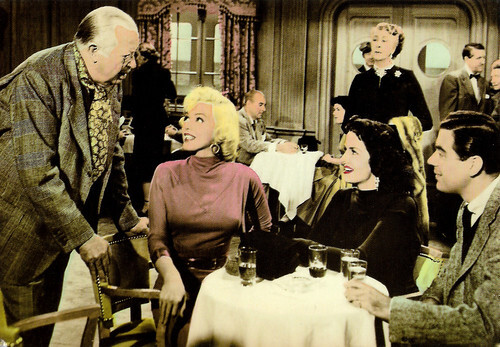
American postcard by Classico San Francisco, Inc., no. 105-013. Photo: Twentieth Century-Fox. Charles Coburn, Marilyn Monroe , Jane Russell, Norma Varden and Elliott Reid in Gentlemen Prefer Blondes (Howard Hawks, 1955).
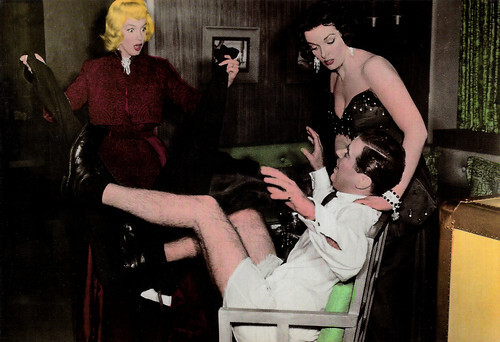
American postcard by Classico San Francisco, Inc., no. 105-015. Photo: Twentieth Century-Fox. Marilyn Monroe , Jane Russell and Elliott Reid in Gentlemen Prefer Blondes (Howard Hawks, 1955).
But I'm still the blonde
The screenplay for Gentlemen Prefer Blondes (1953) was inspired by the book 'Gentlemen Prefer Blondes: The Illuminating Diary of a Professional Lady' by Anita Loos. It was based on a sea voyage Anita Loos made from the US to Europe. The book was adapted for the stage in 1926 and made into a silent film in 1928, starring Ruth Taylor and Alice White . In 1949, a Broadway musical based on the book was produced under the title 'Gentlemen Prefer Blondes'. It was directed by John C. Wilson and Carol Channing played the role of Lorelei Lee. The musical was a great success and played 740 times on Broadway. Charles Lederer based his screenplay on Loos' book and the musical.
The musical was originally bought by 20th Century Fox to star Betty Grable . But Grable was earning $150,000 per film and the studio began to look around for a cheaper sex symbol. Soon their eye fell on Marilyn Monroe , who had just given an impressive performance in Niagara and was only getting $18,000 per film. To prevent all the pressure falling on Monroe, Jane Russell was chosen for the role of Dorothy. Russell who had been around much longer than Monroe was a star and received $200,000 for her role. When Monroe heard that not she but Russell was the star, she said, "but I'm still the blonde." She was upset at the disrespect she received from the studio, especially when attempts were also made to cast Judy Holliday as Lorelei.
Gentlemen Prefer Blondes was a musical and Monroe now had to sing as well as dance. Gwen Verdon was appointed as Monroe and Russell's dance coach. It was all new to Monroe who, however, worked extremely hard to master the dancing. Every night, after everyone had left the studio, Monroe went to practice to learn the steps for the next day. Unfortunately, this meant she got too little sleep and was regularly late when recording began in the morning. Howard Hawks became impatient, especially as Monroe often refused to come out of her dressing room as well. According to Russell, this was due to stage fright and she did her best to accompany Monroe from the dressing room to the set. The two women soon liked each other and became friends, with Russell protecting Monroe from the outside world. She found Monroe "shy and sweet" and much more intelligent than some people thought.
Director Howard Hawks thought otherwise. Monroe often held back the production with her lateness and other quirks. For instance, she insisted that recorded scenes already approved by Hawks had to be re-filmed because she was not satisfied. Hawks was mad and when the studio asked if he could get along, he sarcastically said, "you can replace Monroe, rewrite the screenplay and hire a new director". The studio itself also had reservations about Monroe. They thought about having her voice re-recorded by Marni Nixon because they thought Monroe's sound was silly. Nixon thought this was ridiculous and advocated using Monroe's voice precisely because it suited the character of Lorelei so well.
In the end, Nixon only sang in the "no, no, nos" at the beginning of the song. By now, Jane Russell had been in the film business for so long that the studio did not dare to take her on. However, Russell did provide an unexpected stunt when she accidentally fell into the pool during filming. The troubled Hawks saw the incident while showing the raw, unedited dailies. It made him laugh a lot and he decided to include the scene in the film. The ship on which Lorelei and Dorothy travel to France is the SS Île-de-France. The studio used sets from the film Titanic (1953) that had been used shortly before.
The film did well in cinemas, turning a $12 million turnover. Critics were also generally appreciative of the film. The new Monroe and Russell duo was praised and the studio had big plans to cast both actresses together again. In the end, however, it would remain with this film. In 1955, the sequel was released under the title Gentlemen Marry Brunettes, without Monroe but with Russell and Jeanne Crain. It was not a success.
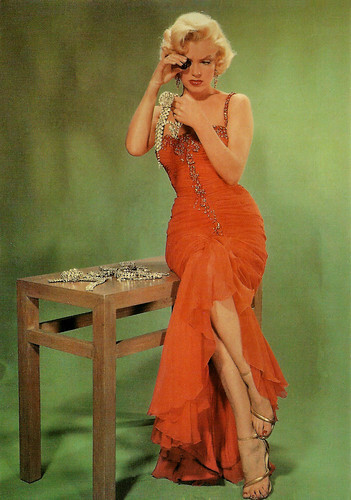
French postcard, no. Réf. Marilyn 97. Marilyn Monroe in Gentlemen Prefer Blondes (Howard Hawks, 1953).
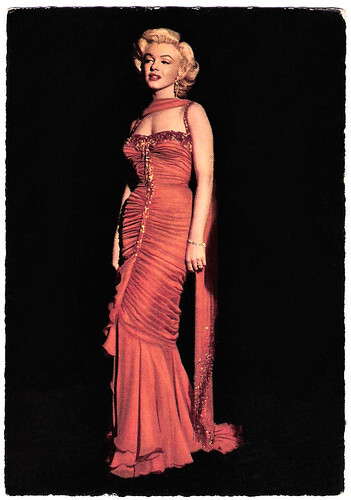
West-German postcard by Krüger, no. 902/13. Photo: publicity still for Gentlemen Prefer Blondes (Howard Hawks, 1953).
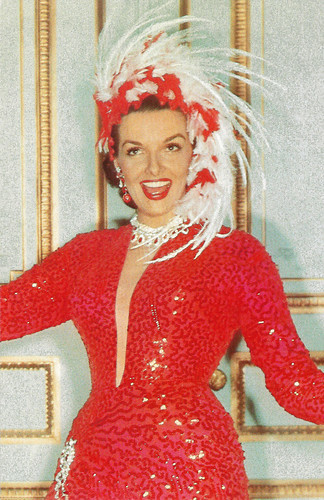
American postcard in the Demac Collection. Photo: Jane Russell in Gentlemen Prefer Blondes (Howard Hawks, 1953).
Sources: Wikipedia (Dutch) and IMDb.

West-German postcard by Krüger, no. 902/14. Photo: West-German postcard by Krüger, no. 902/14. Photo: Marilyn Monroe and Jane Russell in Gentlemen Prefer Blondes (Howard Hawks, 1953).

Italian programme card for Il Cinema Ritrovata 2011. Photo: Marilyn Monroe , Charles Coburn and Jane Russell in Gentlemen Prefer Blondes (Howard Hawks, 1953) with.

British postcard by Santoro Graphics, London, no. C213. Photo: Marilyn Monroe in Gentlemen Prefer Blondes (Howard Hawks, 1953).
Showgirls and rich men
Lorelei Lee ( Marilyn Monroe ) and Dorothy Shaw ( Jane Russell ) are colleagues and good friends. They work as showgirls and have the attention of several - often rich - men. Lorelei is even engaged to wealthy Gus Esmond (Tommy Noonan), who will do anything for her.
When Gus wants to take Lorelei to France to get married, he is stopped by his father who does not trust Lorelei. The disappointed Lorelei goes to France by boat anyway and asks Dorothy along. What she does not know, however, is that Esmond's father has sent a private detective along to catch Lorelei in adultery. However, the detective, Ernie Malone (Elliott Reid), falls in love with Dorothy, while Lorelei gets warm feelings from British Sir Francis Beekman (Charles Coburn), nicknamed 'Piggy', the owner of a diamond mine.
When Lorelei is flirting with the married Piggy, Malone secretly takes pictures of them. However, he is spotted by Dorothy and she and Lorelei steal the film from the camera. In gratitude, Piggy gives his wife's diamond tiara to Lorelei. But Malone later reveals that he also took tape recordings. Dorothy now pretends to be in love with Malone.
Once in France, Piggy's wife Lady Beekman (Norma Varden) accuses Lorelei of stealing the tiara. When Gus Esmond learns of this, he revokes Lorelei's credit card. Destitute, the girls now have to work in a nightclub. However, Piggy steals Lorelei's tiara and when the latter is arrested by the police and wants to return the jewel, she is in good trouble.
Gus comes to France and Dorothy tells him to help Lorelei buy a new tiara. In the meantime, she takes Lorelei's place, wearing a fake blonde wig and trying to buy time in court. Malone and Gus's father (Taylor Holmes) have to testify against Lorelei. However, Dorothy tells Malone that she will hate him forever if he does and he withdraws. Lorelei/Dorothy is acquitted and the real Lorelei manages to convince Gus's father that she is not stupid and vain and he gives his blessing for marriage.

American postcard by Classico San Francisco, Inc., no. 105-009. Photo: Twentieth Century-Fox. Marilyn Monroe and Jane Russell in Gentlemen Prefer Blondes (Howard Hawks, 1955). This scene is cut from the actual film. You can still see Lorelei and Dorothy wearing these costumes in the Paris nightclub scene when Gus comes to ask Lorelei for an apology. Of course, Lorelei and Dorothy answer with their 'Diamonds are a girl's best friend' number.

American postcard by Classico, San Francisco, no. 105-010. Photo: Twentieth Century-Fox. Marilyn Monroe and Jane Russell in Gentlemen Prefer Blondes (Howard Hawks, 1953).

American postcard by Classico San Francisco, Inc., no. 105-011. Photo: Twentieth Century-Fox. Jane Russell in Gentlemen Prefer Blondes (Howard Hawks, 1955).

American postcard by Classico San Francisco, Inc., no. 105-013. Photo: Twentieth Century-Fox. Charles Coburn, Marilyn Monroe , Jane Russell, Norma Varden and Elliott Reid in Gentlemen Prefer Blondes (Howard Hawks, 1955).

American postcard by Classico San Francisco, Inc., no. 105-015. Photo: Twentieth Century-Fox. Marilyn Monroe , Jane Russell and Elliott Reid in Gentlemen Prefer Blondes (Howard Hawks, 1955).
But I'm still the blonde
The screenplay for Gentlemen Prefer Blondes (1953) was inspired by the book 'Gentlemen Prefer Blondes: The Illuminating Diary of a Professional Lady' by Anita Loos. It was based on a sea voyage Anita Loos made from the US to Europe. The book was adapted for the stage in 1926 and made into a silent film in 1928, starring Ruth Taylor and Alice White . In 1949, a Broadway musical based on the book was produced under the title 'Gentlemen Prefer Blondes'. It was directed by John C. Wilson and Carol Channing played the role of Lorelei Lee. The musical was a great success and played 740 times on Broadway. Charles Lederer based his screenplay on Loos' book and the musical.
The musical was originally bought by 20th Century Fox to star Betty Grable . But Grable was earning $150,000 per film and the studio began to look around for a cheaper sex symbol. Soon their eye fell on Marilyn Monroe , who had just given an impressive performance in Niagara and was only getting $18,000 per film. To prevent all the pressure falling on Monroe, Jane Russell was chosen for the role of Dorothy. Russell who had been around much longer than Monroe was a star and received $200,000 for her role. When Monroe heard that not she but Russell was the star, she said, "but I'm still the blonde." She was upset at the disrespect she received from the studio, especially when attempts were also made to cast Judy Holliday as Lorelei.
Gentlemen Prefer Blondes was a musical and Monroe now had to sing as well as dance. Gwen Verdon was appointed as Monroe and Russell's dance coach. It was all new to Monroe who, however, worked extremely hard to master the dancing. Every night, after everyone had left the studio, Monroe went to practice to learn the steps for the next day. Unfortunately, this meant she got too little sleep and was regularly late when recording began in the morning. Howard Hawks became impatient, especially as Monroe often refused to come out of her dressing room as well. According to Russell, this was due to stage fright and she did her best to accompany Monroe from the dressing room to the set. The two women soon liked each other and became friends, with Russell protecting Monroe from the outside world. She found Monroe "shy and sweet" and much more intelligent than some people thought.
Director Howard Hawks thought otherwise. Monroe often held back the production with her lateness and other quirks. For instance, she insisted that recorded scenes already approved by Hawks had to be re-filmed because she was not satisfied. Hawks was mad and when the studio asked if he could get along, he sarcastically said, "you can replace Monroe, rewrite the screenplay and hire a new director". The studio itself also had reservations about Monroe. They thought about having her voice re-recorded by Marni Nixon because they thought Monroe's sound was silly. Nixon thought this was ridiculous and advocated using Monroe's voice precisely because it suited the character of Lorelei so well.
In the end, Nixon only sang in the "no, no, nos" at the beginning of the song. By now, Jane Russell had been in the film business for so long that the studio did not dare to take her on. However, Russell did provide an unexpected stunt when she accidentally fell into the pool during filming. The troubled Hawks saw the incident while showing the raw, unedited dailies. It made him laugh a lot and he decided to include the scene in the film. The ship on which Lorelei and Dorothy travel to France is the SS Île-de-France. The studio used sets from the film Titanic (1953) that had been used shortly before.
The film did well in cinemas, turning a $12 million turnover. Critics were also generally appreciative of the film. The new Monroe and Russell duo was praised and the studio had big plans to cast both actresses together again. In the end, however, it would remain with this film. In 1955, the sequel was released under the title Gentlemen Marry Brunettes, without Monroe but with Russell and Jeanne Crain. It was not a success.

French postcard, no. Réf. Marilyn 97. Marilyn Monroe in Gentlemen Prefer Blondes (Howard Hawks, 1953).

West-German postcard by Krüger, no. 902/13. Photo: publicity still for Gentlemen Prefer Blondes (Howard Hawks, 1953).

American postcard in the Demac Collection. Photo: Jane Russell in Gentlemen Prefer Blondes (Howard Hawks, 1953).
Sources: Wikipedia (Dutch) and IMDb.
Published on November 13, 2022 22:00
November 12, 2022
Directed by Josef von Sternberg
Austrian-American film director Josef von Sternberg (1894-1969) is known as a great stylist, as the director of the prototypical Hollywood gangster film, Underworld (1927), and especially as the discoverer of Marlene Dietrich. He worked with her for the first time at the Ufa in Der blaue Engel/The Blue Angel (1930) and would subsequently make six more films with her in Hollywood. He was nominated for the Academy Award for Best Director for Morocco (1930) and Shanghai Express (1932). Along with Erich von Stroheim, Friedrich Wilhelm Murnau, Fritz Lang, Ernst Lubitsch and Billy Wilder, Von Sternberg belonged to the large group of German and Austrian film emigrants who helped to shape Hollywood cinema.
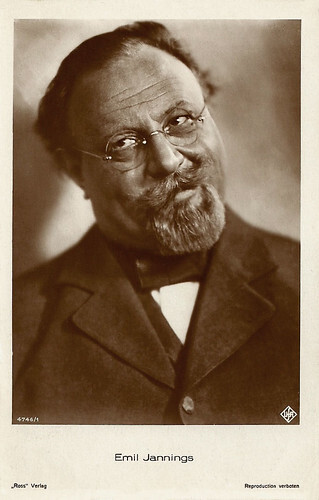
German postcard by Ross Verlag, no. 4746/1, 1929-1930. Photo: Ufa. Emil Jannings in Der blaue Engel/The Blue Angel (Josef von Sternberg, 1930).
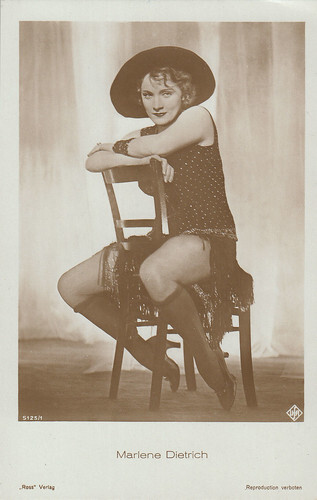
German postcard by Ross Verlag, no. 5125/1, 1930-1931. Photo: Ufa. Marlene Dietrich in Der blaue Engel/The Blue Angel (Josef von Sternberg, 1930) Collection: Marlene Pilaete.
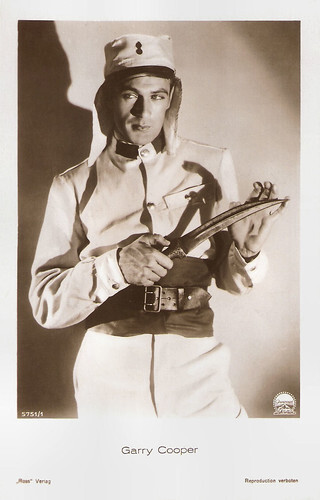
German postcard by Ross Verlag, no. 5751/1, 1930-1931. Photo: Paramount. Gary Cooper in Morocco (Josef von Sternberg, 1930). Caption: Garry Cooper (sic).
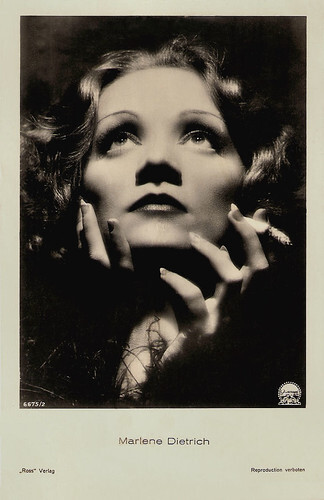
German postcard by Ross Verlag, no. 6673/2, 1931-1932. Photo: Don English / Paramount. Marlene Dietrich in Shanghai Express (Josef von Sternberg, 1932).
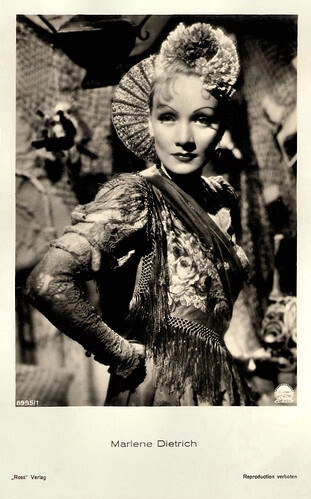
German postcard by Ross Verlag, no. 8995/1, 1933-1934. Photo: Paramount. Marlene Dietrich in The Devil is a Woman (Josef von Sternberg, 1935).
A symphony of shadows and lighting effects
Josef von Sternberg was born as Jonas Sternberg in 1894, in Vienna, at that time part of the Austro-Hungarian Empire. Sternberg was the son of Moses Sternberg, an impoverished Jewish businessman from Krakow and former soldier in the army of Austria-Hungary, and his wife Serafine, née Singer. The family moved to the U.S. in 1901. Jonas attended public school until the family, except Moses, returned to Vienna three years later. Throughout his life, Sternberg carried vivid memories of Vienna and nostalgia for some of his happiest childhood moments.
In 1908, when Jonas was fourteen, he returned with his mother to Queens, New York, and settled in the United States. He acquired American citizenship in 1908. After a year, he stopped attending Jamaica High School and began working in various occupations, including millinery apprentice, door-to-door trinket salesman and stock clerk at a lace factory. At the age of 17, he started to work at the World Film Company in Fort Lee, New Jersey, as a film repairer and projectionist under the stage name Josef Sternberg. In 1914, when the company was purchased by actor and film producer William A. Brady, Sternberg rose to chief assistant, responsible for writing (inter)titles and editing films to cover lapses in continuity for which he received his first official film credits.
When the United States entered World War I in 1917, he joined the US Army and was assigned to the Signal Corps headquartered in Washington, D.C., where he photographed training films for recruits. Shortly after the war, Sternberg left Brady's Fort Lee operation and worked for various studios. Sternberg travelled widely in Europe between 1922 and 1924, where he worked for the short-lived Alliance Film Corporation in London, on such films as The Bohemian Girl (Harley Knoles, 1922).
When he returned to California in 1924, he started as an assistant to director Roy William Neill's Vanity's Price. Sternberg's aptitude for effective directing was recognized in his handling of the operating room scene, singled out for special mention by New York Times critic Mordaunt Hall. Through the agency of Charles Chaplin and Mary Pickford , he met the German writer and screenwriter Karl Gustav Vollmoeller, who invited him to Venice and Berlin in 1925 and introduced him to the actor Emil Jannings .
With actor George K. Arthur, he made The Salvation Hunters (1925) for only US $4,800, which was filmed on a large steam dredge in the marshes near San Pedro Bay. It depicted three young drifters who struggle to survive in a dystopian landscape. The film caught the attention of some critics who praised Sternberg's innovative use of light and shadow in the dramatisation of a scene. Plans to make a film with Mary Pickford subsequently fell through, but in the end von Sternberg was offered a contract by MGM.
Signing an eight-film agreement with Metro-Goldwyn-Mayer in 1925, Sternberg entered into the increasingly rigid studio system at MGM, and the cooperation with the studio executives and the stars was not easy. During the shooting of The Masked Bride (1925), Von Sternberg, who was notorious for being autocratic, argued violently with the leading actress Mae Murray for weeks. Eventually the contract was terminated by mutual agreement and the film was directed by Christy Cabanne.
A short time later he received an offer by Charles Chaplin to make the film A Woman of the Sea/The Sea Gull (Josef von Sternberg, 1926) as a comeback vehicle for Edna Purviance, Chaplin's former leading lady. However, Chaplin decided not to distribute the finished film as he considered it a "highly visual, almost Expressionistic" work, completely lacking in the humanism that he had anticipated". In the 1930s, Chaplin had the negative destroyed in order to be able to deduct the filming costs from his taxes.
The tide turned for Von Sternberg when he got a contract with Paramount in 1927. After he had successfully re-produced some scenes for films that had already been shot, such as Children of Divorce (Frank Lloyd, 1927), with Clara Bow , he got the chance to shoot the film Underworld later that year. The script about Chicago gangsters by journalist Ben Hecht took a concerned look behind the scenes of organised crime for the first time and Von Sternberg turned it into a gripping gangster film. At the same time, he composed scenes out of light and shadow that prompted one critic to remark that von Sternberg used the camera the way a painter uses his brush. The film was an enormous box-office hit and Academy Award winner for Best Original Story.
After this overwhelming commercial success, Paramount gave Von Sternberg a free hand with the direction of The Last Command (Josef von Sternberg, 1928), which was shot with Emil Jannings , the studio's most valuable star. A year later, Jannings won the Oscar in the Best Actor in a Leading Role category for hhis performance, the first actor to do so. In the same year followed the drama The Docks of New York (Josef von Sternberg, 1928) starring George Bancroft , Betty Compson , and Olga Baclanova , one of the most mature and visually beautiful films of his career. The story about a sailor and a prostitute was transformed by Von Sternberg into a symphony of shadows and lighting effects.
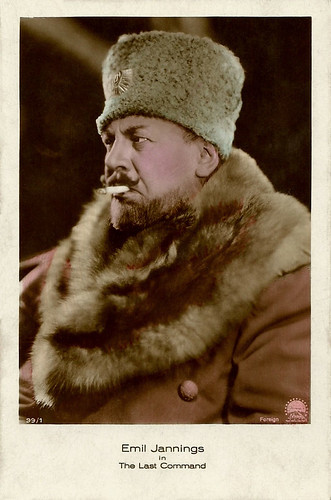
German postcard by Ross Verlag, Foreign, no. 99/1. Photo: Paramount. Emil Jannings in The Last Command (Josef von Sternberg, 1928).

German postcard by Ross Verlag, no. 99/6. Photo: Paramount. Evelyn Brent and Emil Jannings in The Last Command (Josef von Sternberg, 1928).
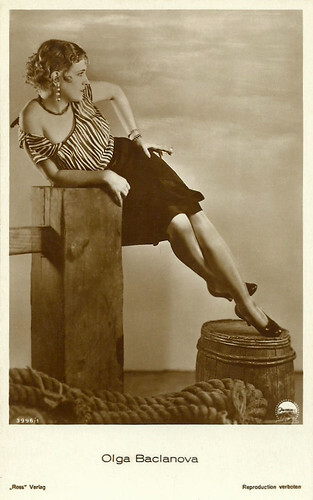
German postcard by Ross Verlag, no. 3946, 1928-1929. Photo: Paramount. Olga Baclanova in The Docks of New York (Josef von Sternberg, 1928). Collection: Didier Hanson.
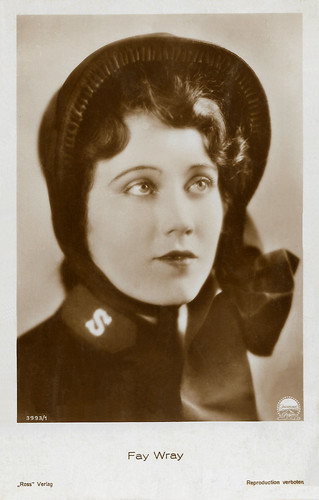
German postcard by Ross Verlag, no. 3993/1, 1928-1929. Photo: Paramount. Fay Wray in Street of Sin (Mauritz Stiller, Josef von Sternberg uncredited, 1928).

German postcard by Ross Verlag, no. 4329/1, 1929-1930. Photo: Paramount. Esther Ralston in The Case of Lena Smith (Josef von Sternberg, 1929).
The eternal seductress
In 1929, Josef von Sternberg went to Germany to film the first sound film with star Emil Jannings at Paramount'sister studio Ufa. The contract with Ufa was brokered by Karl Gustav Vollmoeller, who was placed at his side by Ufa as screenwriter, technical advisor and general editor. It was also thanks to him that the film rights of the novel 'Professor Unrat' by Heinrich Mann were sold to Ufa under the title Der blaue Engel/The Blue Angel (Josef von Sternberg, 1930). The female lead was initially to be given to a wide variety of actresses, including Louise Brooks . But in the end the choice fell on Marlene Dietrich as Lola Lola, the nemesis of Emil Jannings 's character Professor Immanuel Rath. Sternberg's romantic infatuation with his new star created difficulties on and off the set. Jannings strenuously objected to Sternberg's lavish attention to Dietrich's performance, at the elder actor's expense. Dietrich became an international star overnight.
The director and his new star left for America the same evening as the premiere, where they began shooting Morocco (Josef von Sternberg, 1930) with Gary Cooper . Dietrich was built up by the studio as an answer to Greta Garbo , but Von Sternberg turned the actress into a screen personality all her own over the course of their six Hollywood films together: Morocco (1930), Dishonored (1931), Shanghai Express (1932), Blonde Venus (1932), The Scarlet Empress (1934), and The Devil is a Woman (1935). Wikipedia : "The stories are typically set in exotic locales including Saharan Africa, World War I Austria, revolutionary China, Imperial Russia, and fin-de-siècle Spain. Sternberg's 'outrageous aestheticism' is on full display in these richly stylized works, both in technique and scenario."
However, von Sternberg was quickly accused by the press of paying too much attention to the visual aspects and staging of his leading lady and placing too little emphasis on a good script. Especially the film Blonde Venus (Josef von Sternberg, 1932), which they made immediately after their biggest financial success Shanghai Express (Josef von Sternberg, 1932), made Von Sternberg's implied weaknesses clear. Marlene Dietrich , who finally wanted a change of role, away from the eternal seductress, demanded material that showed her as a caring wife and good mother. Von Sternberg, however, did not like the concept and also showed Dietrich as a cabaret star. At no point was there a coherent script and in the end, according to critics, only the musical scenes were convincing, such as the famous 'hot voodoo' number in which Dietrich first comes on stage dressed as a gorilla and then peels herself out of the costume.
In 1931, the director took over a half-finished script that Sergei Eisenstein had written based on the social novel 'An American Tragedy' by Theodore Dreiser before he was forced out of the project. Von Sternberg discarded most of the ideas and started from scratch. The result, An American Tragedy (Josef von Sternberg, 1931), a tale of a sexually obsessed middle-class youth (Phillips Holmes) whose deceptions lead to the death of a poor factory girl ( Sylvia Sidney ), divided critics like few of his previous works. On the one hand, they praised the already familiar compositions of light and shadow and the performance of Sylvia Sidney as Drina. But overall the consensus was that Dreiser's biting social commentary and Von Sternberg's more lyrical narrative style were mutually exclusive.
After Marlene Dietrich , under pressure from the studio and against the backdrop of the less than encouraging box office results of Blonde Venus (Josef von Sternberg, 1932), had made the less than successful film Song of Songs (Rouben Mamoulian, 1933), the two artists reunited in mid-1934. In response to the very successful film Queen Christina (Rouben Mamoulian, 1933), which showed Garbo as the Swedish queen a year earlier, Paramount wanted to present its own glamour star as a famous ruler as well. Thus, under Sternberg's direction, the historical film The Scarlet Empress (Josef von Sternberg, 1934) was made with Dietrich as Catherine the Great. During the filming, which was again marked by endless changes to the script, and amid escalating production costs.
The Von Sternberg-Dietrich collaboration ended the following year with The Devil is a Woman (Josef von Sternberg, 1935), a story about a Spanish dancer. In this final tribute he sets forth his reflections on their five-year professional and personal association. Based on a novel by Pierre Louÿs, 'La Femme et le pantin' (The Woman and the Puppet, 1908), the drama unfolds in Spain's famous carnival at the end of the 19th century. A love triangle develops pitting the young revolutionary Antonio (Cesar Romero) against the middle-aged former military officer Don Pasqual (Lionel Atwill) in a contest for the love of the devastatingly beautiful demi-mondaine Concha (Dietrich). Despite the gaiety of the setting, the film has a dark, brooding, reflective quality. Dietrich liked the film more than any other because, because he made her look so beautiful. However, the film was a disaster financially.
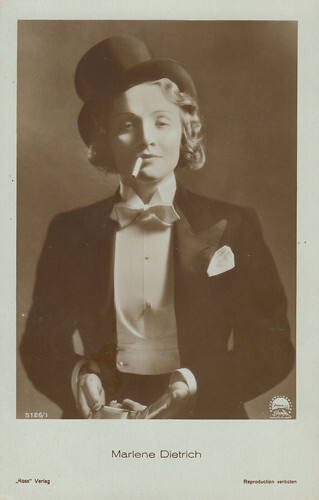
German postcard by Ross Verlag, no. 5126/1, 1930-1931. Photo: Eugene Robert Richee / Paramount. Marlene Dietrich in Morocco (Josef von Sternberg, 1930). Collection: Marlene Pilaete.
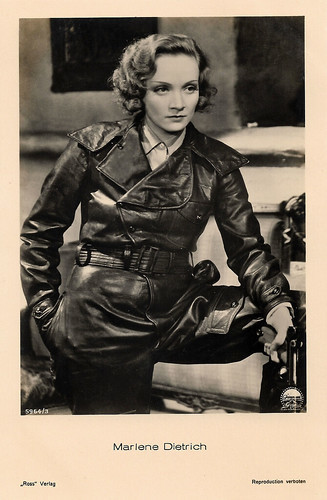
German postcard by Ross Verlag, no. 5964/3, 1930-1931. Photo: Paramount. Marlene Dietrich in Dishonored/Agent X27 (Josef von Sternberg, 1931). Collection: Geoffrey Donaldson Institute.
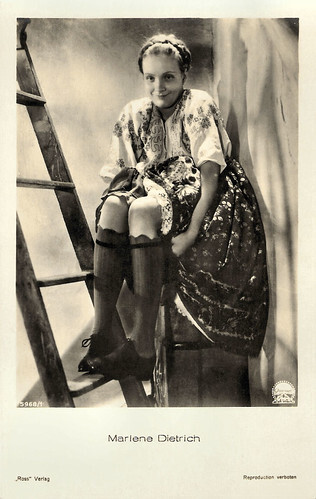
German postcard by Ross Verlag, no. 5968/1, 1930-1931. Paramount. Marlene Dietrich in Dishonored/Agent X27 (Josef von Sternberg, 1931).
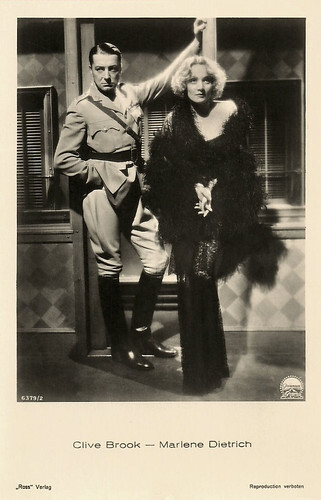
German postcard by Ross Verlag, no. 6379/2. Photo: Paramount. Marlene Dietrich as Shanghai Lily and Clive Brook as 'Doc' Harvey in Shanghai Express (Josef von Sternberg, 1932).
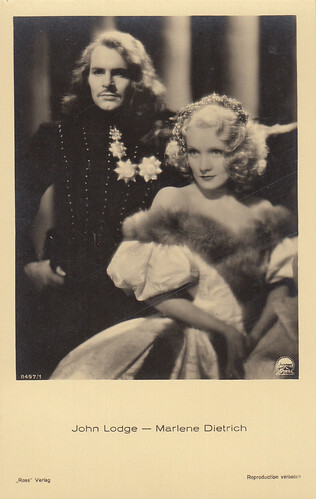
German postcard by Ross Verlag, no. 8497/1, 1933-1934. Photo: Paramount. John Lodge and Marlene Dietrich in The Scarlet Empress (Josef von Sternberg, 1934). Collection: Marlene Pilaete.
A shoot that turned into a disaster
In 1935, after the financial failures of The Scarlet Empress and The Devil is a Woman, Josef von Sternberg moved to Columbia Pictures, where he made Crime and Punishment (Josef von Sternberg, 1935), an adaption of the 19th-century Russian novelist Fyodor Dostoevsky's novel starring Peter Lorre . The film was shown this year at Il Cinema Ritrovato 2022 and Ehsan Khoshbakht writes in the festival catalogue: "Sternberg uses intense closeups of a profusely sweating Lorre (already hooked on drugs in real life) to show his further drift into mental instability. But unlike with other adaptations the director doesn’t care much about the moral dilemmas central to Dostoevsky’s work. Sternberg is a man of surfaces, the outer appearance of the world, and never delves into Raskolnikov’s delirious vision. As a result, the film confused and angered reviewers upon its release. Today, the same restraint has become the film’s main strength."
Sternberg's next feature was The King Steps Out (Josef von Sternberg, 1936), based on Fritz Kreisler's 'Sissi', an operetta about the life of Empress Elisabeth of Austria and starring soprano Grace Moore. The production was undermined by personal and professional discord between opera diva and director. Sternberg found himself unable to identify himself with his leading lady or adapt his style to the demands of operetta. He left Columbia. The following year he was hired by Alexander Korda to film I, Claudius (Josef von Sternberg, 1937), but the shoot turned into a disaster. The leading actress Merle Oberon almost died in a traffic accident, the financing of the film fell through and in the end the production was cancelled. The few surviving scenes, however, are considered the best Von Sternberg ever shot.
Metro-Goldwyn-Mayer asked Sternberg to finish up a few scenes for departing French director Julien Duvivier's The Great Waltz (1938). At the personal request of Louis B. Mayer, Von Sternberg was commissioned in 1938 to turn his Austrian discovery Hedy Lamarr into the biggest star in the world. The production of I Take This Woman (W.S. Van Dyke, 1940) soon turned into a full-blown disaster that lasted over 16 months, with almost the entire cast replaced and three directors taking turns. Eventually Von Sternberg found himself directing Wallace Beery in the police drama Sergeant Madden (Josef von Sternberg, 1939). The film is notable in that the theme and style strongly resemble German films of the post-WWI period. Despite some resistance from the bombastic Beery, Sternberg coaxed a relatively restrained performance that recalls Emil Jannings .
With the exception of Shanghai Gesture (Josef von Sternberg, 1941), which tells the story of Mother Gin Sling and her brothel (a casino in the film), and the drama The Saga of Anatahan (Josef von Sternberg, 1953), his later work did not have the level of his years at Paramount. Wikipedia calls Shanghai Gesture "a tour-de-force with Sternberg's sheer 'physical expressiveness' of his characters that conveys both emotion and motivation". The Japanese war drama Anatahan/The Saga of Anatahan told the true story of Japanese soldiers who held their position on the island of Anatahan for seven years after the end of the war because they refused to accept the Japanese surrender. Von Sternberg had an unusually high degree of control over the film, made outside the studio system, which allowed him to not only direct, but also write, photograph, and narrate the action.
Although Anatahan/The Saga of Anatahan opened modestly well in Japan, it did poorly in the US, where Von Sternberg continued to recut the film for four more years. He subsequently abandoned the project and went on to teach film at UCLA for most of the remainder of his lifetime. In 1963, Josef von Sternberg received the Filmband in Gold in Germany for his many years of outstanding work. Two years later, he presented his sardonic autobiography 'Fun in a Chinese Laundry' (1965) of which the title was drawn from an early film comedy.
Josef von Sternberg died in 1969 in a Los Angeles County hospital as a result of a heart attack. He was buried in Westwood Village Memorial Park Cemetery. He was married to film actress Riza Royce in his first marriage from 1926 to 1930. In 1945 he married Jean Avette McBride. The marriage was divorced in 1947. Von Sternberg was finally married to the art historian Meri Otis Wilner from 1948 until his death. From this marriage came his son Nicholas Josef von Sternberg, who was born in 1951.
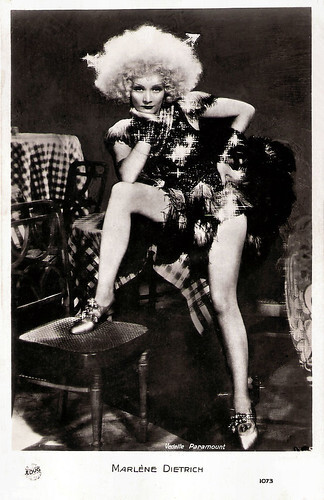
French postcard by EDUG, no. 1073. Photo: Paramount. Marlene Dietrich in Blonde Venus (Josef von Sternberg, 1932).
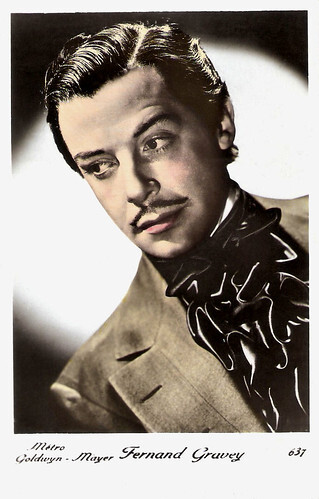
French postcard, no. 34. Photo: Metro-Goldwyn-Mayer. Fernand Gravey in The Great Waltz (Julien Duvivier, Josef von Sternberg uncredited, 1938).
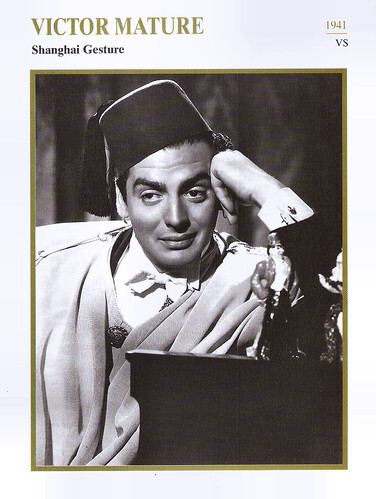
Dutch collectors card in the Filmsterren: een Portret series by Edito Service S.A., 1996. Photo: United Artists / The Kobal Collection. Victor Mature in Shanghai Gesture (Josef von Sternberg, 1941).
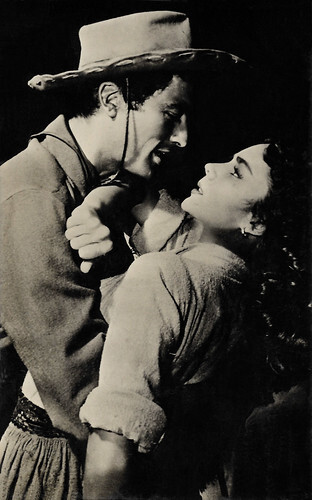
Spanish postcard, 1953. Photo: Procines S.A. Gregory Peck and Jennifer Jones in Duel in the Sun (King Vidor, Josef von Sternberg uncredited, 1946).
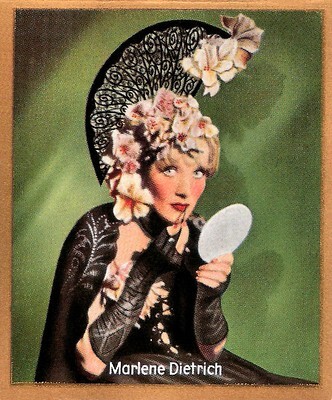
German cigarette card in the series Unsere Bunten Filmbilder by Ross Verlag for Cigarettenfabrik Josetti, Berlin, no. 25. Photo: Paramount. Marlene Dietrich in The Devil is a Woman (Josef von Sternberg, 1935).
Sources: Ehsan Khoshbakht (Il Cinema Ritrovato), Wikipedia (German, Dutch and English) and .

German postcard by Ross Verlag, no. 4746/1, 1929-1930. Photo: Ufa. Emil Jannings in Der blaue Engel/The Blue Angel (Josef von Sternberg, 1930).

German postcard by Ross Verlag, no. 5125/1, 1930-1931. Photo: Ufa. Marlene Dietrich in Der blaue Engel/The Blue Angel (Josef von Sternberg, 1930) Collection: Marlene Pilaete.

German postcard by Ross Verlag, no. 5751/1, 1930-1931. Photo: Paramount. Gary Cooper in Morocco (Josef von Sternberg, 1930). Caption: Garry Cooper (sic).

German postcard by Ross Verlag, no. 6673/2, 1931-1932. Photo: Don English / Paramount. Marlene Dietrich in Shanghai Express (Josef von Sternberg, 1932).

German postcard by Ross Verlag, no. 8995/1, 1933-1934. Photo: Paramount. Marlene Dietrich in The Devil is a Woman (Josef von Sternberg, 1935).
A symphony of shadows and lighting effects
Josef von Sternberg was born as Jonas Sternberg in 1894, in Vienna, at that time part of the Austro-Hungarian Empire. Sternberg was the son of Moses Sternberg, an impoverished Jewish businessman from Krakow and former soldier in the army of Austria-Hungary, and his wife Serafine, née Singer. The family moved to the U.S. in 1901. Jonas attended public school until the family, except Moses, returned to Vienna three years later. Throughout his life, Sternberg carried vivid memories of Vienna and nostalgia for some of his happiest childhood moments.
In 1908, when Jonas was fourteen, he returned with his mother to Queens, New York, and settled in the United States. He acquired American citizenship in 1908. After a year, he stopped attending Jamaica High School and began working in various occupations, including millinery apprentice, door-to-door trinket salesman and stock clerk at a lace factory. At the age of 17, he started to work at the World Film Company in Fort Lee, New Jersey, as a film repairer and projectionist under the stage name Josef Sternberg. In 1914, when the company was purchased by actor and film producer William A. Brady, Sternberg rose to chief assistant, responsible for writing (inter)titles and editing films to cover lapses in continuity for which he received his first official film credits.
When the United States entered World War I in 1917, he joined the US Army and was assigned to the Signal Corps headquartered in Washington, D.C., where he photographed training films for recruits. Shortly after the war, Sternberg left Brady's Fort Lee operation and worked for various studios. Sternberg travelled widely in Europe between 1922 and 1924, where he worked for the short-lived Alliance Film Corporation in London, on such films as The Bohemian Girl (Harley Knoles, 1922).
When he returned to California in 1924, he started as an assistant to director Roy William Neill's Vanity's Price. Sternberg's aptitude for effective directing was recognized in his handling of the operating room scene, singled out for special mention by New York Times critic Mordaunt Hall. Through the agency of Charles Chaplin and Mary Pickford , he met the German writer and screenwriter Karl Gustav Vollmoeller, who invited him to Venice and Berlin in 1925 and introduced him to the actor Emil Jannings .
With actor George K. Arthur, he made The Salvation Hunters (1925) for only US $4,800, which was filmed on a large steam dredge in the marshes near San Pedro Bay. It depicted three young drifters who struggle to survive in a dystopian landscape. The film caught the attention of some critics who praised Sternberg's innovative use of light and shadow in the dramatisation of a scene. Plans to make a film with Mary Pickford subsequently fell through, but in the end von Sternberg was offered a contract by MGM.
Signing an eight-film agreement with Metro-Goldwyn-Mayer in 1925, Sternberg entered into the increasingly rigid studio system at MGM, and the cooperation with the studio executives and the stars was not easy. During the shooting of The Masked Bride (1925), Von Sternberg, who was notorious for being autocratic, argued violently with the leading actress Mae Murray for weeks. Eventually the contract was terminated by mutual agreement and the film was directed by Christy Cabanne.
A short time later he received an offer by Charles Chaplin to make the film A Woman of the Sea/The Sea Gull (Josef von Sternberg, 1926) as a comeback vehicle for Edna Purviance, Chaplin's former leading lady. However, Chaplin decided not to distribute the finished film as he considered it a "highly visual, almost Expressionistic" work, completely lacking in the humanism that he had anticipated". In the 1930s, Chaplin had the negative destroyed in order to be able to deduct the filming costs from his taxes.
The tide turned for Von Sternberg when he got a contract with Paramount in 1927. After he had successfully re-produced some scenes for films that had already been shot, such as Children of Divorce (Frank Lloyd, 1927), with Clara Bow , he got the chance to shoot the film Underworld later that year. The script about Chicago gangsters by journalist Ben Hecht took a concerned look behind the scenes of organised crime for the first time and Von Sternberg turned it into a gripping gangster film. At the same time, he composed scenes out of light and shadow that prompted one critic to remark that von Sternberg used the camera the way a painter uses his brush. The film was an enormous box-office hit and Academy Award winner for Best Original Story.
After this overwhelming commercial success, Paramount gave Von Sternberg a free hand with the direction of The Last Command (Josef von Sternberg, 1928), which was shot with Emil Jannings , the studio's most valuable star. A year later, Jannings won the Oscar in the Best Actor in a Leading Role category for hhis performance, the first actor to do so. In the same year followed the drama The Docks of New York (Josef von Sternberg, 1928) starring George Bancroft , Betty Compson , and Olga Baclanova , one of the most mature and visually beautiful films of his career. The story about a sailor and a prostitute was transformed by Von Sternberg into a symphony of shadows and lighting effects.

German postcard by Ross Verlag, Foreign, no. 99/1. Photo: Paramount. Emil Jannings in The Last Command (Josef von Sternberg, 1928).

German postcard by Ross Verlag, no. 99/6. Photo: Paramount. Evelyn Brent and Emil Jannings in The Last Command (Josef von Sternberg, 1928).

German postcard by Ross Verlag, no. 3946, 1928-1929. Photo: Paramount. Olga Baclanova in The Docks of New York (Josef von Sternberg, 1928). Collection: Didier Hanson.

German postcard by Ross Verlag, no. 3993/1, 1928-1929. Photo: Paramount. Fay Wray in Street of Sin (Mauritz Stiller, Josef von Sternberg uncredited, 1928).

German postcard by Ross Verlag, no. 4329/1, 1929-1930. Photo: Paramount. Esther Ralston in The Case of Lena Smith (Josef von Sternberg, 1929).
The eternal seductress
In 1929, Josef von Sternberg went to Germany to film the first sound film with star Emil Jannings at Paramount'sister studio Ufa. The contract with Ufa was brokered by Karl Gustav Vollmoeller, who was placed at his side by Ufa as screenwriter, technical advisor and general editor. It was also thanks to him that the film rights of the novel 'Professor Unrat' by Heinrich Mann were sold to Ufa under the title Der blaue Engel/The Blue Angel (Josef von Sternberg, 1930). The female lead was initially to be given to a wide variety of actresses, including Louise Brooks . But in the end the choice fell on Marlene Dietrich as Lola Lola, the nemesis of Emil Jannings 's character Professor Immanuel Rath. Sternberg's romantic infatuation with his new star created difficulties on and off the set. Jannings strenuously objected to Sternberg's lavish attention to Dietrich's performance, at the elder actor's expense. Dietrich became an international star overnight.
The director and his new star left for America the same evening as the premiere, where they began shooting Morocco (Josef von Sternberg, 1930) with Gary Cooper . Dietrich was built up by the studio as an answer to Greta Garbo , but Von Sternberg turned the actress into a screen personality all her own over the course of their six Hollywood films together: Morocco (1930), Dishonored (1931), Shanghai Express (1932), Blonde Venus (1932), The Scarlet Empress (1934), and The Devil is a Woman (1935). Wikipedia : "The stories are typically set in exotic locales including Saharan Africa, World War I Austria, revolutionary China, Imperial Russia, and fin-de-siècle Spain. Sternberg's 'outrageous aestheticism' is on full display in these richly stylized works, both in technique and scenario."
However, von Sternberg was quickly accused by the press of paying too much attention to the visual aspects and staging of his leading lady and placing too little emphasis on a good script. Especially the film Blonde Venus (Josef von Sternberg, 1932), which they made immediately after their biggest financial success Shanghai Express (Josef von Sternberg, 1932), made Von Sternberg's implied weaknesses clear. Marlene Dietrich , who finally wanted a change of role, away from the eternal seductress, demanded material that showed her as a caring wife and good mother. Von Sternberg, however, did not like the concept and also showed Dietrich as a cabaret star. At no point was there a coherent script and in the end, according to critics, only the musical scenes were convincing, such as the famous 'hot voodoo' number in which Dietrich first comes on stage dressed as a gorilla and then peels herself out of the costume.
In 1931, the director took over a half-finished script that Sergei Eisenstein had written based on the social novel 'An American Tragedy' by Theodore Dreiser before he was forced out of the project. Von Sternberg discarded most of the ideas and started from scratch. The result, An American Tragedy (Josef von Sternberg, 1931), a tale of a sexually obsessed middle-class youth (Phillips Holmes) whose deceptions lead to the death of a poor factory girl ( Sylvia Sidney ), divided critics like few of his previous works. On the one hand, they praised the already familiar compositions of light and shadow and the performance of Sylvia Sidney as Drina. But overall the consensus was that Dreiser's biting social commentary and Von Sternberg's more lyrical narrative style were mutually exclusive.
After Marlene Dietrich , under pressure from the studio and against the backdrop of the less than encouraging box office results of Blonde Venus (Josef von Sternberg, 1932), had made the less than successful film Song of Songs (Rouben Mamoulian, 1933), the two artists reunited in mid-1934. In response to the very successful film Queen Christina (Rouben Mamoulian, 1933), which showed Garbo as the Swedish queen a year earlier, Paramount wanted to present its own glamour star as a famous ruler as well. Thus, under Sternberg's direction, the historical film The Scarlet Empress (Josef von Sternberg, 1934) was made with Dietrich as Catherine the Great. During the filming, which was again marked by endless changes to the script, and amid escalating production costs.
The Von Sternberg-Dietrich collaboration ended the following year with The Devil is a Woman (Josef von Sternberg, 1935), a story about a Spanish dancer. In this final tribute he sets forth his reflections on their five-year professional and personal association. Based on a novel by Pierre Louÿs, 'La Femme et le pantin' (The Woman and the Puppet, 1908), the drama unfolds in Spain's famous carnival at the end of the 19th century. A love triangle develops pitting the young revolutionary Antonio (Cesar Romero) against the middle-aged former military officer Don Pasqual (Lionel Atwill) in a contest for the love of the devastatingly beautiful demi-mondaine Concha (Dietrich). Despite the gaiety of the setting, the film has a dark, brooding, reflective quality. Dietrich liked the film more than any other because, because he made her look so beautiful. However, the film was a disaster financially.

German postcard by Ross Verlag, no. 5126/1, 1930-1931. Photo: Eugene Robert Richee / Paramount. Marlene Dietrich in Morocco (Josef von Sternberg, 1930). Collection: Marlene Pilaete.

German postcard by Ross Verlag, no. 5964/3, 1930-1931. Photo: Paramount. Marlene Dietrich in Dishonored/Agent X27 (Josef von Sternberg, 1931). Collection: Geoffrey Donaldson Institute.

German postcard by Ross Verlag, no. 5968/1, 1930-1931. Paramount. Marlene Dietrich in Dishonored/Agent X27 (Josef von Sternberg, 1931).

German postcard by Ross Verlag, no. 6379/2. Photo: Paramount. Marlene Dietrich as Shanghai Lily and Clive Brook as 'Doc' Harvey in Shanghai Express (Josef von Sternberg, 1932).

German postcard by Ross Verlag, no. 8497/1, 1933-1934. Photo: Paramount. John Lodge and Marlene Dietrich in The Scarlet Empress (Josef von Sternberg, 1934). Collection: Marlene Pilaete.
A shoot that turned into a disaster
In 1935, after the financial failures of The Scarlet Empress and The Devil is a Woman, Josef von Sternberg moved to Columbia Pictures, where he made Crime and Punishment (Josef von Sternberg, 1935), an adaption of the 19th-century Russian novelist Fyodor Dostoevsky's novel starring Peter Lorre . The film was shown this year at Il Cinema Ritrovato 2022 and Ehsan Khoshbakht writes in the festival catalogue: "Sternberg uses intense closeups of a profusely sweating Lorre (already hooked on drugs in real life) to show his further drift into mental instability. But unlike with other adaptations the director doesn’t care much about the moral dilemmas central to Dostoevsky’s work. Sternberg is a man of surfaces, the outer appearance of the world, and never delves into Raskolnikov’s delirious vision. As a result, the film confused and angered reviewers upon its release. Today, the same restraint has become the film’s main strength."
Sternberg's next feature was The King Steps Out (Josef von Sternberg, 1936), based on Fritz Kreisler's 'Sissi', an operetta about the life of Empress Elisabeth of Austria and starring soprano Grace Moore. The production was undermined by personal and professional discord between opera diva and director. Sternberg found himself unable to identify himself with his leading lady or adapt his style to the demands of operetta. He left Columbia. The following year he was hired by Alexander Korda to film I, Claudius (Josef von Sternberg, 1937), but the shoot turned into a disaster. The leading actress Merle Oberon almost died in a traffic accident, the financing of the film fell through and in the end the production was cancelled. The few surviving scenes, however, are considered the best Von Sternberg ever shot.
Metro-Goldwyn-Mayer asked Sternberg to finish up a few scenes for departing French director Julien Duvivier's The Great Waltz (1938). At the personal request of Louis B. Mayer, Von Sternberg was commissioned in 1938 to turn his Austrian discovery Hedy Lamarr into the biggest star in the world. The production of I Take This Woman (W.S. Van Dyke, 1940) soon turned into a full-blown disaster that lasted over 16 months, with almost the entire cast replaced and three directors taking turns. Eventually Von Sternberg found himself directing Wallace Beery in the police drama Sergeant Madden (Josef von Sternberg, 1939). The film is notable in that the theme and style strongly resemble German films of the post-WWI period. Despite some resistance from the bombastic Beery, Sternberg coaxed a relatively restrained performance that recalls Emil Jannings .
With the exception of Shanghai Gesture (Josef von Sternberg, 1941), which tells the story of Mother Gin Sling and her brothel (a casino in the film), and the drama The Saga of Anatahan (Josef von Sternberg, 1953), his later work did not have the level of his years at Paramount. Wikipedia calls Shanghai Gesture "a tour-de-force with Sternberg's sheer 'physical expressiveness' of his characters that conveys both emotion and motivation". The Japanese war drama Anatahan/The Saga of Anatahan told the true story of Japanese soldiers who held their position on the island of Anatahan for seven years after the end of the war because they refused to accept the Japanese surrender. Von Sternberg had an unusually high degree of control over the film, made outside the studio system, which allowed him to not only direct, but also write, photograph, and narrate the action.
Although Anatahan/The Saga of Anatahan opened modestly well in Japan, it did poorly in the US, where Von Sternberg continued to recut the film for four more years. He subsequently abandoned the project and went on to teach film at UCLA for most of the remainder of his lifetime. In 1963, Josef von Sternberg received the Filmband in Gold in Germany for his many years of outstanding work. Two years later, he presented his sardonic autobiography 'Fun in a Chinese Laundry' (1965) of which the title was drawn from an early film comedy.
Josef von Sternberg died in 1969 in a Los Angeles County hospital as a result of a heart attack. He was buried in Westwood Village Memorial Park Cemetery. He was married to film actress Riza Royce in his first marriage from 1926 to 1930. In 1945 he married Jean Avette McBride. The marriage was divorced in 1947. Von Sternberg was finally married to the art historian Meri Otis Wilner from 1948 until his death. From this marriage came his son Nicholas Josef von Sternberg, who was born in 1951.

French postcard by EDUG, no. 1073. Photo: Paramount. Marlene Dietrich in Blonde Venus (Josef von Sternberg, 1932).

French postcard, no. 34. Photo: Metro-Goldwyn-Mayer. Fernand Gravey in The Great Waltz (Julien Duvivier, Josef von Sternberg uncredited, 1938).

Dutch collectors card in the Filmsterren: een Portret series by Edito Service S.A., 1996. Photo: United Artists / The Kobal Collection. Victor Mature in Shanghai Gesture (Josef von Sternberg, 1941).

Spanish postcard, 1953. Photo: Procines S.A. Gregory Peck and Jennifer Jones in Duel in the Sun (King Vidor, Josef von Sternberg uncredited, 1946).

German cigarette card in the series Unsere Bunten Filmbilder by Ross Verlag for Cigarettenfabrik Josetti, Berlin, no. 25. Photo: Paramount. Marlene Dietrich in The Devil is a Woman (Josef von Sternberg, 1935).
Sources: Ehsan Khoshbakht (Il Cinema Ritrovato), Wikipedia (German, Dutch and English) and .
Published on November 12, 2022 22:00
November 11, 2022
Three Swedish silent films: Thomas Graals bästa barn (1918), Mästerkatten i stövlar (1918) and De landsflyktiga (1921),
During the heydays of the silent Swedish cinema, Mauritz Stiller, Victor Sjöström and John W. Brunius were three of the most prominent directors. They produced many outstanding silent films, including some of the best of the adaptations of stories by the Nobel-prizewinning novelist Selma Lagerlöf.
Thomas Graals bästa barn (1918)
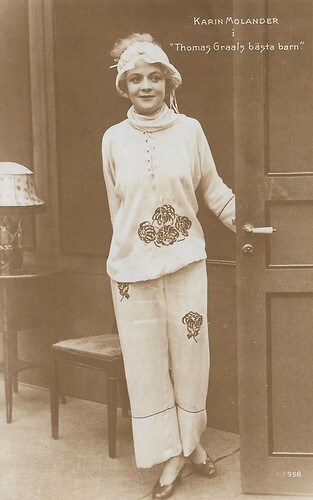
Swedish postcard by Förlag Nordisk Konst, Stockholm, no. 958. Photo: Svenska Biografteatern. Karin Molander in Thomas Graals bästa barn/Thomas Graal's First Child (Mauritz Stiller, 1918).
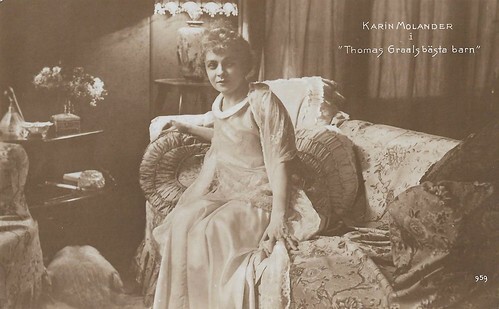
Swedish postcard by Förlag Nordisk Konst, Stockholm, no. 959. Photo: Svenska Biografteatern. Karin Molander in Thomas Graals bästa barn/Thomas Graal's First Child (Mauritz Stiller, 1918).
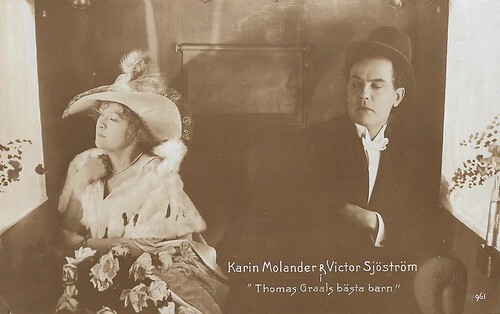
Swedish postcard by Förlag Nordisk Konst, Stockholm, no. 961. Photo: Svenska Biografteatern. Victor Sjöström and Karin Molander in the Swedish silent comedy Thomas Graals bästa barn/Thomas Graal's First Child (Mauritz Stiller, 1918).
On the day of the wedding between the writer Thomas Graal and Bessie an argument develops between them about their respective expectations of the sex of their future first child: she wants a girl, whom she intends to call Lillian, and he a boy. Because of this quarrel, they spend the first days of their life together in mutual segregation, which worries the servants, who ask Bessie's mother to intervene.
But the conflict is soon resolved when Thomas is stung in his pride and drives away a slightly tipsy man who had begun courting his wife. In due course, Lillianus, a boy, is born, but between the couple, in a less explosive and more creeping way, a conflict arises over the different pedagogical conceptions of the two constituents of the couple: she is intransigent and strict, he is more relaxed and easy-going.
But the real reason for Thomas's discomfort is only learnt by Bessie after reading the story her husband has just finished writing: he lacks the seductive and erotic attitudes that were his wife's own before she abandoned them to devote herself completely and exclusively to Lillianus. Bessie understands, and, not without mutual satisfaction, complies with the literary dictate.
Victor Sjöström (1879-1960) was one of the most important Swedish actors and directors, famous for his poetic and touching narratives, such as Ingeborg Holm (1913), Terje Vigen/A Man There Was (1916) - by then the most expensive Swedish film made - and Körkarlen/The Phantom Carriage (1920), considered one of the best Swedish silent films.
From 1923 he worked in Hollywood under the name of Victor Seastrom , directing such films as He Who Gets Slapped (1924), starring Lon Chaney , and The Wind (1928), starring Lilian Gish . Returned to Sweden at the advent of sound cinema, he continued working there. Memorable is his last acting part in Smultronstället/Wild Strawberries (Ingmar Bergman, 1957).
Mästerkatten i stövlar (1918)
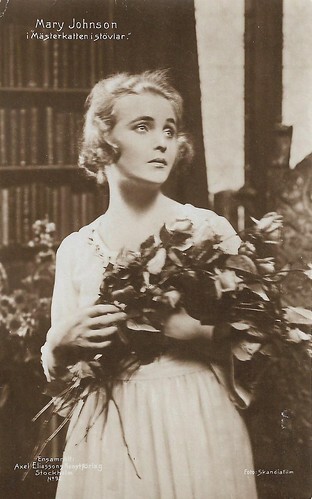
Swedish postcard by Axel Eliassons Konstförlag, Stockholm, no. 92. Photo: Skandia Film. Gösta Ekman , Mary Johnson and Carl Keil-Möller in Mästerkatten i stövlar/Puss in boots (John W. Brunius, 1918).
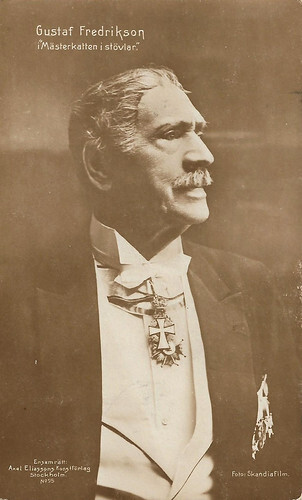
Swedish postcard by Axel Eliassons Konstförlag, Stockholm, no. 95. Photo: Skandia Film. Gustaf Fredrikson in Mästerkatten i stövlar/Puss in boots (John W. Brunius, 1918).
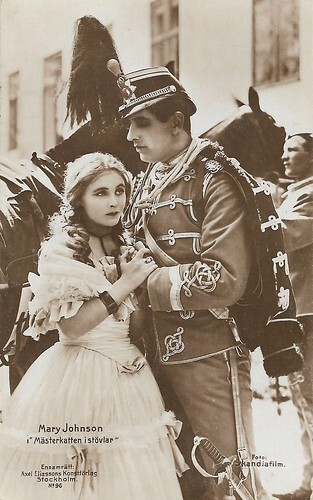
Swedish postcard by Axel Eliassons Konstförlag, Stockholm, no. 96. Photo: Skandiafilm. Gösta Ekman , Mary Johnson and Carl Keil-Möller in Mästerkatten i stövlar/Puss in boots (John W. Brunius, 1918).
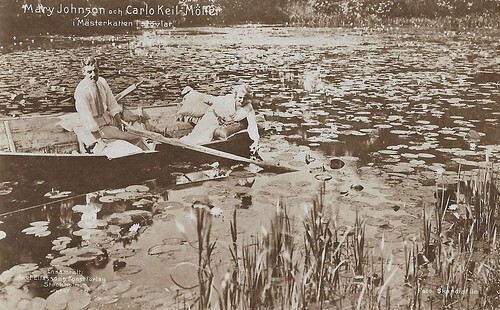
Swedish postcard by Axel Eliassons Konstförlag, Stockholm, no. 97. Photo: Skandiafilm. Gösta Ekman , Mary Johnson and Carl Keil-Möller in Mästerkatten i stövlar/Puss in boots (John W. Brunius, 1918).
Young Jörgen Steenfeld (Carlo Keil-Möller), the heir of the over-indebted estate Steensgaard, is unable to clear up its finances. He is being looked after by his old friend, "Mästerkatten" (Puss in Boots, Gösta Ekman), ie the enterprising, charming but somewhat irreplaceable Karl Konstantin Kattrup, who has been relegated from the university.
Kattrup becomes manager at Steensgaard. Steenfeld receives visits by count and countess Markdanner and her daughter Rose (Anna Carlsten). The Countess (Märtha Lindlöf) is planning a marriage between Rose and Jörgen, but Jörgen is secretly in love with the orphan Helga Anthon, called Pips (Mary Johnson). Matters are further complicated by the affair between Kattrup and Rose.
Kattrup is now turning to Steenfeld's largest creditor, Chamberlain von Schinkel (Gustaf "Frippe" Fredrikson), who is a good man and who advises Jörgen to marry Rose to set his finances straight. Kattrup also advises his friend to marry the Countess. With this planned marriage, Kattrup and Steenfeld succeed in holding another creditor from the carpet, the unpleasant schemer Bögedal (Sam Ask).
Steenfeld takes a painful parting of Pips, and the engagement is announced between Jörgen and Rose. None of them is happy: Jörgen just wants Pips, Rose just wants Kattrup. Jörgen realizes that he will make all parties unhappy if he marries Rose, so he breaks up the engagement, to the fiancée's joy. But poor Pips witnesses a love scene between Rose and Kattrup and misunderstands the situation as she confuses Kattrup and Jörgen from their point of view.
Despaired she falls out of a tree, is badly hurt and is taken care of by old von Schinkel who recognizes his youth love, Pips' grandmother. Bögedal takes advantage of the new situation to ensure that Steensgaard will be sold at an auction, where he himself intends to buy the goods. But at the auction, he is overbidden by Kattrup, on von Schinkel's behalf. The old chamberlain has adopted Pips and now grants Steensgaard to her and Jörgen. When these two get together, Kattrup can return to his Rose and everyone is happy except for the plotter Bögedal.
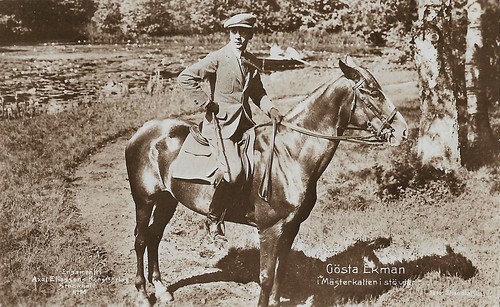
Swedish postcard by Axel Eliassons Konstförlag, Stockholm, no. 98. Photo: Skandiafilm. Gösta Ekman in Mästerkatten i stövlar/Puss in boots (John W. Brunius, 1918).
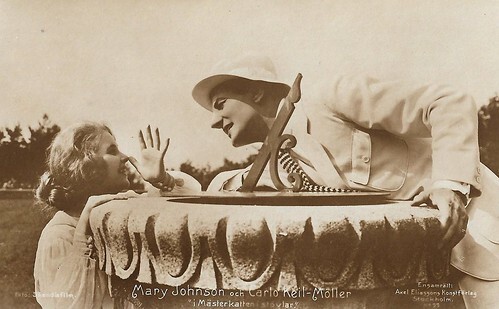
Swedish postcard by Axel Eliassons Konstförlag, Stockholm, no. 99. Photo: Skandia Film. Mary Johnson and Carl(o) Keil-Möller in Mästerkatten i stövlar/Puss in boots (John W. Brunius, 1918).
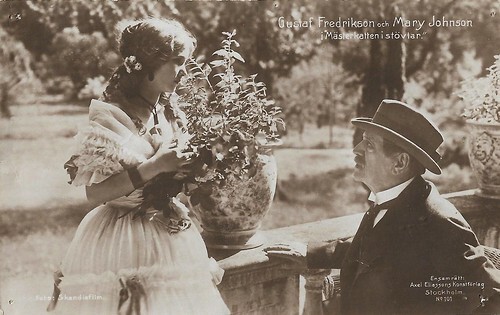
Swedish postcard by Axel Eliassons Konstförlag, Stockholm, no. 101. Photo: Skandia Film. Mary Johnson and Gustaf Fredrikson in Mästerkatten i stövlar/Puss in boots (John W. Brunius, 1918).
De landsflyktiga (1921)
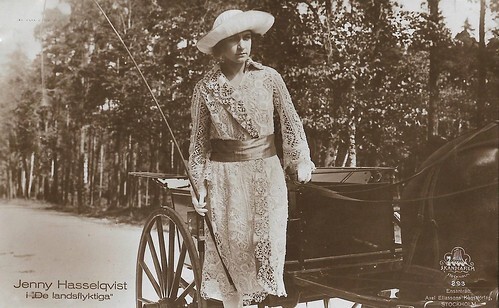
Swedish postcard by Ed. Axel Eliassons Konstförlag, Stockholm, no. 293. Photo: Skandia Film, Stockholm/Svensk Filmindustri. Jenny Hasselquist in De landsflyktiga/The Emigrants/The Exiles (Mauritz Stiller, 1921).
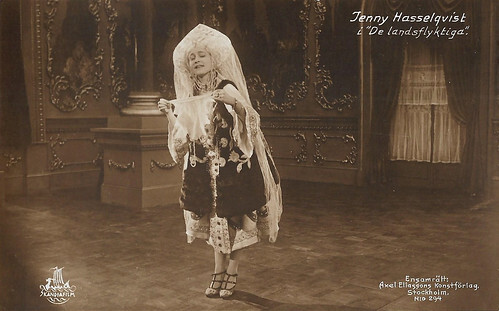
Swedish postcard by Ed. Axel Eliassons Konstförlag, Stockholm, no. 294. Photo: Skandia Film, Stockholm/Svensk Filmindustri. Jenny Hasselquist in De landsflyktiga/The Emigrants/The Exiles (Mauritz Stiller, 1921).
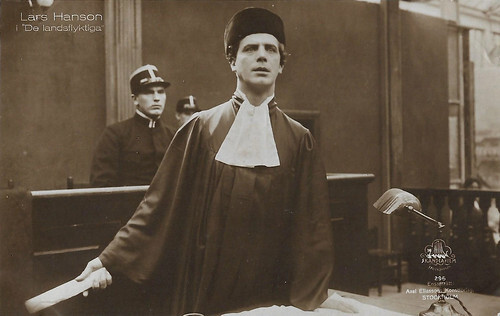
Swedish postcard by Ed. Axel Eliassons Konstförlag, Stockholm, no. 296. Photo: Skandia Film, Stockholm/Svensk Filmindustri. Jenny Hasselquist and Lars Hanson in De landsflyktiga/The Emigrants/The Exiles (Mauritz Stiller, 1921).
De landsflyktiga/The Emigrants/The Exiles (Mauritz Stiller, 1921) was shot in the studios of Filmstaden Råsunda with exteriors at Steninge castle, Stadsgårdskajen and other locations in Stockholm, shot by cinematographer by Henrik Jaenzon. The film was based on Runar Schildt's short story 'Zoja' (1920), which was published in the short story collection Häxskogen. It was during the filming of The Exiles that Stiller, who had been a Russian citizen since his birth in Helsinki, applied to become a Swedish citizen.
The wealthy Barantscheff family lives on the stately Staraja-Selo estate in the heart of Russia. Prince Ivan Ivanovich (Carl Nissen), his wife Ivanovna Stefanovna (Karin Swanstrom), their daughter Sonja ( Jenny Hasselqvist ) and son Yuri (Nils Ohlin), a lieutenant in the Russian navy who is recovering at home after being wounded in the war. The First World War is in full swing and storm clouds are gathering everywhere. The wealthy banker Andrei Andreyevich Myasoyedoff ( Ivan Hedqvist ) approaches the prince and proposes to sell the estate because of the troubled times. The prince takes the offer as an insult and refuses. Myasoyedoff has also set his eyes on Sonya, but she has already brusquely rejected him. One day, Sonya, while driving alone, rescues the young revolutionary student Vladimir Alexandrovich Mikhailoff ( Lars Hanson ), who is being chased by the gendarmes.
When the revolution breaks out, it is Vladimir who helps Sonja and her parents to escape across the border. The family settles in a major international city, perhaps Paris, and continues their former, carefree life of luxury, waiting for the revolution to be crushed so they can return to their former lives at home. But their inherited wealth quickly dwindles, and it is Myasoyedoff, who has also come there as a refugee, who helps them financially. He has managed to bring most of his fortune with him and is already involved in big business. The student Vladimir, a refugee from his former comrades, also arrives. One fine day, the Barantscheff family finds itself on the rocks. But Myasoyedoff is happy to oblige if only Sonya would be a little more accommodating to him.
But Sonja stubbornly refuses. In an upset scene, she rips off all the family jewels she wore to the evening's charity party and gives them as collateral instead of herself for the family's debt. Myasoyedoff takes the jewels and smilingly adds that the pledge is due at the end of the year. On New Year's Eve, Myasoyedoff is found dead in his villa, with Sonya lying unconscious outside. Vladimir, now a lawyer, defends Sonja in court. She admits that she shot Myasoyedoff when he tried to rape her. Afterwards, she threw the revolver from the balcony. But no revolver has been found.
In a break during the last day of the trial comes the explanation. Vladimir confesses to Sonja during a visit to her cell that it was he who shot Myasoyedoff on behalf of his comrades. Myasoyedoff was spying on the emigrants on behalf of the Bolshevik government, and many of their relatives remaining in Russia had already been shot. Myasoyedoff was an informer, Vladimir is the real killer, and Sonya now holds his fate in her hands. But Vladimir's defence speech in court for Sonja leads to her acquittal. She and Vladimir are united, and Sonja utters the film's final line, which it was hoped at the time would have a prophetic meaning: "Out of the darkness that oppresses us, a new Russia will one day arise, a Russia that we can both love." De landsflyktiga/The Emigrants/The Exiles is a lost film, except for a few very short fragments.
Source: Svenskfilmdatabas.
Thomas Graals bästa barn (1918)

Swedish postcard by Förlag Nordisk Konst, Stockholm, no. 958. Photo: Svenska Biografteatern. Karin Molander in Thomas Graals bästa barn/Thomas Graal's First Child (Mauritz Stiller, 1918).

Swedish postcard by Förlag Nordisk Konst, Stockholm, no. 959. Photo: Svenska Biografteatern. Karin Molander in Thomas Graals bästa barn/Thomas Graal's First Child (Mauritz Stiller, 1918).

Swedish postcard by Förlag Nordisk Konst, Stockholm, no. 961. Photo: Svenska Biografteatern. Victor Sjöström and Karin Molander in the Swedish silent comedy Thomas Graals bästa barn/Thomas Graal's First Child (Mauritz Stiller, 1918).
On the day of the wedding between the writer Thomas Graal and Bessie an argument develops between them about their respective expectations of the sex of their future first child: she wants a girl, whom she intends to call Lillian, and he a boy. Because of this quarrel, they spend the first days of their life together in mutual segregation, which worries the servants, who ask Bessie's mother to intervene.
But the conflict is soon resolved when Thomas is stung in his pride and drives away a slightly tipsy man who had begun courting his wife. In due course, Lillianus, a boy, is born, but between the couple, in a less explosive and more creeping way, a conflict arises over the different pedagogical conceptions of the two constituents of the couple: she is intransigent and strict, he is more relaxed and easy-going.
But the real reason for Thomas's discomfort is only learnt by Bessie after reading the story her husband has just finished writing: he lacks the seductive and erotic attitudes that were his wife's own before she abandoned them to devote herself completely and exclusively to Lillianus. Bessie understands, and, not without mutual satisfaction, complies with the literary dictate.
Victor Sjöström (1879-1960) was one of the most important Swedish actors and directors, famous for his poetic and touching narratives, such as Ingeborg Holm (1913), Terje Vigen/A Man There Was (1916) - by then the most expensive Swedish film made - and Körkarlen/The Phantom Carriage (1920), considered one of the best Swedish silent films.
From 1923 he worked in Hollywood under the name of Victor Seastrom , directing such films as He Who Gets Slapped (1924), starring Lon Chaney , and The Wind (1928), starring Lilian Gish . Returned to Sweden at the advent of sound cinema, he continued working there. Memorable is his last acting part in Smultronstället/Wild Strawberries (Ingmar Bergman, 1957).
Mästerkatten i stövlar (1918)

Swedish postcard by Axel Eliassons Konstförlag, Stockholm, no. 92. Photo: Skandia Film. Gösta Ekman , Mary Johnson and Carl Keil-Möller in Mästerkatten i stövlar/Puss in boots (John W. Brunius, 1918).

Swedish postcard by Axel Eliassons Konstförlag, Stockholm, no. 95. Photo: Skandia Film. Gustaf Fredrikson in Mästerkatten i stövlar/Puss in boots (John W. Brunius, 1918).

Swedish postcard by Axel Eliassons Konstförlag, Stockholm, no. 96. Photo: Skandiafilm. Gösta Ekman , Mary Johnson and Carl Keil-Möller in Mästerkatten i stövlar/Puss in boots (John W. Brunius, 1918).

Swedish postcard by Axel Eliassons Konstförlag, Stockholm, no. 97. Photo: Skandiafilm. Gösta Ekman , Mary Johnson and Carl Keil-Möller in Mästerkatten i stövlar/Puss in boots (John W. Brunius, 1918).
Young Jörgen Steenfeld (Carlo Keil-Möller), the heir of the over-indebted estate Steensgaard, is unable to clear up its finances. He is being looked after by his old friend, "Mästerkatten" (Puss in Boots, Gösta Ekman), ie the enterprising, charming but somewhat irreplaceable Karl Konstantin Kattrup, who has been relegated from the university.
Kattrup becomes manager at Steensgaard. Steenfeld receives visits by count and countess Markdanner and her daughter Rose (Anna Carlsten). The Countess (Märtha Lindlöf) is planning a marriage between Rose and Jörgen, but Jörgen is secretly in love with the orphan Helga Anthon, called Pips (Mary Johnson). Matters are further complicated by the affair between Kattrup and Rose.
Kattrup is now turning to Steenfeld's largest creditor, Chamberlain von Schinkel (Gustaf "Frippe" Fredrikson), who is a good man and who advises Jörgen to marry Rose to set his finances straight. Kattrup also advises his friend to marry the Countess. With this planned marriage, Kattrup and Steenfeld succeed in holding another creditor from the carpet, the unpleasant schemer Bögedal (Sam Ask).
Steenfeld takes a painful parting of Pips, and the engagement is announced between Jörgen and Rose. None of them is happy: Jörgen just wants Pips, Rose just wants Kattrup. Jörgen realizes that he will make all parties unhappy if he marries Rose, so he breaks up the engagement, to the fiancée's joy. But poor Pips witnesses a love scene between Rose and Kattrup and misunderstands the situation as she confuses Kattrup and Jörgen from their point of view.
Despaired she falls out of a tree, is badly hurt and is taken care of by old von Schinkel who recognizes his youth love, Pips' grandmother. Bögedal takes advantage of the new situation to ensure that Steensgaard will be sold at an auction, where he himself intends to buy the goods. But at the auction, he is overbidden by Kattrup, on von Schinkel's behalf. The old chamberlain has adopted Pips and now grants Steensgaard to her and Jörgen. When these two get together, Kattrup can return to his Rose and everyone is happy except for the plotter Bögedal.

Swedish postcard by Axel Eliassons Konstförlag, Stockholm, no. 98. Photo: Skandiafilm. Gösta Ekman in Mästerkatten i stövlar/Puss in boots (John W. Brunius, 1918).

Swedish postcard by Axel Eliassons Konstförlag, Stockholm, no. 99. Photo: Skandia Film. Mary Johnson and Carl(o) Keil-Möller in Mästerkatten i stövlar/Puss in boots (John W. Brunius, 1918).

Swedish postcard by Axel Eliassons Konstförlag, Stockholm, no. 101. Photo: Skandia Film. Mary Johnson and Gustaf Fredrikson in Mästerkatten i stövlar/Puss in boots (John W. Brunius, 1918).
De landsflyktiga (1921)

Swedish postcard by Ed. Axel Eliassons Konstförlag, Stockholm, no. 293. Photo: Skandia Film, Stockholm/Svensk Filmindustri. Jenny Hasselquist in De landsflyktiga/The Emigrants/The Exiles (Mauritz Stiller, 1921).

Swedish postcard by Ed. Axel Eliassons Konstförlag, Stockholm, no. 294. Photo: Skandia Film, Stockholm/Svensk Filmindustri. Jenny Hasselquist in De landsflyktiga/The Emigrants/The Exiles (Mauritz Stiller, 1921).

Swedish postcard by Ed. Axel Eliassons Konstförlag, Stockholm, no. 296. Photo: Skandia Film, Stockholm/Svensk Filmindustri. Jenny Hasselquist and Lars Hanson in De landsflyktiga/The Emigrants/The Exiles (Mauritz Stiller, 1921).
De landsflyktiga/The Emigrants/The Exiles (Mauritz Stiller, 1921) was shot in the studios of Filmstaden Råsunda with exteriors at Steninge castle, Stadsgårdskajen and other locations in Stockholm, shot by cinematographer by Henrik Jaenzon. The film was based on Runar Schildt's short story 'Zoja' (1920), which was published in the short story collection Häxskogen. It was during the filming of The Exiles that Stiller, who had been a Russian citizen since his birth in Helsinki, applied to become a Swedish citizen.
The wealthy Barantscheff family lives on the stately Staraja-Selo estate in the heart of Russia. Prince Ivan Ivanovich (Carl Nissen), his wife Ivanovna Stefanovna (Karin Swanstrom), their daughter Sonja ( Jenny Hasselqvist ) and son Yuri (Nils Ohlin), a lieutenant in the Russian navy who is recovering at home after being wounded in the war. The First World War is in full swing and storm clouds are gathering everywhere. The wealthy banker Andrei Andreyevich Myasoyedoff ( Ivan Hedqvist ) approaches the prince and proposes to sell the estate because of the troubled times. The prince takes the offer as an insult and refuses. Myasoyedoff has also set his eyes on Sonya, but she has already brusquely rejected him. One day, Sonya, while driving alone, rescues the young revolutionary student Vladimir Alexandrovich Mikhailoff ( Lars Hanson ), who is being chased by the gendarmes.
When the revolution breaks out, it is Vladimir who helps Sonja and her parents to escape across the border. The family settles in a major international city, perhaps Paris, and continues their former, carefree life of luxury, waiting for the revolution to be crushed so they can return to their former lives at home. But their inherited wealth quickly dwindles, and it is Myasoyedoff, who has also come there as a refugee, who helps them financially. He has managed to bring most of his fortune with him and is already involved in big business. The student Vladimir, a refugee from his former comrades, also arrives. One fine day, the Barantscheff family finds itself on the rocks. But Myasoyedoff is happy to oblige if only Sonya would be a little more accommodating to him.
But Sonja stubbornly refuses. In an upset scene, she rips off all the family jewels she wore to the evening's charity party and gives them as collateral instead of herself for the family's debt. Myasoyedoff takes the jewels and smilingly adds that the pledge is due at the end of the year. On New Year's Eve, Myasoyedoff is found dead in his villa, with Sonya lying unconscious outside. Vladimir, now a lawyer, defends Sonja in court. She admits that she shot Myasoyedoff when he tried to rape her. Afterwards, she threw the revolver from the balcony. But no revolver has been found.
In a break during the last day of the trial comes the explanation. Vladimir confesses to Sonja during a visit to her cell that it was he who shot Myasoyedoff on behalf of his comrades. Myasoyedoff was spying on the emigrants on behalf of the Bolshevik government, and many of their relatives remaining in Russia had already been shot. Myasoyedoff was an informer, Vladimir is the real killer, and Sonya now holds his fate in her hands. But Vladimir's defence speech in court for Sonja leads to her acquittal. She and Vladimir are united, and Sonja utters the film's final line, which it was hoped at the time would have a prophetic meaning: "Out of the darkness that oppresses us, a new Russia will one day arise, a Russia that we can both love." De landsflyktiga/The Emigrants/The Exiles is a lost film, except for a few very short fragments.
Source: Svenskfilmdatabas.
Published on November 11, 2022 22:00
November 10, 2022
Al Jolson
Russian-born, American singer and actor Al Jolson (1886-1950) was a popular entertainer on stage, radio and film. After great Broadway successes, he achieved particular fame with his title role in The Jazz Singer (1927), the first film with sound to have great commercial success. He also left his mark on the American radio landscape of the 1930s and 1940s.
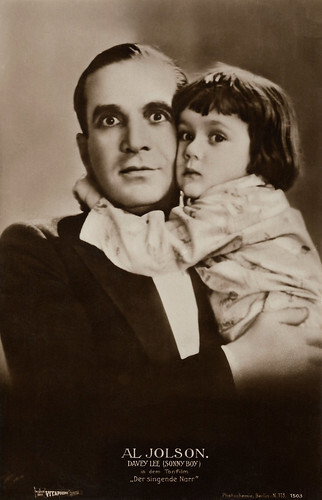
German postcard by Photochemie, Berlin, no. 1503. Photo: Warner Bros Vitaphone. Al Jolson and Davey Lee in The Singing Fool (Lloyd Bacon, 1928).
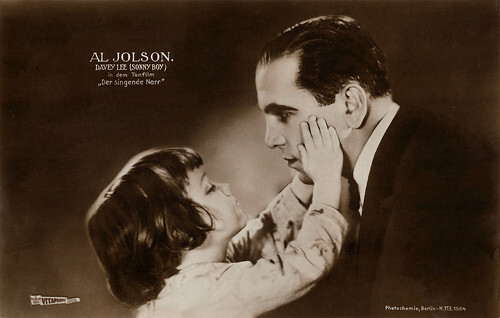
German postcard by Photochemie, Berlin, no. 1504. Photo: Warner Bros Vitaphone. Al Jolson and Davey Lee in The Singing Fool (Lloyd Bacon, 1928).
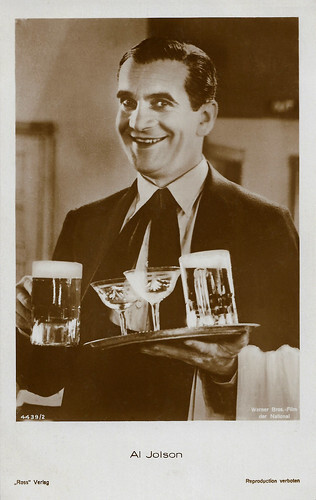
German postcard by Ross Verlag, no. 4439/2. Photo: Warner Bros. Film. Al Jolson in The Singing Fool (Lloyd Bacon, 1928), in which Jolson plays a singing waiter and wears the same outfit.
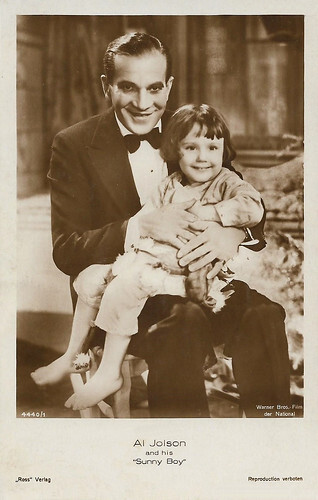
German postcard by Ross Verlag, no. 4440/1, 1929-1930. Photo: Warner Bros. / National. Al Jolson and his 'Sunny Boy' (Davey Lee) in The Singing Fool (Lloyd Bacon, 1928).
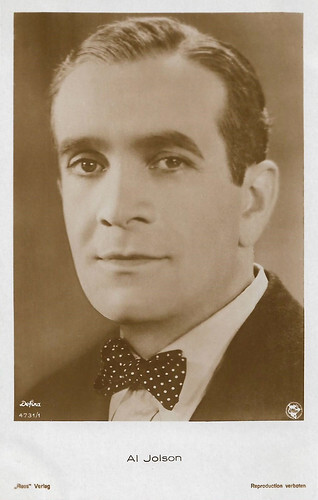
German postcard by Ross Verlag, no. 4731/1, 1929-1930. Photo: Defina / First National.
The one-knee performance
Al Jolson was born Asa Yoelson in 1886 in Seredžius (Srednik), Kovno Governorate, Russia, now Lithuania. He was the youngest son of a strictly religious Jewish cantor, Moise Rubin Yoelson, and his wife Naiomi Etta. To escape poverty and anti-Semitism, the family emigrated to the USA to Washington (D.C.) around 1894. Shortly after their arrival, his mother died after a short, violent illness.
When his father remarried soon afterwards, Jolson fled with his older brother, Harry, from the parental home to New York and made his way as a singer and shoeshine boy. He performed on various theatrical stages in mostly poor neighbourhoods and entertained the troops headed for the Spanish-American War. He also lived for some time on the streets and in an orphanage. He was signed eventually by Lew Dockstaders' Minstrels.
Joseph Ciolino at IMDb : "It is important to note that, although performing in blackface, Dockstader's was not a minstrel show in the traditional sense of the "Tambo and Bones" variety of the previous century. It was a sophisticated, topical, Broadway-style revue. The myth lingers to this day that Jolson was a minstrel. He most certainly was not."
He developed a stage-filling and audience-engaging gesture or interaction, especially playing with his eyes (eye-rolling and the like), artful whistling and an operatic singing style in a musical jazz context. Jolson's stay in vaudeville was relatively short. In 1911, Jolson was just 25, he made his breakthrough. Against the wishes of the producers, he expanded his part in the Broadway musical 'La Belle Parée', which had been intended as a supporting role, into a leading role.
His talent was quickly recognised by the Shubert Brothers, who signed him to appear in the opening show of their new Winter Garden Theater on Broadway in April of 1912. Thus began what many consider to be the greatest career in the history of Broadway. The audience loved his style and his performances. He appeared as a star in various Broadway shows until the mid-1920s. The sales of his records reached high figures for the time.
In 1920, Jolson recorded a song by 20-year-old George Gershwin: 'Swanee'. It immediately became a huge hit, giving the composer and singer great fame in America and Europe. One of his central musical trademarks emerged during the Vaudeville era: the "one-knee performance", in which Jolson knelt on one leg and sang 'My Mammy'. He later kept trying out different songs in which he sang about the figure of the mother. Al Jolson is best known for his performance in the film The Jazz Singer (Alan Crosland, 1927) with May McAvoy .
Film producer Jack L. Warner approached Jolson for the starring role in this - coincidentally - essentially autobiographical film. By not sticking to the script and improvising short, typical dialogues between the singing scenes against the wishes of the producers, Jolson paved the way for the talkies. For this reason, The Jazz Singer is considered the first commercially successful sound film ever. Jolson waived his fee for this film, which no one expected to be such a success because Warner Bros. was on the verge of bankruptcy.
Against all expectations, he earned almost one million US dollars from this film - and Warner Brothers was saved. Before that, Jolson had already had two other film offers one of which he realised, A Plantation Act (Philip Roscoe, 1926), a film in which Warner Bros. was already trying out the Vitaphone technique. He abandoned the other film in the middle of production because he found it hard to bear working with the camera instead of the audience and because he thought he looked like a zebra on the screen.
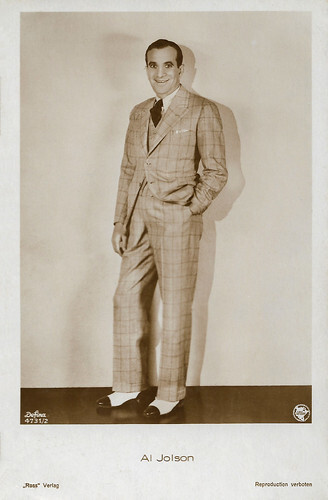
German postcard by Ross Verlag, no. 4731/2, 1929-1930. Photo: Defina / First National.
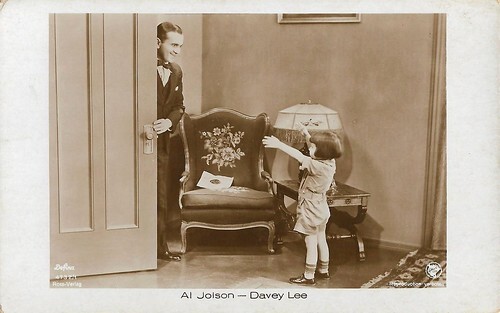
German postcard by Ross Verlag, no. 4732/1, 1929-1930. Photo: Defina / First National. Davey Lee and Al Jolson in Say It with Songs (Lloyd Bacon, 1929).
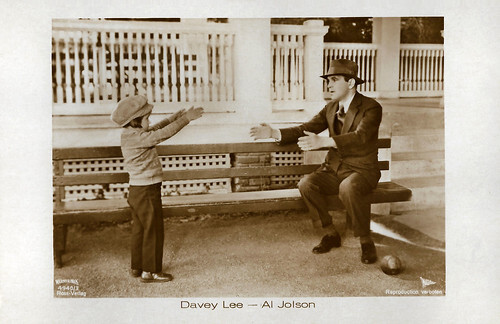
German postcard by Ross Verlag, no. 4940/3, 1929-1930. Photo: Warner Bros / National. Davey Lee and Al Jolson in Say It with Songs (Lloyd Bacon, 1929).
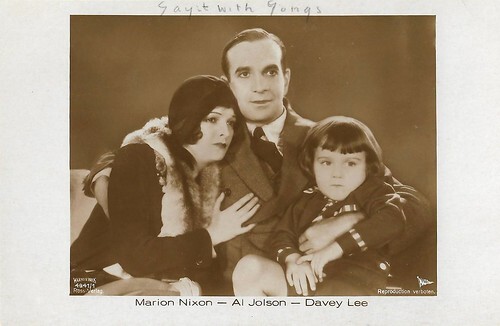
German postcard by Ross Verlag, no. 4941/1, 1929-1930. Photo: Warner Bros / National. Al Jolson, Marion Nixon and Davey Lee in Say It With Songs (Lloyd Bacon, 1929).
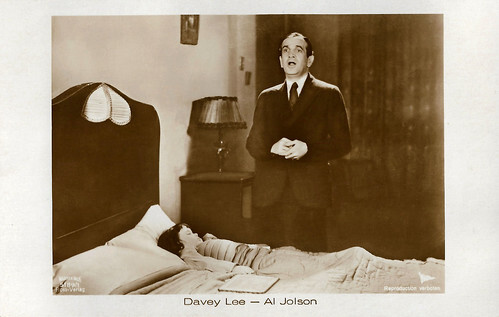
German postcard by Ross Verlag, no. 5189/1.1930-1931. Photo: Warner Bros / National. Al Jolson and Davey Lee in Say It with Songs (Lloyd Bacon, 1929). In his dreams, the boy sees and hears his father singing 'Little Pal' to him. The superimposition used in the film is absent on this card.
The most successful film ever until Gone with the Wind
A year after The Jazz Singer, Al Jolson made the film The Singing Fool (Lloyd Bacon, 1928) with Betty Bronson and Davey Lee, which broke the latter's records and remained the most successful film ever until Gone with the Wind (1939). In film terms, Jolson was now - after almost 20 successful Broadway years - at the peak of his career. He became an American institution, had contact with various presidents of the USA and occasionally dined at the White House.
After the success of The Jazz Singer, Jolson appeared in twelve more films, including Mammy (Michael Curtiz, 1930), Big Boy (Alan Crosland, 1930), and Hallelujah I'm a Bum (Lewis Milestone, 1933) with Madge Evans and Harry Langdon. His acting skills did not reach the quality he had as a live entertainer, yet most of his films were audience successes. His career on Broadway is unparalleled in length, nearly 30 years from 1911 to 1940, and in popularity.
Jolie, as he was called by his friends, was the first entertainer to sell a million records. However, Jolson on film was a pale version of Jolson on stage. His screen appearances, with some exceptions, are stiff and wooden. Audience tastes changed in the 1930s. Jolson's more classical singing was now seen as outdated and replaced by crooners. Younger musicians like Bing Crosby gradually became more successful. Jolson was already around 50.
After leaving Broadway, Al Jolson turned to radio appearances and appeared in various shows both as a host and guest. These were always in the top 10. When the USA went into World War II, Jolson was the first major entertainer to complete a huge musical tour in support of the troops, with Marlene Dietrich among others. Jolson was almost 60 years old at the time and pushed himself to his physical limits on this tour. Jolson made a tremendous comeback when Columbia Pictures made a biographical film about Jolson, The Jolson Story (Alfred E. Green, 1946).
In this film, Larry Parks played the role of Jolson, but the songs were sung by Jolson himself. It was the surprise smash hit of the season and the highest-grossing film of the year. Parks received an Academy Award nomination for Best Actor. Jolson was now as big, or bigger than ever. So successful was the film that Columbia made a sequel, Jolson Sings Again (Henry Levin, 1949), which remains one of a few biography sequels in film history. It led to a whole new generation being captivated by Jolson's voice and charisma.
His most successful radio show was Kraft Music Hall in the late 1940s. All the show stars of the time (from Bing Crosby and Cary Grant to Humphrey Bogart and Doris Day ) appeared on this show. The permanent partner in this show was the pianist, Oscar Levant. In 1948, Jolson was named the most popular male vocalist in a poll. He died in 1950 in San Francisco and is buried in the Slope Memorial Park Cemetery in Culver City, California.
On 23 October, the day he died, to honour him, the lights on Broadway were turned off for 10 minutes. Al Jolson was married four times, often neglecting his wives and launching serious rescue attempts only when it was too late. His first wife, Henrietta Keller, divorced him after almost twelve years (1907-1919). His second marriage to Ethel Delmar (1922-1926), ended with a flash divorce in Paris and Ethel's incarceration in an asylum for alcoholics.
With his third wife, the dancer and actress Ruby Keeler (1928-1939), Jolson adopted his first son Al Jolson Jr. He was unable to develop a close relationship with the boy, which pained the child-loving Jolson greatly. This period was marked by his declining star, and he was extremely jealous of his wife's success. They separated in 1939. It was not until his fourth marriage (1940-1950) to Erle Galbraith, a US military X-ray technician 39 years his junior, that he was happy, thanks in part to the grandiose fame of his last years and the fact that she was no professional competition for him. With her, he adopted another boy in 1948, whom they named Asa, and a girl named Alicia in 1950.
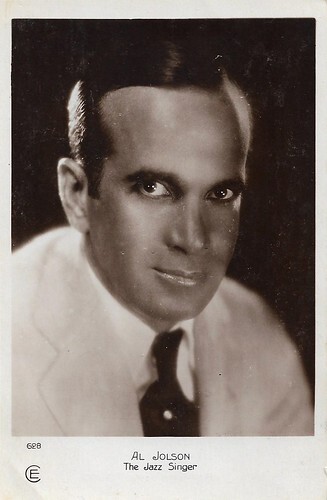
French postcard by Cinémagazine-Edition, no. 628. Al Jolson in the early sound film The Jazz Singer (Alan Crossland, 1927). Although the film had its American premiere in New York on 6 October 1927, its general American release was months after, in February 1928. The film came out in France in October 1929, according to IMDb.
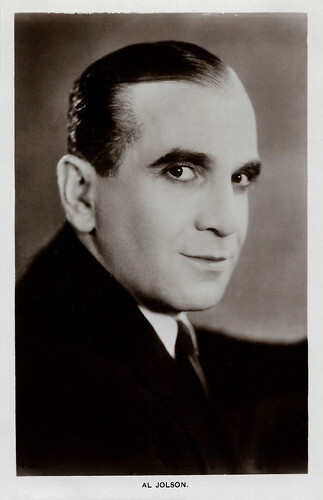
British postcard in the Picturegoer Series, London, no. 394.
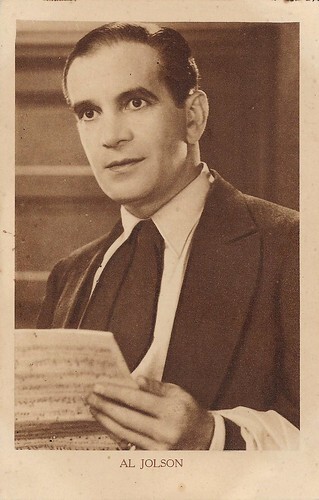
Belgian postcard by S. A. Cacao et Chocolat Kivou, Vilvorde/ N. V. Cacao en Chocolade Kivou, Vilvoorde. Probably for The Singing Fool (Lloyd Bacon, 1928) in which Jolson wears the same tie.
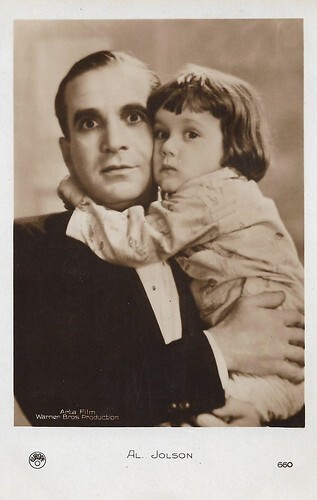
French postcard by Europe, no. 660. Photo: Arta Film. /Warner Bros. Production. Al Jolson and Davey Lee in The Singing Fool (Lloyd Bacon, 1928). In France, the film came out in December 1929.
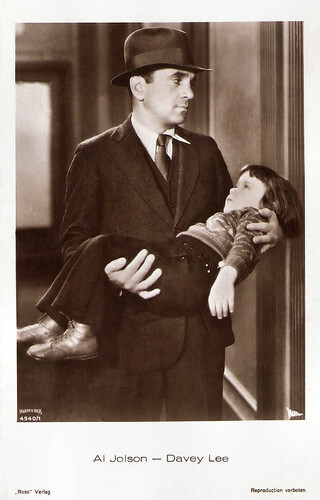
German postcard by Ross Verlag, no. 4940/1, 1929-1930. Photo: Warner Bros. / National. Al Jolson and Davey Lee in The Singing Fool (Lloyd Bacon, 1928).
Sources: (IMDb), Wikipedia (Dutch and German), and .

German postcard by Photochemie, Berlin, no. 1503. Photo: Warner Bros Vitaphone. Al Jolson and Davey Lee in The Singing Fool (Lloyd Bacon, 1928).

German postcard by Photochemie, Berlin, no. 1504. Photo: Warner Bros Vitaphone. Al Jolson and Davey Lee in The Singing Fool (Lloyd Bacon, 1928).

German postcard by Ross Verlag, no. 4439/2. Photo: Warner Bros. Film. Al Jolson in The Singing Fool (Lloyd Bacon, 1928), in which Jolson plays a singing waiter and wears the same outfit.

German postcard by Ross Verlag, no. 4440/1, 1929-1930. Photo: Warner Bros. / National. Al Jolson and his 'Sunny Boy' (Davey Lee) in The Singing Fool (Lloyd Bacon, 1928).

German postcard by Ross Verlag, no. 4731/1, 1929-1930. Photo: Defina / First National.
The one-knee performance
Al Jolson was born Asa Yoelson in 1886 in Seredžius (Srednik), Kovno Governorate, Russia, now Lithuania. He was the youngest son of a strictly religious Jewish cantor, Moise Rubin Yoelson, and his wife Naiomi Etta. To escape poverty and anti-Semitism, the family emigrated to the USA to Washington (D.C.) around 1894. Shortly after their arrival, his mother died after a short, violent illness.
When his father remarried soon afterwards, Jolson fled with his older brother, Harry, from the parental home to New York and made his way as a singer and shoeshine boy. He performed on various theatrical stages in mostly poor neighbourhoods and entertained the troops headed for the Spanish-American War. He also lived for some time on the streets and in an orphanage. He was signed eventually by Lew Dockstaders' Minstrels.
Joseph Ciolino at IMDb : "It is important to note that, although performing in blackface, Dockstader's was not a minstrel show in the traditional sense of the "Tambo and Bones" variety of the previous century. It was a sophisticated, topical, Broadway-style revue. The myth lingers to this day that Jolson was a minstrel. He most certainly was not."
He developed a stage-filling and audience-engaging gesture or interaction, especially playing with his eyes (eye-rolling and the like), artful whistling and an operatic singing style in a musical jazz context. Jolson's stay in vaudeville was relatively short. In 1911, Jolson was just 25, he made his breakthrough. Against the wishes of the producers, he expanded his part in the Broadway musical 'La Belle Parée', which had been intended as a supporting role, into a leading role.
His talent was quickly recognised by the Shubert Brothers, who signed him to appear in the opening show of their new Winter Garden Theater on Broadway in April of 1912. Thus began what many consider to be the greatest career in the history of Broadway. The audience loved his style and his performances. He appeared as a star in various Broadway shows until the mid-1920s. The sales of his records reached high figures for the time.
In 1920, Jolson recorded a song by 20-year-old George Gershwin: 'Swanee'. It immediately became a huge hit, giving the composer and singer great fame in America and Europe. One of his central musical trademarks emerged during the Vaudeville era: the "one-knee performance", in which Jolson knelt on one leg and sang 'My Mammy'. He later kept trying out different songs in which he sang about the figure of the mother. Al Jolson is best known for his performance in the film The Jazz Singer (Alan Crosland, 1927) with May McAvoy .
Film producer Jack L. Warner approached Jolson for the starring role in this - coincidentally - essentially autobiographical film. By not sticking to the script and improvising short, typical dialogues between the singing scenes against the wishes of the producers, Jolson paved the way for the talkies. For this reason, The Jazz Singer is considered the first commercially successful sound film ever. Jolson waived his fee for this film, which no one expected to be such a success because Warner Bros. was on the verge of bankruptcy.
Against all expectations, he earned almost one million US dollars from this film - and Warner Brothers was saved. Before that, Jolson had already had two other film offers one of which he realised, A Plantation Act (Philip Roscoe, 1926), a film in which Warner Bros. was already trying out the Vitaphone technique. He abandoned the other film in the middle of production because he found it hard to bear working with the camera instead of the audience and because he thought he looked like a zebra on the screen.

German postcard by Ross Verlag, no. 4731/2, 1929-1930. Photo: Defina / First National.

German postcard by Ross Verlag, no. 4732/1, 1929-1930. Photo: Defina / First National. Davey Lee and Al Jolson in Say It with Songs (Lloyd Bacon, 1929).

German postcard by Ross Verlag, no. 4940/3, 1929-1930. Photo: Warner Bros / National. Davey Lee and Al Jolson in Say It with Songs (Lloyd Bacon, 1929).

German postcard by Ross Verlag, no. 4941/1, 1929-1930. Photo: Warner Bros / National. Al Jolson, Marion Nixon and Davey Lee in Say It With Songs (Lloyd Bacon, 1929).

German postcard by Ross Verlag, no. 5189/1.1930-1931. Photo: Warner Bros / National. Al Jolson and Davey Lee in Say It with Songs (Lloyd Bacon, 1929). In his dreams, the boy sees and hears his father singing 'Little Pal' to him. The superimposition used in the film is absent on this card.
The most successful film ever until Gone with the Wind
A year after The Jazz Singer, Al Jolson made the film The Singing Fool (Lloyd Bacon, 1928) with Betty Bronson and Davey Lee, which broke the latter's records and remained the most successful film ever until Gone with the Wind (1939). In film terms, Jolson was now - after almost 20 successful Broadway years - at the peak of his career. He became an American institution, had contact with various presidents of the USA and occasionally dined at the White House.
After the success of The Jazz Singer, Jolson appeared in twelve more films, including Mammy (Michael Curtiz, 1930), Big Boy (Alan Crosland, 1930), and Hallelujah I'm a Bum (Lewis Milestone, 1933) with Madge Evans and Harry Langdon. His acting skills did not reach the quality he had as a live entertainer, yet most of his films were audience successes. His career on Broadway is unparalleled in length, nearly 30 years from 1911 to 1940, and in popularity.
Jolie, as he was called by his friends, was the first entertainer to sell a million records. However, Jolson on film was a pale version of Jolson on stage. His screen appearances, with some exceptions, are stiff and wooden. Audience tastes changed in the 1930s. Jolson's more classical singing was now seen as outdated and replaced by crooners. Younger musicians like Bing Crosby gradually became more successful. Jolson was already around 50.
After leaving Broadway, Al Jolson turned to radio appearances and appeared in various shows both as a host and guest. These were always in the top 10. When the USA went into World War II, Jolson was the first major entertainer to complete a huge musical tour in support of the troops, with Marlene Dietrich among others. Jolson was almost 60 years old at the time and pushed himself to his physical limits on this tour. Jolson made a tremendous comeback when Columbia Pictures made a biographical film about Jolson, The Jolson Story (Alfred E. Green, 1946).
In this film, Larry Parks played the role of Jolson, but the songs were sung by Jolson himself. It was the surprise smash hit of the season and the highest-grossing film of the year. Parks received an Academy Award nomination for Best Actor. Jolson was now as big, or bigger than ever. So successful was the film that Columbia made a sequel, Jolson Sings Again (Henry Levin, 1949), which remains one of a few biography sequels in film history. It led to a whole new generation being captivated by Jolson's voice and charisma.
His most successful radio show was Kraft Music Hall in the late 1940s. All the show stars of the time (from Bing Crosby and Cary Grant to Humphrey Bogart and Doris Day ) appeared on this show. The permanent partner in this show was the pianist, Oscar Levant. In 1948, Jolson was named the most popular male vocalist in a poll. He died in 1950 in San Francisco and is buried in the Slope Memorial Park Cemetery in Culver City, California.
On 23 October, the day he died, to honour him, the lights on Broadway were turned off for 10 minutes. Al Jolson was married four times, often neglecting his wives and launching serious rescue attempts only when it was too late. His first wife, Henrietta Keller, divorced him after almost twelve years (1907-1919). His second marriage to Ethel Delmar (1922-1926), ended with a flash divorce in Paris and Ethel's incarceration in an asylum for alcoholics.
With his third wife, the dancer and actress Ruby Keeler (1928-1939), Jolson adopted his first son Al Jolson Jr. He was unable to develop a close relationship with the boy, which pained the child-loving Jolson greatly. This period was marked by his declining star, and he was extremely jealous of his wife's success. They separated in 1939. It was not until his fourth marriage (1940-1950) to Erle Galbraith, a US military X-ray technician 39 years his junior, that he was happy, thanks in part to the grandiose fame of his last years and the fact that she was no professional competition for him. With her, he adopted another boy in 1948, whom they named Asa, and a girl named Alicia in 1950.

French postcard by Cinémagazine-Edition, no. 628. Al Jolson in the early sound film The Jazz Singer (Alan Crossland, 1927). Although the film had its American premiere in New York on 6 October 1927, its general American release was months after, in February 1928. The film came out in France in October 1929, according to IMDb.

British postcard in the Picturegoer Series, London, no. 394.

Belgian postcard by S. A. Cacao et Chocolat Kivou, Vilvorde/ N. V. Cacao en Chocolade Kivou, Vilvoorde. Probably for The Singing Fool (Lloyd Bacon, 1928) in which Jolson wears the same tie.

French postcard by Europe, no. 660. Photo: Arta Film. /Warner Bros. Production. Al Jolson and Davey Lee in The Singing Fool (Lloyd Bacon, 1928). In France, the film came out in December 1929.

German postcard by Ross Verlag, no. 4940/1, 1929-1930. Photo: Warner Bros. / National. Al Jolson and Davey Lee in The Singing Fool (Lloyd Bacon, 1928).
Sources: (IMDb), Wikipedia (Dutch and German), and .
Published on November 10, 2022 22:00
November 9, 2022
Photo by Lucienne Chevert
Paris-based photographer Lucienne Chevert (1911-1982) portrayed dozens of French stars of the post-war period. She was the associate of the famous photographer Sam Lévin.
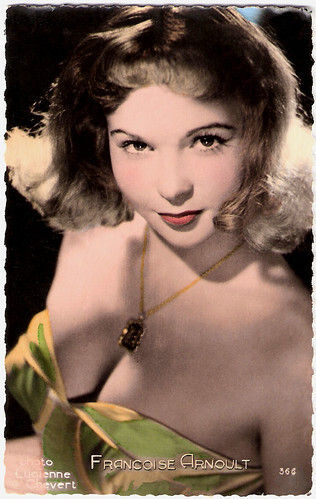
Françoise Arnoul . French postcard by Editions P.I., Paris, no. 366. Photo: Lucienne Chevert.
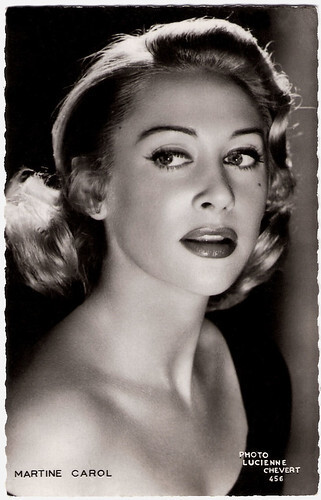
Martine Carol . French postcard by Editions P.I., no. 210 H. Photo: Lucienne Chevert, no. 456.
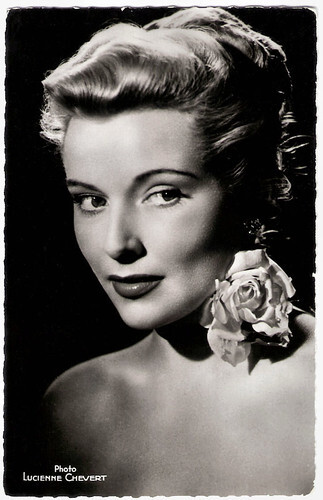
Danielle Godet . French postcard by Editions du Globe, Paris, no. 345 (E.D.U.G.). Photo: Lucienne Chevert.
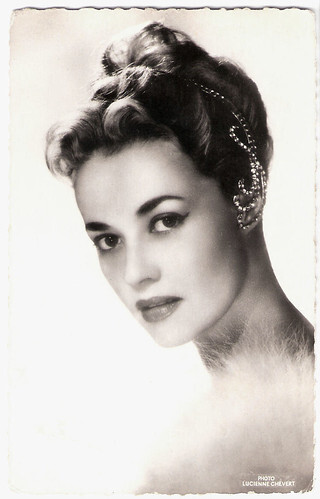
Jeanne Moreau . French postcard by Editions du Globe (E.D.U.G.), no. 620. Photo: Lucienne Chevert.
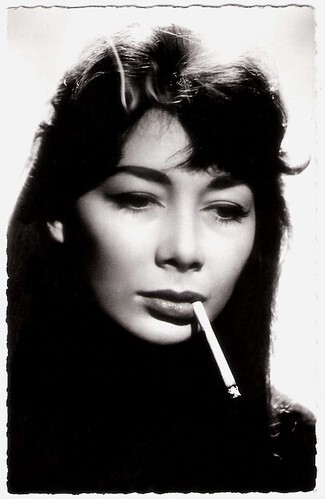
Juliette Gréco . French postcard by Editions du Globe, Paris, no. 623. Photo: Lucienne Chevert.
Assistant and associate
Lucienne Chevert was born in 1911.
In 1934, upcoming photographer Sam Lévin started his own photo studio in his home, an apartment on rue Saint-Georges in Paris. He transformed the living room into a shooting studio where he received his models, whom he first met on film sets. Very quickly, he was joined by the young Lucienne Chevert who became his assistant. Chevert was only 22 or 23 at the time, but their cooperation at this portrait studio would continue till her death in 1982.
Although Lévin was married to another woman, their professional association obviously worked. Matthieu Rivallin, curator of a 2022 exhibition in La Maison/Nevers, describes the work of Studio Levin as a "four-handed photograph". He found it so difficult to distinguish the work of Sam Lévin from that of Lucienne Chevert, in a production of more than 250,000 shots. For almost fifty years, they achieved an almost common career.
In 1935 Sam Lévin was asked to replace a sick photographer on a film set. This proved to be a great start for a career as a set photographer for both him and Chevert. In 1937, the Studio Lévin moved to rue du Faubourg-Saint-Honoré. While Sam Lévin , on file with the National Security as a foreigner and a Jew, took refuge in the southern zone, in 1942, in order to avoid the spoliation of the Parisian business, Lucienne Chevert took over the studio in rue du Faubourg-Saint - honoured in her name.
Chevert is first credited as a set photographer for Dernier atout/The last ace (Jacques Becker, 1942) starring Mireille Balin and Raymond Rouleau. Reportedly a mediocre crime film. Until the end of the war, she was to sign the set photographs of a dozen films such as Sortilèges (Christian-Jaque, 1944), Boule de suif (Christian-Jaque, 1945) with Micheline Presle , and Adieu chérie/Goodbye Darling (Raymond Bernard, 1945) with Danielle Darrieux .
Matthieu Rivallin: "The Studio Lévin portrait of the late 1930s is above all based on a technique, a sophisticated lighting scheme from the film sets where Sam Lévin and Lucienne Chevert began and then regularly operated. The aesthetics of their photographs then presented many similarities with the films of the time: a subtle harmony of shadows and light; faces enhanced by soft shades of black and white; bodies modelled using diffuse atmospheres, luminous touches, dark or radiant backgrounds."
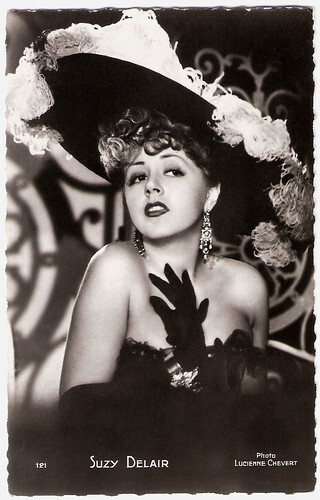
French postcard by Editions P.I., offered by Les Carbones Korès, no. 121. Photo: Lucienne Chevert. Suzy Delair in Quai des Orfèvres (Henri-Georges Clouzot, 1947).
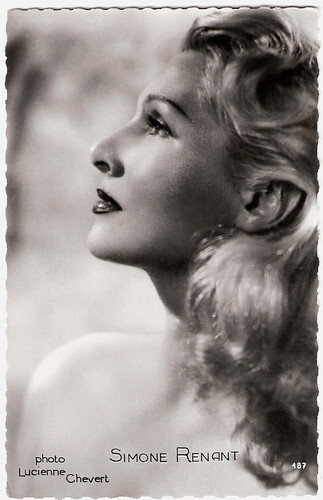
Simone Renant . French postcard by Edit. P.I., offered by Les Carbones Korès, no. 186. Photo: Lucienne Chevert.
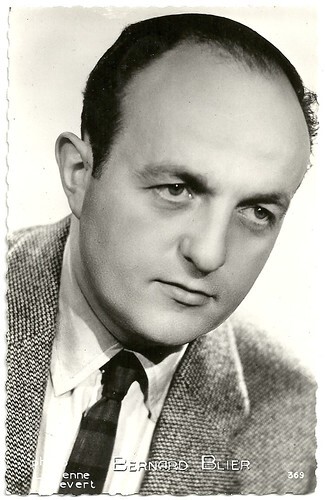
Bernard Blier . French postcard by Editions P.I., Paris, no. 369. Offered by Les Carbones Korès. Photo: Lucienne Chevert.
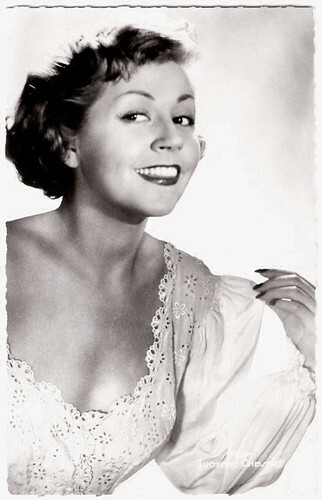
Suzy Delair . French postcard by Editions du Globe, Paris, no. 128. Photo: Lucienne Chevert.
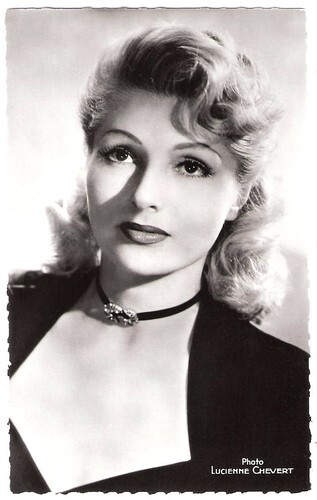
Simone Renant . French postcard by Editions du Globe, no. 153. Photo: Lucienne Chevert.
Lesbian photographer
At the Liberation, the workshop grew, adding a photo library and a laboratory to the studio. A lounge was set up to welcome actors, singers and models who came to entrust their image to what became one of the most famous studios in the capital. In 1948, the studio signed a contract with Unifrance and became their main supplier of images. Unifrance-Film aimed to promote French cinema abroad, both films and professionals, actors or directors.
Very successful was Lucienne Chevert's cooperation with famous film director Henri-Georges Clouzot. It started with Quai des Orfèvres/Quay of the Goldsmiths (Henri-Georges Clouzot, 1947) for which she made beautiful star portraits of Louis Jouvet , Bernard Blier , Suzy Delair and Simone Renant .
Renant plays the photographer Dora, who works for the artists of the music halls and nightclubs. One of her clients is her neighbour, the singer Jenny Lamour (Delair). It's clear by the way Dora interacts with Jenny that she is a lesbian and thus Dora is one of the first gay characters in the cinema. Chevert of course made Dora's beautiful photos of Jenny Lamour, who were also used in the publicity for the film. Quai des Orfèvres is an excellent Film Noir with crisp black and white cinematography by Armand Thirard. Chevert gave her stills the same atmosphere. They are now popular items at auctions.
Next, Lucienne Chevert made the stills for the comedy Antoine et Antoinette/Antoine and Antoinette (Jacques Becker, 1947) and Le dessous des cartes/Under the Cards (André Cayatte, 1948) starring Madeleine Sologne .
Her definitive breakthrough came with her work for the classic La salaire de la peur/The wages of fear (Henri-Georges Clouzot, 1952) with Yves Montand . La salaire de la peur is a painfully riveting suspense thriller about a suicidally dangerous mission involving trucks and nitroglycerine.
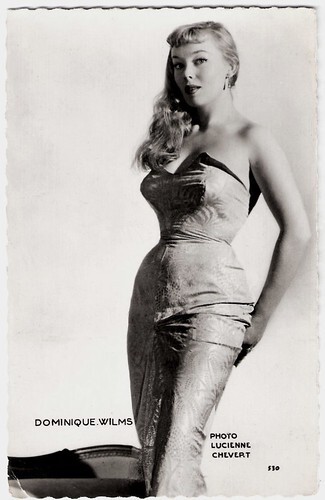
Dominique Wilms . French postcard by Editions P.I., Paris, no. 28G. Photo: Lucienne Chevert.
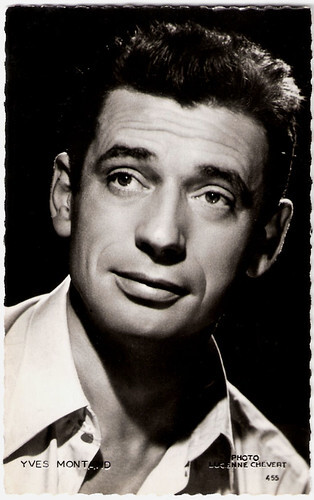
Yves Montand . French postcard by Editions P.I., Paris, no. 455. Photo: Lucienne Chevert.
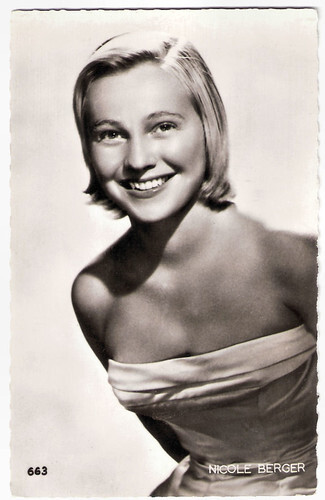
Nicole Berger . French postcard by Editions P.I., Paris, no. 663. Photo:Lucienne Chevert.
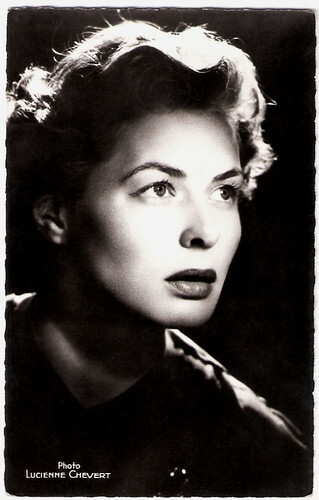
Ingrid Bergman . French postcard by Editions du Globe, Paris, no. 198. Photo: Lucienne Chevert.
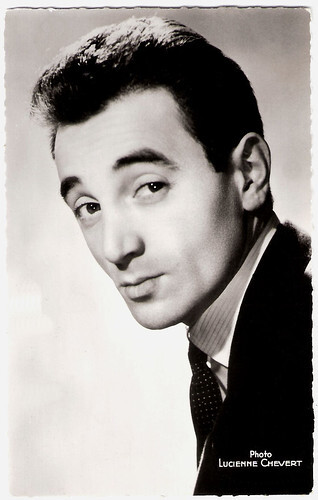
Charles Aznavour . French postcard by Editions du Globe, Paris, no. 430. Photo: Lucienne Chevert.
Beautiful and sexy Stars
Lucienne Chevert is now remembered for her set photography but also for her film star portraits. For twenty years, all those who mattered paraded under the lights of 3 rue du Faubourg-Saint-Honoré. Chevert became one of the most famous celebrity photographers in France and her glamorous portraits of film French actors and especially actresses graced thousands of European film star postcards.
In the intimacy of their beautifully decorated studio and thanks to her friendly character and personal interest, many film stars felt at ease. Her portraits of beautiful and sexy stars such as Martine Carol and Françoise Arnoul are exquisite.
She made portraits of many stars of the French cinema of the 1950s, including Charles Aznavour , Eddie Constantine and Yves Montand . International stars like Ingrid Bergman and Nadja Tiller also posed for her camera.
Chevert photographed the faces of the Nouvelle Vague, like Jean-Paul Belmondo and Jeanne Moreau . Her colour portraits at that time are still fresh and cheerful. And in 1965, she returned to set photography for Agnes Varda’s classic Le Bonheur (1965). Le Bonheur was one of her last known professional activities. Lucienne Chevert died in 1982.
Matthieu Rivallin: " Sam Lévin and Lucienne Chevert were recognised for their talent very early on, but this did not mean that they were making art. The image to be produced was first and foremost a market affair and their know-how necessarily adapted to a command and to its uses. There was still photography, fashion photography, advertising photography and above all, there is portraiture. (...) The portrait was a promotional article, it played the intermediary between the illustrious figure and his audience, between the idol and his groupies."
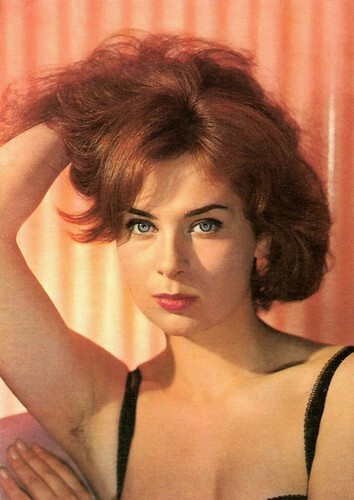
Juliette Mayniel . French postcard by E.D.U.G. (Editions du Globe), no. 45. Photo: Lucienne Chevert.
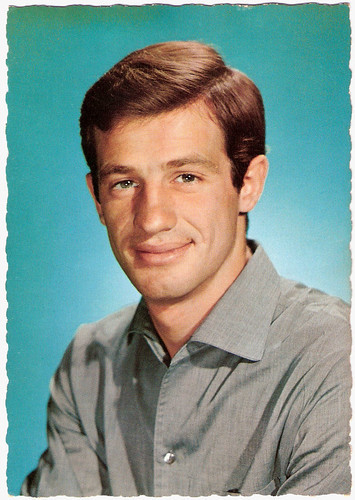
Jean-Paul Belmondo . French postcard by E.D.U.G., no. 77. Photo: Lucienne Chevert.
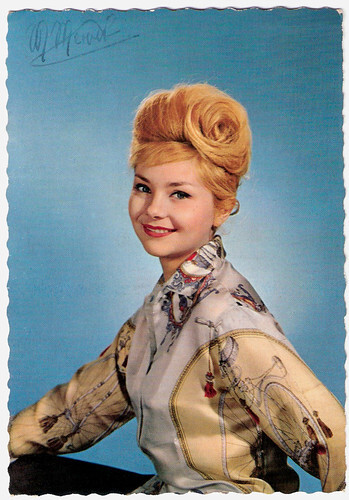
Macha Méril . French postcard by E.D.U.G., no. 88. Photo: Lucienne Chevert.
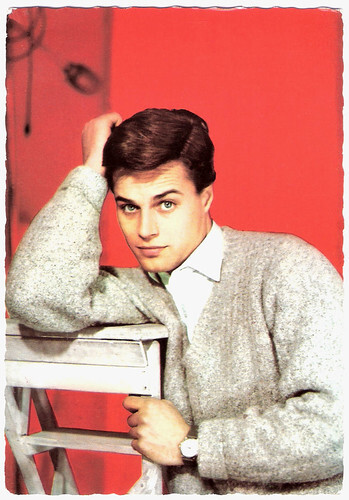
Jean Sorel . French postcard by E.D.U.G., no. 143. Photo: Lucienne Chevert.
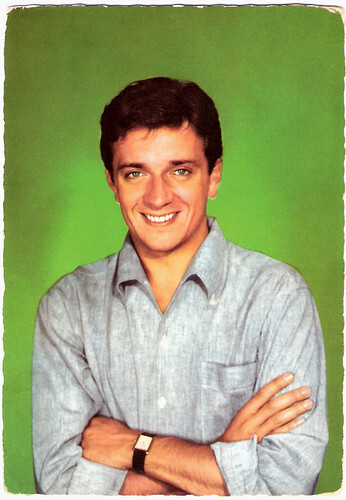
Jean-Pierre Cassel . French postcard by E.D.U.G., no. 150. Photo: Lucienne Chevert.
An earlier version of this post was in 2014 the ninth post in a series on film star photographers. Earlier posts were on the Reutlinger Studio in Paris, Italian star photographer Attilio Badodi, the German photographer Ernst Schneider, Dutch photo artist Godfried de Groot, Milanese photographers Arturo Varischi and Giovanni Artico, the French Studio Lorelle, the British 'royal' photographer Dorothy Wilding, and Berlin duo Becker & Maass.
And for more postcards with photos by Lucienne Chevert, check out our Flickr album.
Sources: Mathieu Rivallin (The Eye of Photography), UniFrance Films, Wikipedia, and .

Françoise Arnoul . French postcard by Editions P.I., Paris, no. 366. Photo: Lucienne Chevert.

Martine Carol . French postcard by Editions P.I., no. 210 H. Photo: Lucienne Chevert, no. 456.

Danielle Godet . French postcard by Editions du Globe, Paris, no. 345 (E.D.U.G.). Photo: Lucienne Chevert.

Jeanne Moreau . French postcard by Editions du Globe (E.D.U.G.), no. 620. Photo: Lucienne Chevert.

Juliette Gréco . French postcard by Editions du Globe, Paris, no. 623. Photo: Lucienne Chevert.
Assistant and associate
Lucienne Chevert was born in 1911.
In 1934, upcoming photographer Sam Lévin started his own photo studio in his home, an apartment on rue Saint-Georges in Paris. He transformed the living room into a shooting studio where he received his models, whom he first met on film sets. Very quickly, he was joined by the young Lucienne Chevert who became his assistant. Chevert was only 22 or 23 at the time, but their cooperation at this portrait studio would continue till her death in 1982.
Although Lévin was married to another woman, their professional association obviously worked. Matthieu Rivallin, curator of a 2022 exhibition in La Maison/Nevers, describes the work of Studio Levin as a "four-handed photograph". He found it so difficult to distinguish the work of Sam Lévin from that of Lucienne Chevert, in a production of more than 250,000 shots. For almost fifty years, they achieved an almost common career.
In 1935 Sam Lévin was asked to replace a sick photographer on a film set. This proved to be a great start for a career as a set photographer for both him and Chevert. In 1937, the Studio Lévin moved to rue du Faubourg-Saint-Honoré. While Sam Lévin , on file with the National Security as a foreigner and a Jew, took refuge in the southern zone, in 1942, in order to avoid the spoliation of the Parisian business, Lucienne Chevert took over the studio in rue du Faubourg-Saint - honoured in her name.
Chevert is first credited as a set photographer for Dernier atout/The last ace (Jacques Becker, 1942) starring Mireille Balin and Raymond Rouleau. Reportedly a mediocre crime film. Until the end of the war, she was to sign the set photographs of a dozen films such as Sortilèges (Christian-Jaque, 1944), Boule de suif (Christian-Jaque, 1945) with Micheline Presle , and Adieu chérie/Goodbye Darling (Raymond Bernard, 1945) with Danielle Darrieux .
Matthieu Rivallin: "The Studio Lévin portrait of the late 1930s is above all based on a technique, a sophisticated lighting scheme from the film sets where Sam Lévin and Lucienne Chevert began and then regularly operated. The aesthetics of their photographs then presented many similarities with the films of the time: a subtle harmony of shadows and light; faces enhanced by soft shades of black and white; bodies modelled using diffuse atmospheres, luminous touches, dark or radiant backgrounds."

French postcard by Editions P.I., offered by Les Carbones Korès, no. 121. Photo: Lucienne Chevert. Suzy Delair in Quai des Orfèvres (Henri-Georges Clouzot, 1947).

Simone Renant . French postcard by Edit. P.I., offered by Les Carbones Korès, no. 186. Photo: Lucienne Chevert.

Bernard Blier . French postcard by Editions P.I., Paris, no. 369. Offered by Les Carbones Korès. Photo: Lucienne Chevert.

Suzy Delair . French postcard by Editions du Globe, Paris, no. 128. Photo: Lucienne Chevert.

Simone Renant . French postcard by Editions du Globe, no. 153. Photo: Lucienne Chevert.
Lesbian photographer
At the Liberation, the workshop grew, adding a photo library and a laboratory to the studio. A lounge was set up to welcome actors, singers and models who came to entrust their image to what became one of the most famous studios in the capital. In 1948, the studio signed a contract with Unifrance and became their main supplier of images. Unifrance-Film aimed to promote French cinema abroad, both films and professionals, actors or directors.
Very successful was Lucienne Chevert's cooperation with famous film director Henri-Georges Clouzot. It started with Quai des Orfèvres/Quay of the Goldsmiths (Henri-Georges Clouzot, 1947) for which she made beautiful star portraits of Louis Jouvet , Bernard Blier , Suzy Delair and Simone Renant .
Renant plays the photographer Dora, who works for the artists of the music halls and nightclubs. One of her clients is her neighbour, the singer Jenny Lamour (Delair). It's clear by the way Dora interacts with Jenny that she is a lesbian and thus Dora is one of the first gay characters in the cinema. Chevert of course made Dora's beautiful photos of Jenny Lamour, who were also used in the publicity for the film. Quai des Orfèvres is an excellent Film Noir with crisp black and white cinematography by Armand Thirard. Chevert gave her stills the same atmosphere. They are now popular items at auctions.
Next, Lucienne Chevert made the stills for the comedy Antoine et Antoinette/Antoine and Antoinette (Jacques Becker, 1947) and Le dessous des cartes/Under the Cards (André Cayatte, 1948) starring Madeleine Sologne .
Her definitive breakthrough came with her work for the classic La salaire de la peur/The wages of fear (Henri-Georges Clouzot, 1952) with Yves Montand . La salaire de la peur is a painfully riveting suspense thriller about a suicidally dangerous mission involving trucks and nitroglycerine.

Dominique Wilms . French postcard by Editions P.I., Paris, no. 28G. Photo: Lucienne Chevert.

Yves Montand . French postcard by Editions P.I., Paris, no. 455. Photo: Lucienne Chevert.

Nicole Berger . French postcard by Editions P.I., Paris, no. 663. Photo:Lucienne Chevert.

Ingrid Bergman . French postcard by Editions du Globe, Paris, no. 198. Photo: Lucienne Chevert.

Charles Aznavour . French postcard by Editions du Globe, Paris, no. 430. Photo: Lucienne Chevert.
Beautiful and sexy Stars
Lucienne Chevert is now remembered for her set photography but also for her film star portraits. For twenty years, all those who mattered paraded under the lights of 3 rue du Faubourg-Saint-Honoré. Chevert became one of the most famous celebrity photographers in France and her glamorous portraits of film French actors and especially actresses graced thousands of European film star postcards.
In the intimacy of their beautifully decorated studio and thanks to her friendly character and personal interest, many film stars felt at ease. Her portraits of beautiful and sexy stars such as Martine Carol and Françoise Arnoul are exquisite.
She made portraits of many stars of the French cinema of the 1950s, including Charles Aznavour , Eddie Constantine and Yves Montand . International stars like Ingrid Bergman and Nadja Tiller also posed for her camera.
Chevert photographed the faces of the Nouvelle Vague, like Jean-Paul Belmondo and Jeanne Moreau . Her colour portraits at that time are still fresh and cheerful. And in 1965, she returned to set photography for Agnes Varda’s classic Le Bonheur (1965). Le Bonheur was one of her last known professional activities. Lucienne Chevert died in 1982.
Matthieu Rivallin: " Sam Lévin and Lucienne Chevert were recognised for their talent very early on, but this did not mean that they were making art. The image to be produced was first and foremost a market affair and their know-how necessarily adapted to a command and to its uses. There was still photography, fashion photography, advertising photography and above all, there is portraiture. (...) The portrait was a promotional article, it played the intermediary between the illustrious figure and his audience, between the idol and his groupies."

Juliette Mayniel . French postcard by E.D.U.G. (Editions du Globe), no. 45. Photo: Lucienne Chevert.

Jean-Paul Belmondo . French postcard by E.D.U.G., no. 77. Photo: Lucienne Chevert.

Macha Méril . French postcard by E.D.U.G., no. 88. Photo: Lucienne Chevert.

Jean Sorel . French postcard by E.D.U.G., no. 143. Photo: Lucienne Chevert.

Jean-Pierre Cassel . French postcard by E.D.U.G., no. 150. Photo: Lucienne Chevert.
An earlier version of this post was in 2014 the ninth post in a series on film star photographers. Earlier posts were on the Reutlinger Studio in Paris, Italian star photographer Attilio Badodi, the German photographer Ernst Schneider, Dutch photo artist Godfried de Groot, Milanese photographers Arturo Varischi and Giovanni Artico, the French Studio Lorelle, the British 'royal' photographer Dorothy Wilding, and Berlin duo Becker & Maass.
And for more postcards with photos by Lucienne Chevert, check out our Flickr album.
Sources: Mathieu Rivallin (The Eye of Photography), UniFrance Films, Wikipedia, and .
Published on November 09, 2022 22:00
Paul van Yperen's Blog
- Paul van Yperen's profile
- 13 followers
Paul van Yperen isn't a Goodreads Author
(yet),
but they
do have a blog,
so here are some recent posts imported from
their feed.



